Analysis of Construction Industry Practices
VerifiedAdded on 2020/10/05
|36
|12694
|362
AI Summary
This assignment involves an in-depth examination of the construction industry, focusing on contractual procedures, financial management, and dispute resolution methods. It requires a thorough review of existing literature, including academic papers and research studies, to provide insights into best practices in the industry. The assignment also includes a questionnaire for respondents to share their experiences with joint ventures, adjudication, and informal dispute resolution methods.
Contribute Materials
Your contribution can guide someone’s learning journey. Share your
documents today.
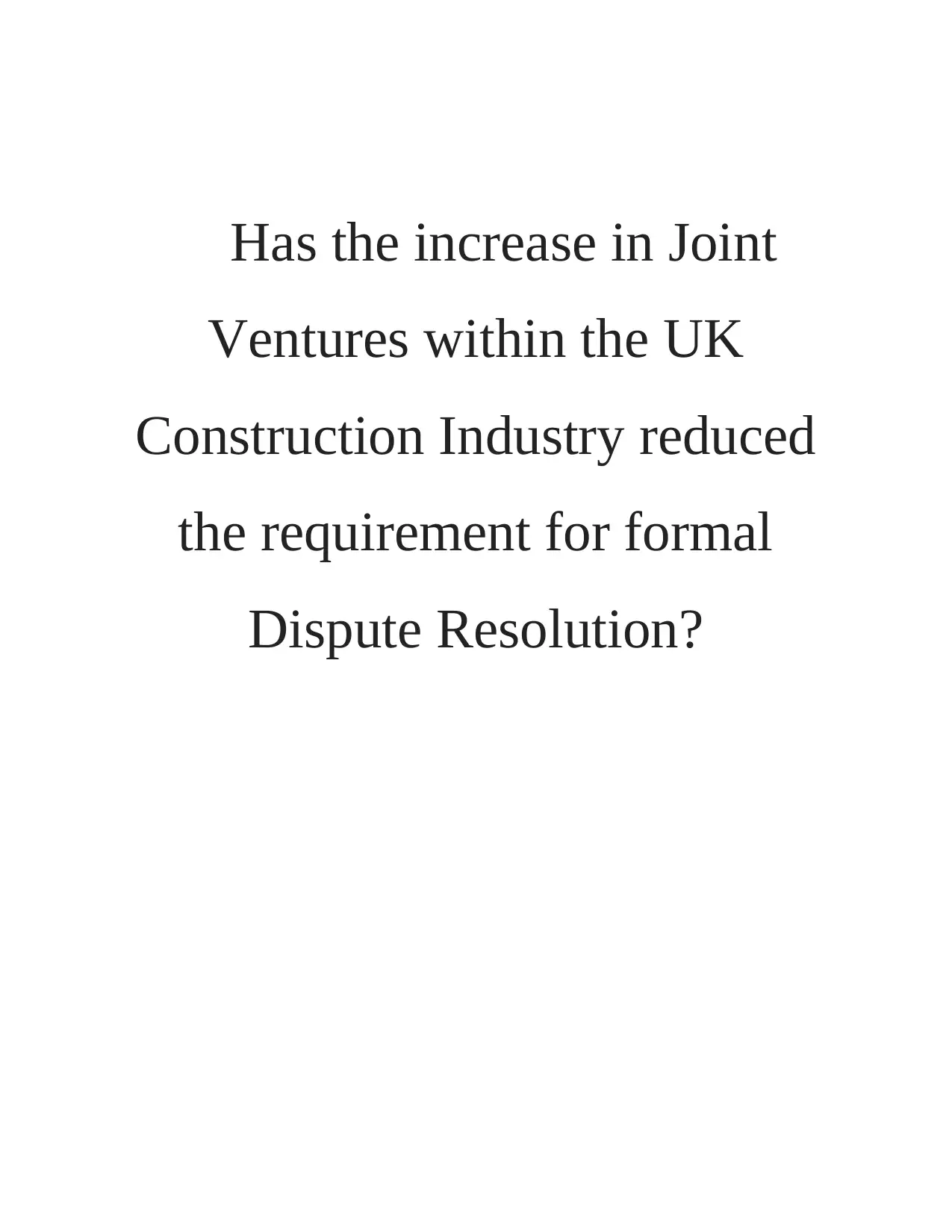
Has the increase in Joint
Ventures within the UK
Construction Industry reduced
the requirement for formal
Dispute Resolution?
Ventures within the UK
Construction Industry reduced
the requirement for formal
Dispute Resolution?
Secure Best Marks with AI Grader
Need help grading? Try our AI Grader for instant feedback on your assignments.
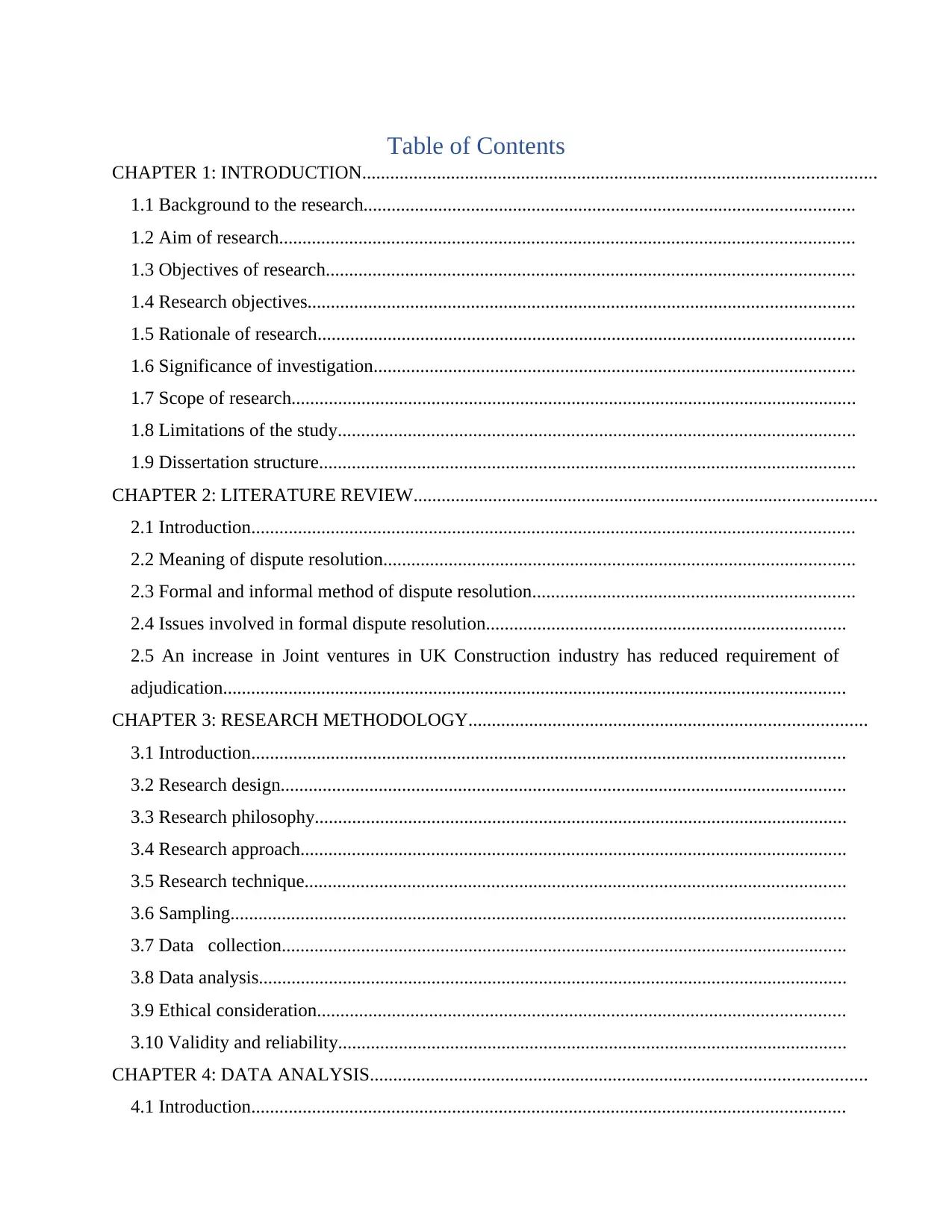
Table of Contents
CHAPTER 1: INTRODUCTION..............................................................................................................
1.1 Background to the research.........................................................................................................
1.2 Aim of research...........................................................................................................................
1.3 Objectives of research.................................................................................................................
1.4 Research objectives.....................................................................................................................
1.5 Rationale of research...................................................................................................................
1.6 Significance of investigation.......................................................................................................
1.7 Scope of research.........................................................................................................................
1.8 Limitations of the study...............................................................................................................
1.9 Dissertation structure...................................................................................................................
CHAPTER 2: LITERATURE REVIEW...................................................................................................
2.1 Introduction.................................................................................................................................
2.2 Meaning of dispute resolution.....................................................................................................
2.3 Formal and informal method of dispute resolution.....................................................................
2.4 Issues involved in formal dispute resolution.............................................................................
2.5 An increase in Joint ventures in UK Construction industry has reduced requirement of
adjudication.....................................................................................................................................
CHAPTER 3: RESEARCH METHODOLOGY.....................................................................................
3.1 Introduction...............................................................................................................................
3.2 Research design.........................................................................................................................
3.3 Research philosophy..................................................................................................................
3.4 Research approach.....................................................................................................................
3.5 Research technique....................................................................................................................
3.6 Sampling....................................................................................................................................
3.7 Data collection.........................................................................................................................
3.8 Data analysis..............................................................................................................................
3.9 Ethical consideration.................................................................................................................
3.10 Validity and reliability.............................................................................................................
CHAPTER 4: DATA ANALYSIS..........................................................................................................
4.1 Introduction...............................................................................................................................
CHAPTER 1: INTRODUCTION..............................................................................................................
1.1 Background to the research.........................................................................................................
1.2 Aim of research...........................................................................................................................
1.3 Objectives of research.................................................................................................................
1.4 Research objectives.....................................................................................................................
1.5 Rationale of research...................................................................................................................
1.6 Significance of investigation.......................................................................................................
1.7 Scope of research.........................................................................................................................
1.8 Limitations of the study...............................................................................................................
1.9 Dissertation structure...................................................................................................................
CHAPTER 2: LITERATURE REVIEW...................................................................................................
2.1 Introduction.................................................................................................................................
2.2 Meaning of dispute resolution.....................................................................................................
2.3 Formal and informal method of dispute resolution.....................................................................
2.4 Issues involved in formal dispute resolution.............................................................................
2.5 An increase in Joint ventures in UK Construction industry has reduced requirement of
adjudication.....................................................................................................................................
CHAPTER 3: RESEARCH METHODOLOGY.....................................................................................
3.1 Introduction...............................................................................................................................
3.2 Research design.........................................................................................................................
3.3 Research philosophy..................................................................................................................
3.4 Research approach.....................................................................................................................
3.5 Research technique....................................................................................................................
3.6 Sampling....................................................................................................................................
3.7 Data collection.........................................................................................................................
3.8 Data analysis..............................................................................................................................
3.9 Ethical consideration.................................................................................................................
3.10 Validity and reliability.............................................................................................................
CHAPTER 4: DATA ANALYSIS..........................................................................................................
4.1 Introduction...............................................................................................................................
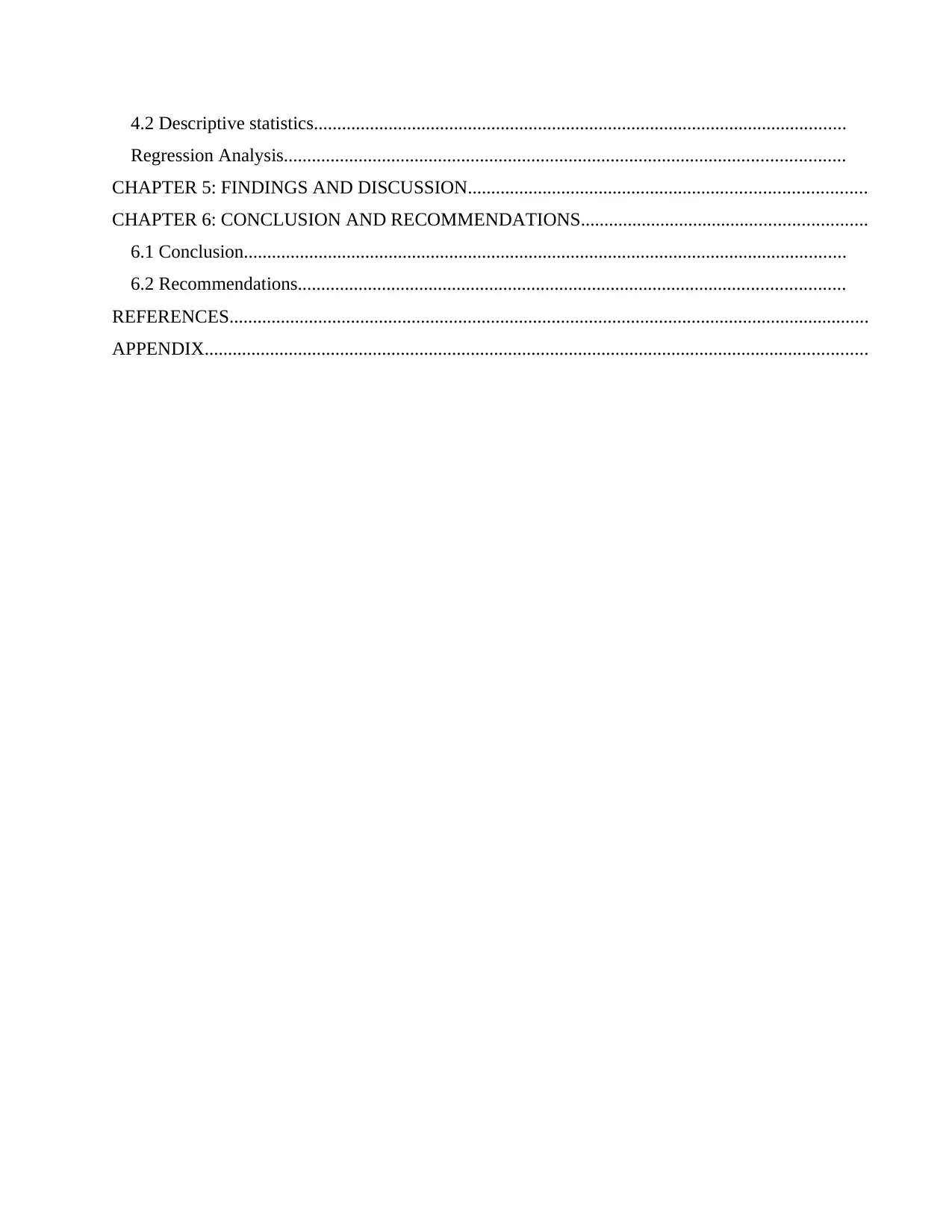
4.2 Descriptive statistics..................................................................................................................
Regression Analysis........................................................................................................................
CHAPTER 5: FINDINGS AND DISCUSSION.....................................................................................
CHAPTER 6: CONCLUSION AND RECOMMENDATIONS.............................................................
6.1 Conclusion.................................................................................................................................
6.2 Recommendations.....................................................................................................................
REFERENCES.........................................................................................................................................
APPENDIX..............................................................................................................................................
Regression Analysis........................................................................................................................
CHAPTER 5: FINDINGS AND DISCUSSION.....................................................................................
CHAPTER 6: CONCLUSION AND RECOMMENDATIONS.............................................................
6.1 Conclusion.................................................................................................................................
6.2 Recommendations.....................................................................................................................
REFERENCES.........................................................................................................................................
APPENDIX..............................................................................................................................................
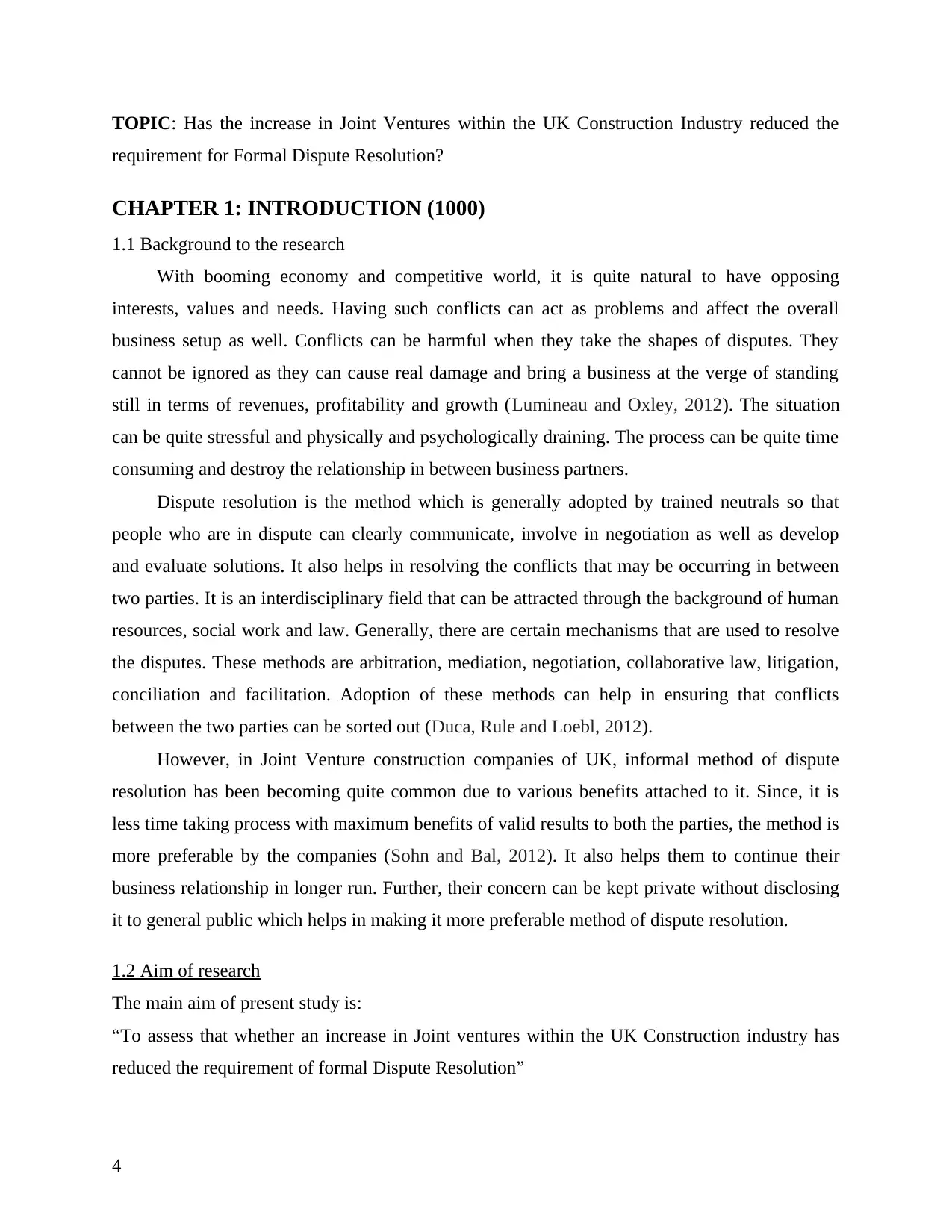
TOPIC: Has the increase in Joint Ventures within the UK Construction Industry reduced the
requirement for Formal Dispute Resolution?
CHAPTER 1: INTRODUCTION (1000)
1.1 Background to the research
With booming economy and competitive world, it is quite natural to have opposing
interests, values and needs. Having such conflicts can act as problems and affect the overall
business setup as well. Conflicts can be harmful when they take the shapes of disputes. They
cannot be ignored as they can cause real damage and bring a business at the verge of standing
still in terms of revenues, profitability and growth (Lumineau and Oxley, 2012). The situation
can be quite stressful and physically and psychologically draining. The process can be quite time
consuming and destroy the relationship in between business partners.
Dispute resolution is the method which is generally adopted by trained neutrals so that
people who are in dispute can clearly communicate, involve in negotiation as well as develop
and evaluate solutions. It also helps in resolving the conflicts that may be occurring in between
two parties. It is an interdisciplinary field that can be attracted through the background of human
resources, social work and law. Generally, there are certain mechanisms that are used to resolve
the disputes. These methods are arbitration, mediation, negotiation, collaborative law, litigation,
conciliation and facilitation. Adoption of these methods can help in ensuring that conflicts
between the two parties can be sorted out (Duca, Rule and Loebl, 2012).
However, in Joint Venture construction companies of UK, informal method of dispute
resolution has been becoming quite common due to various benefits attached to it. Since, it is
less time taking process with maximum benefits of valid results to both the parties, the method is
more preferable by the companies (Sohn and Bal, 2012). It also helps them to continue their
business relationship in longer run. Further, their concern can be kept private without disclosing
it to general public which helps in making it more preferable method of dispute resolution.
1.2 Aim of research
The main aim of present study is:
“To assess that whether an increase in Joint ventures within the UK Construction industry has
reduced the requirement of formal Dispute Resolution”
4
requirement for Formal Dispute Resolution?
CHAPTER 1: INTRODUCTION (1000)
1.1 Background to the research
With booming economy and competitive world, it is quite natural to have opposing
interests, values and needs. Having such conflicts can act as problems and affect the overall
business setup as well. Conflicts can be harmful when they take the shapes of disputes. They
cannot be ignored as they can cause real damage and bring a business at the verge of standing
still in terms of revenues, profitability and growth (Lumineau and Oxley, 2012). The situation
can be quite stressful and physically and psychologically draining. The process can be quite time
consuming and destroy the relationship in between business partners.
Dispute resolution is the method which is generally adopted by trained neutrals so that
people who are in dispute can clearly communicate, involve in negotiation as well as develop
and evaluate solutions. It also helps in resolving the conflicts that may be occurring in between
two parties. It is an interdisciplinary field that can be attracted through the background of human
resources, social work and law. Generally, there are certain mechanisms that are used to resolve
the disputes. These methods are arbitration, mediation, negotiation, collaborative law, litigation,
conciliation and facilitation. Adoption of these methods can help in ensuring that conflicts
between the two parties can be sorted out (Duca, Rule and Loebl, 2012).
However, in Joint Venture construction companies of UK, informal method of dispute
resolution has been becoming quite common due to various benefits attached to it. Since, it is
less time taking process with maximum benefits of valid results to both the parties, the method is
more preferable by the companies (Sohn and Bal, 2012). It also helps them to continue their
business relationship in longer run. Further, their concern can be kept private without disclosing
it to general public which helps in making it more preferable method of dispute resolution.
1.2 Aim of research
The main aim of present study is:
“To assess that whether an increase in Joint ventures within the UK Construction industry has
reduced the requirement of formal Dispute Resolution”
4
Secure Best Marks with AI Grader
Need help grading? Try our AI Grader for instant feedback on your assignments.
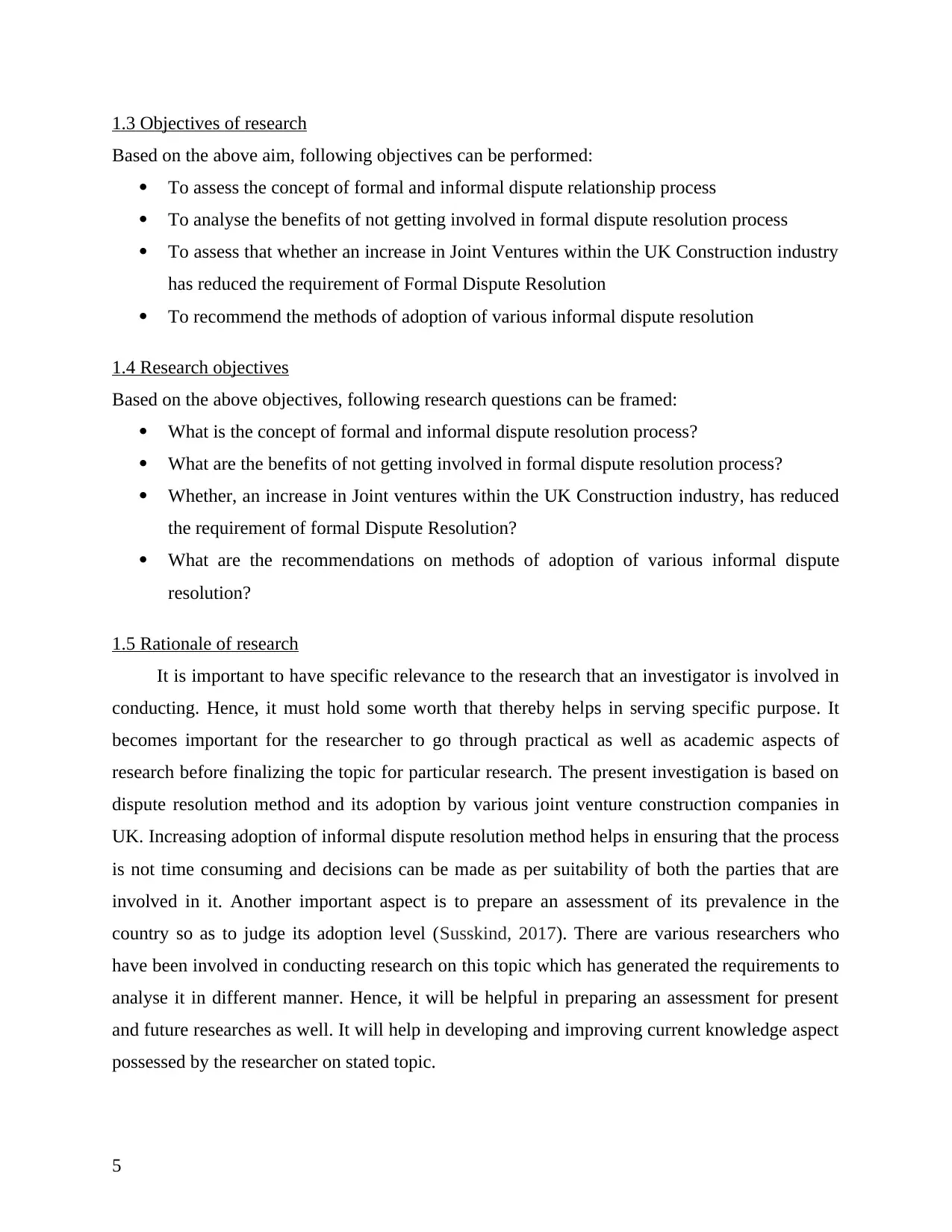
1.3 Objectives of research
Based on the above aim, following objectives can be performed:
To assess the concept of formal and informal dispute relationship process
To analyse the benefits of not getting involved in formal dispute resolution process
To assess that whether an increase in Joint Ventures within the UK Construction industry
has reduced the requirement of Formal Dispute Resolution
To recommend the methods of adoption of various informal dispute resolution
1.4 Research objectives
Based on the above objectives, following research questions can be framed:
What is the concept of formal and informal dispute resolution process?
What are the benefits of not getting involved in formal dispute resolution process?
Whether, an increase in Joint ventures within the UK Construction industry, has reduced
the requirement of formal Dispute Resolution?
What are the recommendations on methods of adoption of various informal dispute
resolution?
1.5 Rationale of research
It is important to have specific relevance to the research that an investigator is involved in
conducting. Hence, it must hold some worth that thereby helps in serving specific purpose. It
becomes important for the researcher to go through practical as well as academic aspects of
research before finalizing the topic for particular research. The present investigation is based on
dispute resolution method and its adoption by various joint venture construction companies in
UK. Increasing adoption of informal dispute resolution method helps in ensuring that the process
is not time consuming and decisions can be made as per suitability of both the parties that are
involved in it. Another important aspect is to prepare an assessment of its prevalence in the
country so as to judge its adoption level (Susskind, 2017). There are various researchers who
have been involved in conducting research on this topic which has generated the requirements to
analyse it in different manner. Hence, it will be helpful in preparing an assessment for present
and future researches as well. It will help in developing and improving current knowledge aspect
possessed by the researcher on stated topic.
5
Based on the above aim, following objectives can be performed:
To assess the concept of formal and informal dispute relationship process
To analyse the benefits of not getting involved in formal dispute resolution process
To assess that whether an increase in Joint Ventures within the UK Construction industry
has reduced the requirement of Formal Dispute Resolution
To recommend the methods of adoption of various informal dispute resolution
1.4 Research objectives
Based on the above objectives, following research questions can be framed:
What is the concept of formal and informal dispute resolution process?
What are the benefits of not getting involved in formal dispute resolution process?
Whether, an increase in Joint ventures within the UK Construction industry, has reduced
the requirement of formal Dispute Resolution?
What are the recommendations on methods of adoption of various informal dispute
resolution?
1.5 Rationale of research
It is important to have specific relevance to the research that an investigator is involved in
conducting. Hence, it must hold some worth that thereby helps in serving specific purpose. It
becomes important for the researcher to go through practical as well as academic aspects of
research before finalizing the topic for particular research. The present investigation is based on
dispute resolution method and its adoption by various joint venture construction companies in
UK. Increasing adoption of informal dispute resolution method helps in ensuring that the process
is not time consuming and decisions can be made as per suitability of both the parties that are
involved in it. Another important aspect is to prepare an assessment of its prevalence in the
country so as to judge its adoption level (Susskind, 2017). There are various researchers who
have been involved in conducting research on this topic which has generated the requirements to
analyse it in different manner. Hence, it will be helpful in preparing an assessment for present
and future researches as well. It will help in developing and improving current knowledge aspect
possessed by the researcher on stated topic.
5
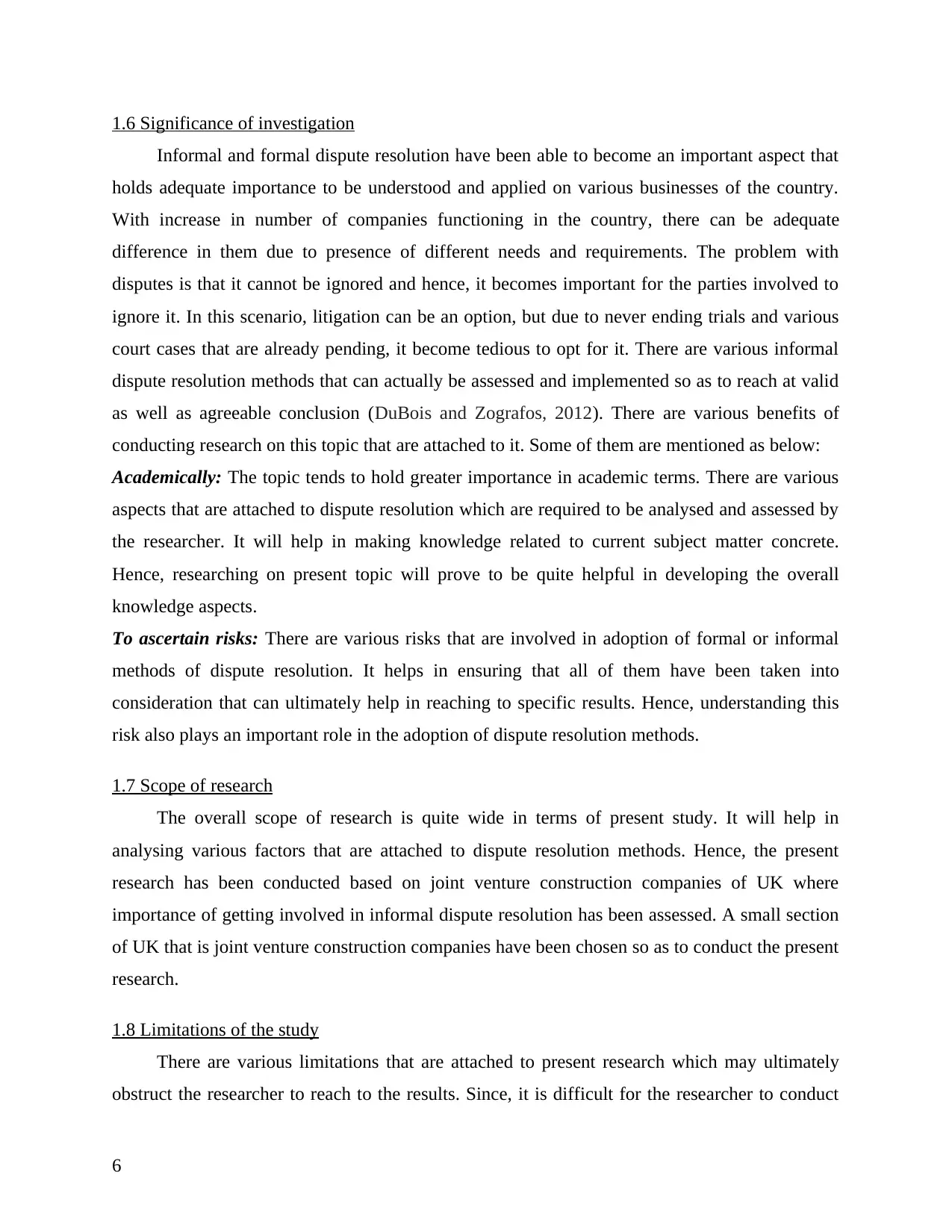
1.6 Significance of investigation
Informal and formal dispute resolution have been able to become an important aspect that
holds adequate importance to be understood and applied on various businesses of the country.
With increase in number of companies functioning in the country, there can be adequate
difference in them due to presence of different needs and requirements. The problem with
disputes is that it cannot be ignored and hence, it becomes important for the parties involved to
ignore it. In this scenario, litigation can be an option, but due to never ending trials and various
court cases that are already pending, it become tedious to opt for it. There are various informal
dispute resolution methods that can actually be assessed and implemented so as to reach at valid
as well as agreeable conclusion (DuBois and Zografos, 2012). There are various benefits of
conducting research on this topic that are attached to it. Some of them are mentioned as below:
Academically: The topic tends to hold greater importance in academic terms. There are various
aspects that are attached to dispute resolution which are required to be analysed and assessed by
the researcher. It will help in making knowledge related to current subject matter concrete.
Hence, researching on present topic will prove to be quite helpful in developing the overall
knowledge aspects.
To ascertain risks: There are various risks that are involved in adoption of formal or informal
methods of dispute resolution. It helps in ensuring that all of them have been taken into
consideration that can ultimately help in reaching to specific results. Hence, understanding this
risk also plays an important role in the adoption of dispute resolution methods.
1.7 Scope of research
The overall scope of research is quite wide in terms of present study. It will help in
analysing various factors that are attached to dispute resolution methods. Hence, the present
research has been conducted based on joint venture construction companies of UK where
importance of getting involved in informal dispute resolution has been assessed. A small section
of UK that is joint venture construction companies have been chosen so as to conduct the present
research.
1.8 Limitations of the study
There are various limitations that are attached to present research which may ultimately
obstruct the researcher to reach to the results. Since, it is difficult for the researcher to conduct
6
Informal and formal dispute resolution have been able to become an important aspect that
holds adequate importance to be understood and applied on various businesses of the country.
With increase in number of companies functioning in the country, there can be adequate
difference in them due to presence of different needs and requirements. The problem with
disputes is that it cannot be ignored and hence, it becomes important for the parties involved to
ignore it. In this scenario, litigation can be an option, but due to never ending trials and various
court cases that are already pending, it become tedious to opt for it. There are various informal
dispute resolution methods that can actually be assessed and implemented so as to reach at valid
as well as agreeable conclusion (DuBois and Zografos, 2012). There are various benefits of
conducting research on this topic that are attached to it. Some of them are mentioned as below:
Academically: The topic tends to hold greater importance in academic terms. There are various
aspects that are attached to dispute resolution which are required to be analysed and assessed by
the researcher. It will help in making knowledge related to current subject matter concrete.
Hence, researching on present topic will prove to be quite helpful in developing the overall
knowledge aspects.
To ascertain risks: There are various risks that are involved in adoption of formal or informal
methods of dispute resolution. It helps in ensuring that all of them have been taken into
consideration that can ultimately help in reaching to specific results. Hence, understanding this
risk also plays an important role in the adoption of dispute resolution methods.
1.7 Scope of research
The overall scope of research is quite wide in terms of present study. It will help in
analysing various factors that are attached to dispute resolution methods. Hence, the present
research has been conducted based on joint venture construction companies of UK where
importance of getting involved in informal dispute resolution has been assessed. A small section
of UK that is joint venture construction companies have been chosen so as to conduct the present
research.
1.8 Limitations of the study
There are various limitations that are attached to present research which may ultimately
obstruct the researcher to reach to the results. Since, it is difficult for the researcher to conduct
6
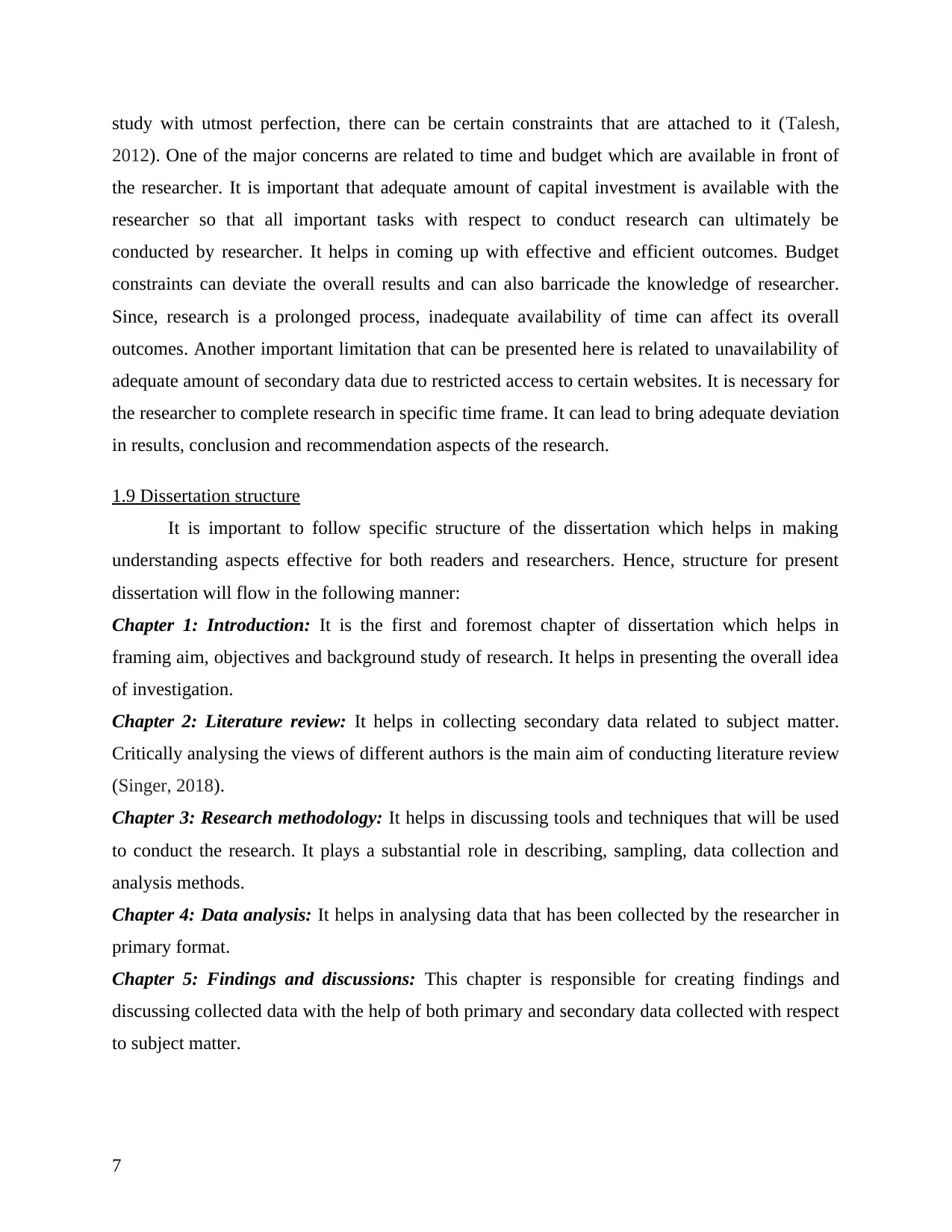
study with utmost perfection, there can be certain constraints that are attached to it (Talesh,
2012). One of the major concerns are related to time and budget which are available in front of
the researcher. It is important that adequate amount of capital investment is available with the
researcher so that all important tasks with respect to conduct research can ultimately be
conducted by researcher. It helps in coming up with effective and efficient outcomes. Budget
constraints can deviate the overall results and can also barricade the knowledge of researcher.
Since, research is a prolonged process, inadequate availability of time can affect its overall
outcomes. Another important limitation that can be presented here is related to unavailability of
adequate amount of secondary data due to restricted access to certain websites. It is necessary for
the researcher to complete research in specific time frame. It can lead to bring adequate deviation
in results, conclusion and recommendation aspects of the research.
1.9 Dissertation structure
It is important to follow specific structure of the dissertation which helps in making
understanding aspects effective for both readers and researchers. Hence, structure for present
dissertation will flow in the following manner:
Chapter 1: Introduction: It is the first and foremost chapter of dissertation which helps in
framing aim, objectives and background study of research. It helps in presenting the overall idea
of investigation.
Chapter 2: Literature review: It helps in collecting secondary data related to subject matter.
Critically analysing the views of different authors is the main aim of conducting literature review
(Singer, 2018).
Chapter 3: Research methodology: It helps in discussing tools and techniques that will be used
to conduct the research. It plays a substantial role in describing, sampling, data collection and
analysis methods.
Chapter 4: Data analysis: It helps in analysing data that has been collected by the researcher in
primary format.
Chapter 5: Findings and discussions: This chapter is responsible for creating findings and
discussing collected data with the help of both primary and secondary data collected with respect
to subject matter.
7
2012). One of the major concerns are related to time and budget which are available in front of
the researcher. It is important that adequate amount of capital investment is available with the
researcher so that all important tasks with respect to conduct research can ultimately be
conducted by researcher. It helps in coming up with effective and efficient outcomes. Budget
constraints can deviate the overall results and can also barricade the knowledge of researcher.
Since, research is a prolonged process, inadequate availability of time can affect its overall
outcomes. Another important limitation that can be presented here is related to unavailability of
adequate amount of secondary data due to restricted access to certain websites. It is necessary for
the researcher to complete research in specific time frame. It can lead to bring adequate deviation
in results, conclusion and recommendation aspects of the research.
1.9 Dissertation structure
It is important to follow specific structure of the dissertation which helps in making
understanding aspects effective for both readers and researchers. Hence, structure for present
dissertation will flow in the following manner:
Chapter 1: Introduction: It is the first and foremost chapter of dissertation which helps in
framing aim, objectives and background study of research. It helps in presenting the overall idea
of investigation.
Chapter 2: Literature review: It helps in collecting secondary data related to subject matter.
Critically analysing the views of different authors is the main aim of conducting literature review
(Singer, 2018).
Chapter 3: Research methodology: It helps in discussing tools and techniques that will be used
to conduct the research. It plays a substantial role in describing, sampling, data collection and
analysis methods.
Chapter 4: Data analysis: It helps in analysing data that has been collected by the researcher in
primary format.
Chapter 5: Findings and discussions: This chapter is responsible for creating findings and
discussing collected data with the help of both primary and secondary data collected with respect
to subject matter.
7
Paraphrase This Document
Need a fresh take? Get an instant paraphrase of this document with our AI Paraphraser

Chapter 6: Conclusion and recommendations: Based on the overall research conducted,
ultimate concluding remarks and recommendations can be given by the researcher based on aim
and objectives framed (Mulcahy, 2012).
CHAPTER 2: LITERATURE REVIEW (3000)
2.1 Introduction
After introduction, literature review is considered to be one of the most important chapters
of dissertation which helps in defining the observation and analysis that must be prepared by the
other researchers on similar topic. Critically analysing the facts helps in understanding the flaws
and differences that can ultimately be settled down in the present study. Since, it is a secondary
type of research, it is important to consider each and every result that has been stated by the
researcher in his research. Based on the themes flowing from general to specific, literature
review will help in understanding each and every aspect that is related to subject matter of the
research. Hence, thematic analysis has been performed for the same.
2.2 Meaning of dispute resolution
According to Goldberg and et.al., (2014) dispute resolution is the process of resolving
disputes in between parties. The term can also interchangeably be used for conflict resolution,
where different conflict styles can be adopted as per the scenarios. Some common methods that
are adopted by the organization include arbitration, mediation, negotiation, litigation,
collaborative law, conciliation and facilitation. Theoretically, one can adopt war and violence as
one of the spectrum, but dispute resolution practitioners generally do not opt for this method.
The process of dispute resolution can be in two states, such as, adjudicative as well as consensual
processes. Adjudicative processes can be in the form of judge, jury and arbitrator which
ultimately helps in determination of effective outcomes. There are consensual processes present
which can also be used by the organization as well as individuals at the time of disputes. These
are negotiation, mediation and conciliation. Not all types of disputes tend to end in resolution,
rather, such intractable disputes tend to find its place in dispute resolution studies. Dispute
resolution is an important aspect that is generally opted for international trade which can be
inclusive of negotiation, arbitration, mediation and litigation.
However, in comparison to this, as per the views of Wahab, Katsh and Rainey, (2012)
legal system has tendency to provide resolution for various types of disputes. Some of them opt
8
ultimate concluding remarks and recommendations can be given by the researcher based on aim
and objectives framed (Mulcahy, 2012).
CHAPTER 2: LITERATURE REVIEW (3000)
2.1 Introduction
After introduction, literature review is considered to be one of the most important chapters
of dissertation which helps in defining the observation and analysis that must be prepared by the
other researchers on similar topic. Critically analysing the facts helps in understanding the flaws
and differences that can ultimately be settled down in the present study. Since, it is a secondary
type of research, it is important to consider each and every result that has been stated by the
researcher in his research. Based on the themes flowing from general to specific, literature
review will help in understanding each and every aspect that is related to subject matter of the
research. Hence, thematic analysis has been performed for the same.
2.2 Meaning of dispute resolution
According to Goldberg and et.al., (2014) dispute resolution is the process of resolving
disputes in between parties. The term can also interchangeably be used for conflict resolution,
where different conflict styles can be adopted as per the scenarios. Some common methods that
are adopted by the organization include arbitration, mediation, negotiation, litigation,
collaborative law, conciliation and facilitation. Theoretically, one can adopt war and violence as
one of the spectrum, but dispute resolution practitioners generally do not opt for this method.
The process of dispute resolution can be in two states, such as, adjudicative as well as consensual
processes. Adjudicative processes can be in the form of judge, jury and arbitrator which
ultimately helps in determination of effective outcomes. There are consensual processes present
which can also be used by the organization as well as individuals at the time of disputes. These
are negotiation, mediation and conciliation. Not all types of disputes tend to end in resolution,
rather, such intractable disputes tend to find its place in dispute resolution studies. Dispute
resolution is an important aspect that is generally opted for international trade which can be
inclusive of negotiation, arbitration, mediation and litigation.
However, in comparison to this, as per the views of Wahab, Katsh and Rainey, (2012)
legal system has tendency to provide resolution for various types of disputes. Some of them opt
8

for coercive power to resolve the matter. However, there are others who opt for professional
advocates who can help them in sorting out the matter. The most common judicial aspect of
dispute resolution is litigation where one party can file suit against the other. It is generally
facilitated by the government within federal, state and municipal courts. The proceeding opted
for is quite formal. Hence, it is also sometimes known to be formal form of dispute resolution. It
is governed by rules and specific code of conduct which is required to be followed; and
judgement is generally based on evidences and procedures available to it. The judges appointed
for the same are impartial in nature where decisions are made as per factual aspects of the case.
The ultimate decision of court is binding and not advisory in nature. However, both the parties
enjoy right to appeal for judgement in higher court if they are not satisfied with the judgement of
lower court.
According to Moffitt and Bordone, (2012) there are various retired judges as well as
private lawyers who tend to play the role of an arbitrator who are trained and qualified for non-
legal dispute resolution. They can also play the role of mediator while opting for mediation
process so as to resolve cases. However, apart from these judicial processes, there are other
extrajudicial processes present which can also be used by the businesses. It is inclusive of
collaborative law, mediation and arbitration. However, in contrast to this, as per the views of
Mackie and Mackie, (2013) litigation aspect can be quite effective for the organization.
However, its impact can be of long term as it can affect the brand image of company. In this
scenario, so as to preserve brand image of company, corporation tend to opt for unjudicial
methods that can be effective enough for firm. It also helps in ensuring that the ultimate
decision-making aspect is able to satisfy interest of both parties which are involved in it.
2.3 Formal and informal method of dispute resolution
According to Casey and Wilson-Evered, (2012) formal method of dispute resolution may
include the mechanism that has officially being framed and organized. However, in case of
informal method of dispute resolution, it is not officially recognized and organized. It takes place
as per the convenience level of parties that are involved in it. One of the common methods of
information of dispute resolution is negotiation. It involves discussion between the two or more
parties involved in dispute who want to solve their issue of disagreement and decide to bargain
and act which can prove to be beneficial for both the parties. It can be inclusive of advocates and
representatives. Another method is conciliation where third individual apart from those disputed
9
advocates who can help them in sorting out the matter. The most common judicial aspect of
dispute resolution is litigation where one party can file suit against the other. It is generally
facilitated by the government within federal, state and municipal courts. The proceeding opted
for is quite formal. Hence, it is also sometimes known to be formal form of dispute resolution. It
is governed by rules and specific code of conduct which is required to be followed; and
judgement is generally based on evidences and procedures available to it. The judges appointed
for the same are impartial in nature where decisions are made as per factual aspects of the case.
The ultimate decision of court is binding and not advisory in nature. However, both the parties
enjoy right to appeal for judgement in higher court if they are not satisfied with the judgement of
lower court.
According to Moffitt and Bordone, (2012) there are various retired judges as well as
private lawyers who tend to play the role of an arbitrator who are trained and qualified for non-
legal dispute resolution. They can also play the role of mediator while opting for mediation
process so as to resolve cases. However, apart from these judicial processes, there are other
extrajudicial processes present which can also be used by the businesses. It is inclusive of
collaborative law, mediation and arbitration. However, in contrast to this, as per the views of
Mackie and Mackie, (2013) litigation aspect can be quite effective for the organization.
However, its impact can be of long term as it can affect the brand image of company. In this
scenario, so as to preserve brand image of company, corporation tend to opt for unjudicial
methods that can be effective enough for firm. It also helps in ensuring that the ultimate
decision-making aspect is able to satisfy interest of both parties which are involved in it.
2.3 Formal and informal method of dispute resolution
According to Casey and Wilson-Evered, (2012) formal method of dispute resolution may
include the mechanism that has officially being framed and organized. However, in case of
informal method of dispute resolution, it is not officially recognized and organized. It takes place
as per the convenience level of parties that are involved in it. One of the common methods of
information of dispute resolution is negotiation. It involves discussion between the two or more
parties involved in dispute who want to solve their issue of disagreement and decide to bargain
and act which can prove to be beneficial for both the parties. It can be inclusive of advocates and
representatives. Another method is conciliation where third individual apart from those disputed
9

parties helps in reaching to amicable resolution aspects of their dispute. The conciliator cannot
impose settlement decided by him on the involved parties and generally opt for interacting with
the involved companies separately. Further, facilitation is another dispute resolution technique
who involves neutral. It helps members of a group to define and meet their respective goals,
helps in solving problems, exchanging idea and holding information for effective meetings.
However. In comparison to this, as per the views of Carneiro and et.al., (2013) mediation is the
best and most adoptive practice that helps in creating clear communication and negotiating
effectively. It is private and also voluntary practice which helps in frequently resulting in
agreement because it is created by the people who are directly involved in it. Another important
practice that is adopted by the disputed organization is neutral evaluation which states that a
neutral individual is hired so as to get expertise in hearing arguments and predicting likely
outcomes out of court. The evaluator appointed also helps in providing guidance and settlement
assistance with the concerned parties.
According to Taylor, (2012) there are other judicial methods as well that can be adopted by
the organization so as to sort out their issues. One of these methods is arbitration. It includes
formal proceedings which have the involvement of one of more neutrals who listen to the present
evidences and give his decision based on it. The collective version of these neutrals is known as
“Arbitral tribunal”. The decision has high dependence on the parties involved in it. It can be
binding or non-binding as per their convenience. One of the most common methods that is
adopted by the organization or other individual is litigation which is a formal form of dispute
resolution. Litigation is a legal dispute which is responsible for generating arguments in the court
of law. Attorney generally helps in negotiating the resolution in a manner that judges or jury can
make the decisions out of evidence present. Parties, organizations or individuals involved in
dispute have no or little control over the overall process or outcomes. Hence the decision being
made by the court is binding and required to be followed by them accordingly. However, in
contrast to this, as per the views of Bosch, van de Pol and Philp, (2015) there exists various
issues when differentiating various aspects of formal and informal form of dispute resolution.
People tend to have different opinions and practices related to it as it is quite a subjective
phenomenon. They have cauterised formal and informal form of dispute resolution practices as
per their will, understanding and observations. Hence, it has high dependence on the parties
involved in dispute that, which method they choose to adopt out of the two.
10
impose settlement decided by him on the involved parties and generally opt for interacting with
the involved companies separately. Further, facilitation is another dispute resolution technique
who involves neutral. It helps members of a group to define and meet their respective goals,
helps in solving problems, exchanging idea and holding information for effective meetings.
However. In comparison to this, as per the views of Carneiro and et.al., (2013) mediation is the
best and most adoptive practice that helps in creating clear communication and negotiating
effectively. It is private and also voluntary practice which helps in frequently resulting in
agreement because it is created by the people who are directly involved in it. Another important
practice that is adopted by the disputed organization is neutral evaluation which states that a
neutral individual is hired so as to get expertise in hearing arguments and predicting likely
outcomes out of court. The evaluator appointed also helps in providing guidance and settlement
assistance with the concerned parties.
According to Taylor, (2012) there are other judicial methods as well that can be adopted by
the organization so as to sort out their issues. One of these methods is arbitration. It includes
formal proceedings which have the involvement of one of more neutrals who listen to the present
evidences and give his decision based on it. The collective version of these neutrals is known as
“Arbitral tribunal”. The decision has high dependence on the parties involved in it. It can be
binding or non-binding as per their convenience. One of the most common methods that is
adopted by the organization or other individual is litigation which is a formal form of dispute
resolution. Litigation is a legal dispute which is responsible for generating arguments in the court
of law. Attorney generally helps in negotiating the resolution in a manner that judges or jury can
make the decisions out of evidence present. Parties, organizations or individuals involved in
dispute have no or little control over the overall process or outcomes. Hence the decision being
made by the court is binding and required to be followed by them accordingly. However, in
contrast to this, as per the views of Bosch, van de Pol and Philp, (2015) there exists various
issues when differentiating various aspects of formal and informal form of dispute resolution.
People tend to have different opinions and practices related to it as it is quite a subjective
phenomenon. They have cauterised formal and informal form of dispute resolution practices as
per their will, understanding and observations. Hence, it has high dependence on the parties
involved in dispute that, which method they choose to adopt out of the two.
10
Secure Best Marks with AI Grader
Need help grading? Try our AI Grader for instant feedback on your assignments.
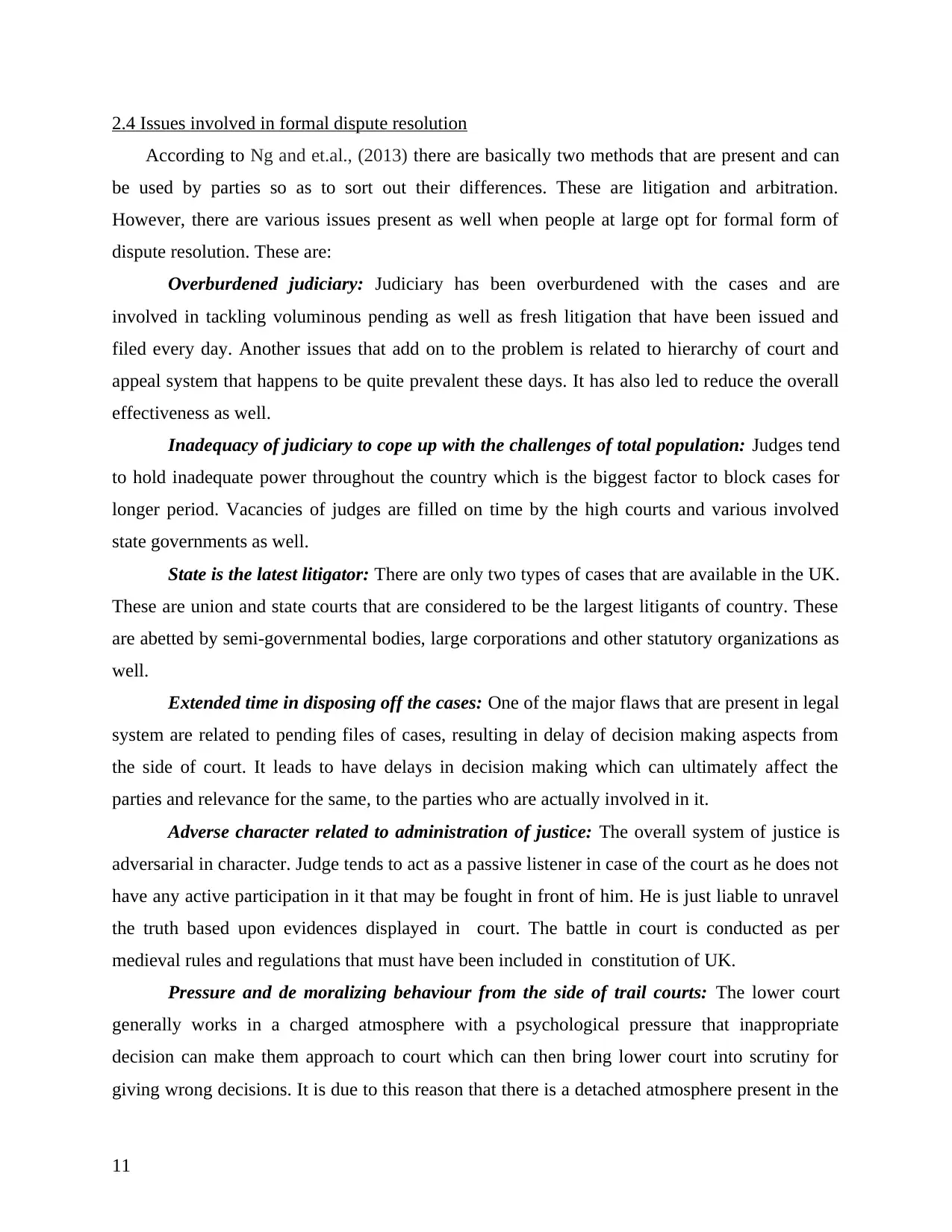
2.4 Issues involved in formal dispute resolution
According to Ng and et.al., (2013) there are basically two methods that are present and can
be used by parties so as to sort out their differences. These are litigation and arbitration.
However, there are various issues present as well when people at large opt for formal form of
dispute resolution. These are:
Overburdened judiciary: Judiciary has been overburdened with the cases and are
involved in tackling voluminous pending as well as fresh litigation that have been issued and
filed every day. Another issues that add on to the problem is related to hierarchy of court and
appeal system that happens to be quite prevalent these days. It has also led to reduce the overall
effectiveness as well.
Inadequacy of judiciary to cope up with the challenges of total population: Judges tend
to hold inadequate power throughout the country which is the biggest factor to block cases for
longer period. Vacancies of judges are filled on time by the high courts and various involved
state governments as well.
State is the latest litigator: There are only two types of cases that are available in the UK.
These are union and state courts that are considered to be the largest litigants of country. These
are abetted by semi-governmental bodies, large corporations and other statutory organizations as
well.
Extended time in disposing off the cases: One of the major flaws that are present in legal
system are related to pending files of cases, resulting in delay of decision making aspects from
the side of court. It leads to have delays in decision making which can ultimately affect the
parties and relevance for the same, to the parties who are actually involved in it.
Adverse character related to administration of justice: The overall system of justice is
adversarial in character. Judge tends to act as a passive listener in case of the court as he does not
have any active participation in it that may be fought in front of him. He is just liable to unravel
the truth based upon evidences displayed in court. The battle in court is conducted as per
medieval rules and regulations that must have been included in constitution of UK.
Pressure and de moralizing behaviour from the side of trail courts: The lower court
generally works in a charged atmosphere with a psychological pressure that inappropriate
decision can make them approach to court which can then bring lower court into scrutiny for
giving wrong decisions. It is due to this reason that there is a detached atmosphere present in the
11
According to Ng and et.al., (2013) there are basically two methods that are present and can
be used by parties so as to sort out their differences. These are litigation and arbitration.
However, there are various issues present as well when people at large opt for formal form of
dispute resolution. These are:
Overburdened judiciary: Judiciary has been overburdened with the cases and are
involved in tackling voluminous pending as well as fresh litigation that have been issued and
filed every day. Another issues that add on to the problem is related to hierarchy of court and
appeal system that happens to be quite prevalent these days. It has also led to reduce the overall
effectiveness as well.
Inadequacy of judiciary to cope up with the challenges of total population: Judges tend
to hold inadequate power throughout the country which is the biggest factor to block cases for
longer period. Vacancies of judges are filled on time by the high courts and various involved
state governments as well.
State is the latest litigator: There are only two types of cases that are available in the UK.
These are union and state courts that are considered to be the largest litigants of country. These
are abetted by semi-governmental bodies, large corporations and other statutory organizations as
well.
Extended time in disposing off the cases: One of the major flaws that are present in legal
system are related to pending files of cases, resulting in delay of decision making aspects from
the side of court. It leads to have delays in decision making which can ultimately affect the
parties and relevance for the same, to the parties who are actually involved in it.
Adverse character related to administration of justice: The overall system of justice is
adversarial in character. Judge tends to act as a passive listener in case of the court as he does not
have any active participation in it that may be fought in front of him. He is just liable to unravel
the truth based upon evidences displayed in court. The battle in court is conducted as per
medieval rules and regulations that must have been included in constitution of UK.
Pressure and de moralizing behaviour from the side of trail courts: The lower court
generally works in a charged atmosphere with a psychological pressure that inappropriate
decision can make them approach to court which can then bring lower court into scrutiny for
giving wrong decisions. It is due to this reason that there is a detached atmosphere present in the
11

environment so as to ensure that no error is being conducted by them which can challenge
ultimate decision that must have been made by the lower courts. It ultimately leads to affect the
effectiveness of results.
2.5 An increase in Joint ventures in UK Construction industry has reduced requirement of
adjudication
According to Talesh, (2012), implication of alternative dispute resolution will be
effective and helpful to organisation in relation with having concrete outcomes in the required
period. Thus, there are mainly issues relevant with domestic and small issues incurred in trade
practices which will be addressed by a legal adviser and which analyse all legal issues
associated with tbusiness that will be solved by them in the prominent way. They address all
requirements and bring effective solution to the issues. The main reason behind construction
industry using ADR system is that they have various disputes which will be resolved by
communicating and determining tlegal norms and laws relevant with fact. However, as per the
views of Allwood, (2012) adjudication have been quite common in case of construction
companies in UK even if there are various negative aspects that are attached to it. It is a legal
process with the help of which an arbitrator or judge review all the evidences and arguments
inclusive of legal reasoning, set forth by opposing parties or litigants so that the team can reach
to specific decisions which help in determining rights and obligations between the parties who
are involved in litigation activities. It is commonly defined as a process which is used to resolve
disputes. It is commonly pronounced as a common decree in court proceeding. The process is
quite lengthy and time taking. Due to increase in number of joint ventures in the country, it has
helped in decreasing the degree and intensity of competition prevailing in UK. It is
understandable as well as alarming which can help in advising the parties that may be indulged
in particular contract.
According to BNS and HV, (2013) adjudication has predominantly reduced in the UK
where the reason has been assessed that due to enactment of Housing grants Construction and
regeneration Act 1996, there is an initiation in importance of joint ventures. It helped in
increasing the ability of one party to a construction contract, to take any dispute through
adjudication procedure any time quickly superseded arbitration as the traditional dispute
resolution process within the particular industry. The prime essence of UK construction
adjudication is statutory right which helps in referring to dispute to adjudication at any time. It
12
ultimate decision that must have been made by the lower courts. It ultimately leads to affect the
effectiveness of results.
2.5 An increase in Joint ventures in UK Construction industry has reduced requirement of
adjudication
According to Talesh, (2012), implication of alternative dispute resolution will be
effective and helpful to organisation in relation with having concrete outcomes in the required
period. Thus, there are mainly issues relevant with domestic and small issues incurred in trade
practices which will be addressed by a legal adviser and which analyse all legal issues
associated with tbusiness that will be solved by them in the prominent way. They address all
requirements and bring effective solution to the issues. The main reason behind construction
industry using ADR system is that they have various disputes which will be resolved by
communicating and determining tlegal norms and laws relevant with fact. However, as per the
views of Allwood, (2012) adjudication have been quite common in case of construction
companies in UK even if there are various negative aspects that are attached to it. It is a legal
process with the help of which an arbitrator or judge review all the evidences and arguments
inclusive of legal reasoning, set forth by opposing parties or litigants so that the team can reach
to specific decisions which help in determining rights and obligations between the parties who
are involved in litigation activities. It is commonly defined as a process which is used to resolve
disputes. It is commonly pronounced as a common decree in court proceeding. The process is
quite lengthy and time taking. Due to increase in number of joint ventures in the country, it has
helped in decreasing the degree and intensity of competition prevailing in UK. It is
understandable as well as alarming which can help in advising the parties that may be indulged
in particular contract.
According to BNS and HV, (2013) adjudication has predominantly reduced in the UK
where the reason has been assessed that due to enactment of Housing grants Construction and
regeneration Act 1996, there is an initiation in importance of joint ventures. It helped in
increasing the ability of one party to a construction contract, to take any dispute through
adjudication procedure any time quickly superseded arbitration as the traditional dispute
resolution process within the particular industry. The prime essence of UK construction
adjudication is statutory right which helps in referring to dispute to adjudication at any time. It
12
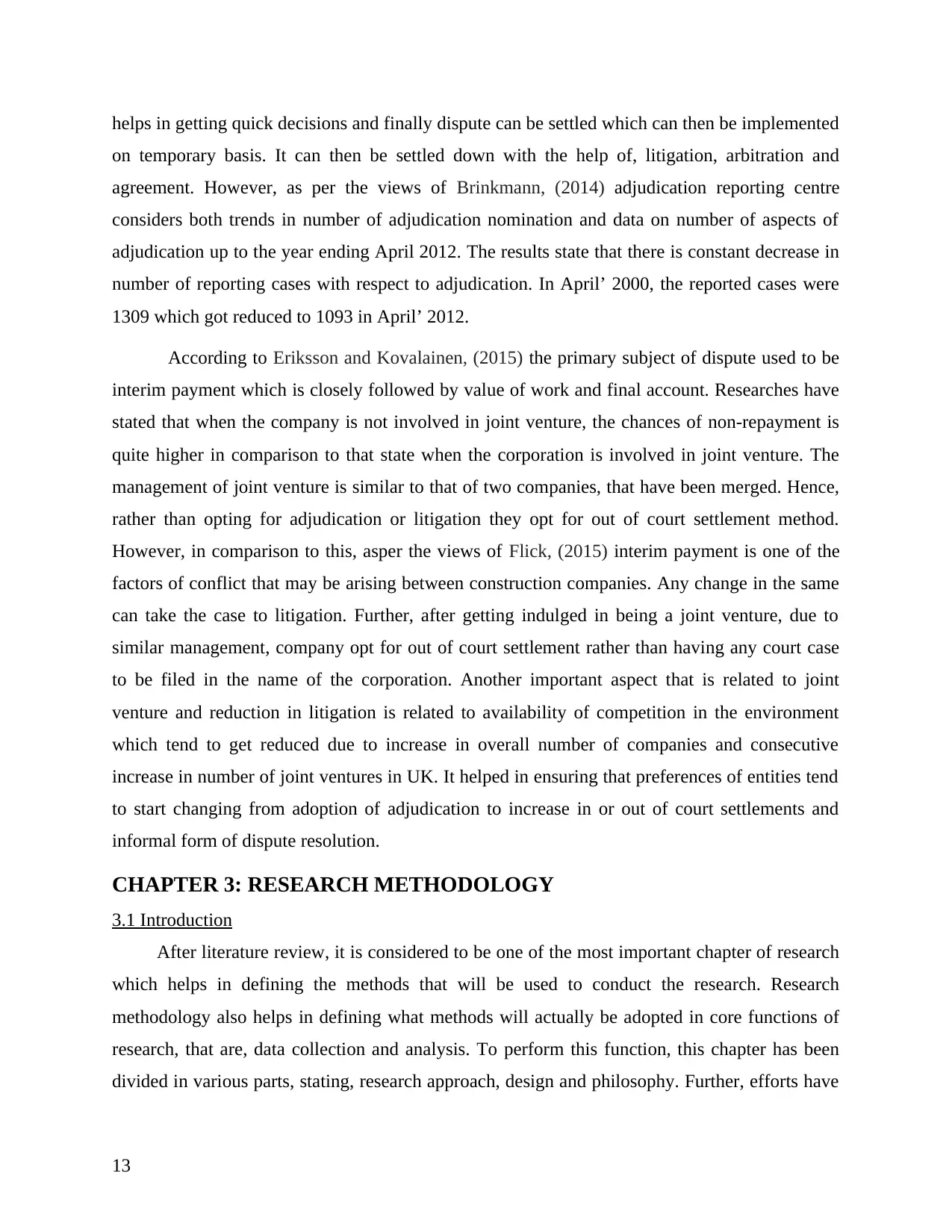
helps in getting quick decisions and finally dispute can be settled which can then be implemented
on temporary basis. It can then be settled down with the help of, litigation, arbitration and
agreement. However, as per the views of Brinkmann, (2014) adjudication reporting centre
considers both trends in number of adjudication nomination and data on number of aspects of
adjudication up to the year ending April 2012. The results state that there is constant decrease in
number of reporting cases with respect to adjudication. In April’ 2000, the reported cases were
1309 which got reduced to 1093 in April’ 2012.
According to Eriksson and Kovalainen, (2015) the primary subject of dispute used to be
interim payment which is closely followed by value of work and final account. Researches have
stated that when the company is not involved in joint venture, the chances of non-repayment is
quite higher in comparison to that state when the corporation is involved in joint venture. The
management of joint venture is similar to that of two companies, that have been merged. Hence,
rather than opting for adjudication or litigation they opt for out of court settlement method.
However, in comparison to this, asper the views of Flick, (2015) interim payment is one of the
factors of conflict that may be arising between construction companies. Any change in the same
can take the case to litigation. Further, after getting indulged in being a joint venture, due to
similar management, company opt for out of court settlement rather than having any court case
to be filed in the name of the corporation. Another important aspect that is related to joint
venture and reduction in litigation is related to availability of competition in the environment
which tend to get reduced due to increase in overall number of companies and consecutive
increase in number of joint ventures in UK. It helped in ensuring that preferences of entities tend
to start changing from adoption of adjudication to increase in or out of court settlements and
informal form of dispute resolution.
CHAPTER 3: RESEARCH METHODOLOGY
3.1 Introduction
After literature review, it is considered to be one of the most important chapter of research
which helps in defining the methods that will be used to conduct the research. Research
methodology also helps in defining what methods will actually be adopted in core functions of
research, that are, data collection and analysis. To perform this function, this chapter has been
divided in various parts, stating, research approach, design and philosophy. Further, efforts have
13
on temporary basis. It can then be settled down with the help of, litigation, arbitration and
agreement. However, as per the views of Brinkmann, (2014) adjudication reporting centre
considers both trends in number of adjudication nomination and data on number of aspects of
adjudication up to the year ending April 2012. The results state that there is constant decrease in
number of reporting cases with respect to adjudication. In April’ 2000, the reported cases were
1309 which got reduced to 1093 in April’ 2012.
According to Eriksson and Kovalainen, (2015) the primary subject of dispute used to be
interim payment which is closely followed by value of work and final account. Researches have
stated that when the company is not involved in joint venture, the chances of non-repayment is
quite higher in comparison to that state when the corporation is involved in joint venture. The
management of joint venture is similar to that of two companies, that have been merged. Hence,
rather than opting for adjudication or litigation they opt for out of court settlement method.
However, in comparison to this, asper the views of Flick, (2015) interim payment is one of the
factors of conflict that may be arising between construction companies. Any change in the same
can take the case to litigation. Further, after getting indulged in being a joint venture, due to
similar management, company opt for out of court settlement rather than having any court case
to be filed in the name of the corporation. Another important aspect that is related to joint
venture and reduction in litigation is related to availability of competition in the environment
which tend to get reduced due to increase in overall number of companies and consecutive
increase in number of joint ventures in UK. It helped in ensuring that preferences of entities tend
to start changing from adoption of adjudication to increase in or out of court settlements and
informal form of dispute resolution.
CHAPTER 3: RESEARCH METHODOLOGY
3.1 Introduction
After literature review, it is considered to be one of the most important chapter of research
which helps in defining the methods that will be used to conduct the research. Research
methodology also helps in defining what methods will actually be adopted in core functions of
research, that are, data collection and analysis. To perform this function, this chapter has been
divided in various parts, stating, research approach, design and philosophy. Further, efforts have
13
Paraphrase This Document
Need a fresh take? Get an instant paraphrase of this document with our AI Paraphraser
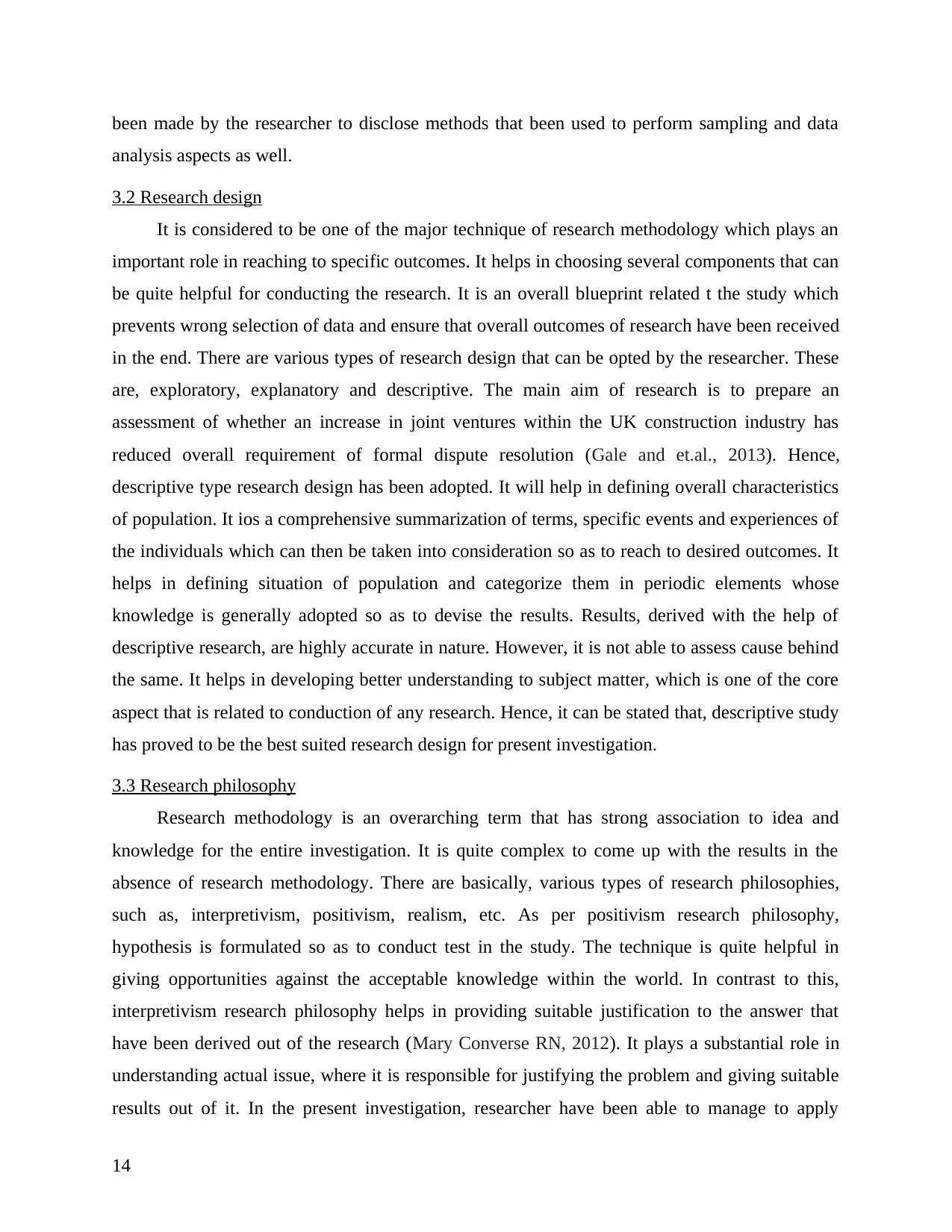
been made by the researcher to disclose methods that been used to perform sampling and data
analysis aspects as well.
3.2 Research design
It is considered to be one of the major technique of research methodology which plays an
important role in reaching to specific outcomes. It helps in choosing several components that can
be quite helpful for conducting the research. It is an overall blueprint related t the study which
prevents wrong selection of data and ensure that overall outcomes of research have been received
in the end. There are various types of research design that can be opted by the researcher. These
are, exploratory, explanatory and descriptive. The main aim of research is to prepare an
assessment of whether an increase in joint ventures within the UK construction industry has
reduced overall requirement of formal dispute resolution (Gale and et.al., 2013). Hence,
descriptive type research design has been adopted. It will help in defining overall characteristics
of population. It ios a comprehensive summarization of terms, specific events and experiences of
the individuals which can then be taken into consideration so as to reach to desired outcomes. It
helps in defining situation of population and categorize them in periodic elements whose
knowledge is generally adopted so as to devise the results. Results, derived with the help of
descriptive research, are highly accurate in nature. However, it is not able to assess cause behind
the same. It helps in developing better understanding to subject matter, which is one of the core
aspect that is related to conduction of any research. Hence, it can be stated that, descriptive study
has proved to be the best suited research design for present investigation.
3.3 Research philosophy
Research methodology is an overarching term that has strong association to idea and
knowledge for the entire investigation. It is quite complex to come up with the results in the
absence of research methodology. There are basically, various types of research philosophies,
such as, interpretivism, positivism, realism, etc. As per positivism research philosophy,
hypothesis is formulated so as to conduct test in the study. The technique is quite helpful in
giving opportunities against the acceptable knowledge within the world. In contrast to this,
interpretivism research philosophy helps in providing suitable justification to the answer that
have been derived out of the research (Mary Converse RN, 2012). It plays a substantial role in
understanding actual issue, where it is responsible for justifying the problem and giving suitable
results out of it. In the present investigation, researcher have been able to manage to apply
14
analysis aspects as well.
3.2 Research design
It is considered to be one of the major technique of research methodology which plays an
important role in reaching to specific outcomes. It helps in choosing several components that can
be quite helpful for conducting the research. It is an overall blueprint related t the study which
prevents wrong selection of data and ensure that overall outcomes of research have been received
in the end. There are various types of research design that can be opted by the researcher. These
are, exploratory, explanatory and descriptive. The main aim of research is to prepare an
assessment of whether an increase in joint ventures within the UK construction industry has
reduced overall requirement of formal dispute resolution (Gale and et.al., 2013). Hence,
descriptive type research design has been adopted. It will help in defining overall characteristics
of population. It ios a comprehensive summarization of terms, specific events and experiences of
the individuals which can then be taken into consideration so as to reach to desired outcomes. It
helps in defining situation of population and categorize them in periodic elements whose
knowledge is generally adopted so as to devise the results. Results, derived with the help of
descriptive research, are highly accurate in nature. However, it is not able to assess cause behind
the same. It helps in developing better understanding to subject matter, which is one of the core
aspect that is related to conduction of any research. Hence, it can be stated that, descriptive study
has proved to be the best suited research design for present investigation.
3.3 Research philosophy
Research methodology is an overarching term that has strong association to idea and
knowledge for the entire investigation. It is quite complex to come up with the results in the
absence of research methodology. There are basically, various types of research philosophies,
such as, interpretivism, positivism, realism, etc. As per positivism research philosophy,
hypothesis is formulated so as to conduct test in the study. The technique is quite helpful in
giving opportunities against the acceptable knowledge within the world. In contrast to this,
interpretivism research philosophy helps in providing suitable justification to the answer that
have been derived out of the research (Mary Converse RN, 2012). It plays a substantial role in
understanding actual issue, where it is responsible for justifying the problem and giving suitable
results out of it. In the present investigation, researcher have been able to manage to apply
14
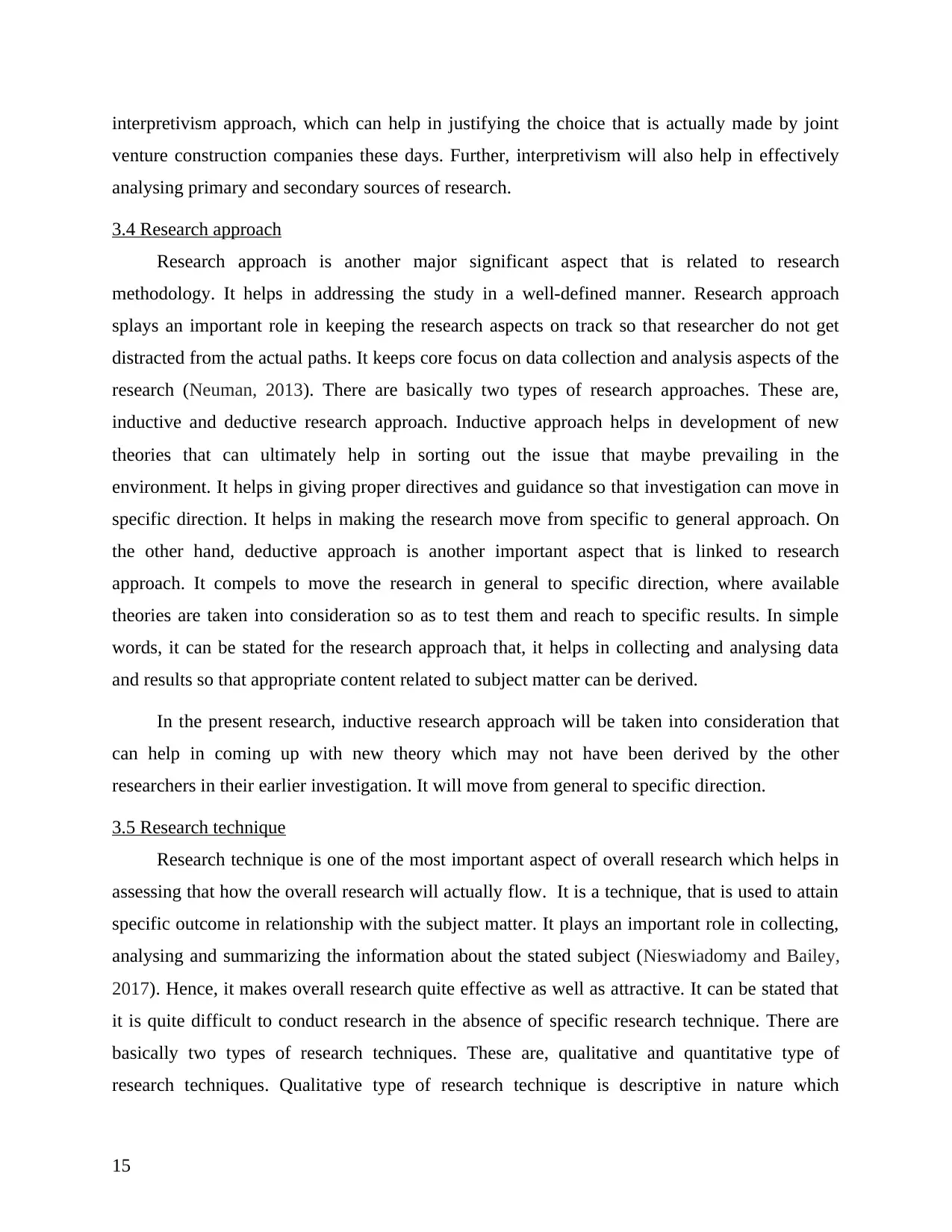
interpretivism approach, which can help in justifying the choice that is actually made by joint
venture construction companies these days. Further, interpretivism will also help in effectively
analysing primary and secondary sources of research.
3.4 Research approach
Research approach is another major significant aspect that is related to research
methodology. It helps in addressing the study in a well-defined manner. Research approach
splays an important role in keeping the research aspects on track so that researcher do not get
distracted from the actual paths. It keeps core focus on data collection and analysis aspects of the
research (Neuman, 2013). There are basically two types of research approaches. These are,
inductive and deductive research approach. Inductive approach helps in development of new
theories that can ultimately help in sorting out the issue that maybe prevailing in the
environment. It helps in giving proper directives and guidance so that investigation can move in
specific direction. It helps in making the research move from specific to general approach. On
the other hand, deductive approach is another important aspect that is linked to research
approach. It compels to move the research in general to specific direction, where available
theories are taken into consideration so as to test them and reach to specific results. In simple
words, it can be stated for the research approach that, it helps in collecting and analysing data
and results so that appropriate content related to subject matter can be derived.
In the present research, inductive research approach will be taken into consideration that
can help in coming up with new theory which may not have been derived by the other
researchers in their earlier investigation. It will move from general to specific direction.
3.5 Research technique
Research technique is one of the most important aspect of overall research which helps in
assessing that how the overall research will actually flow. It is a technique, that is used to attain
specific outcome in relationship with the subject matter. It plays an important role in collecting,
analysing and summarizing the information about the stated subject (Nieswiadomy and Bailey,
2017). Hence, it makes overall research quite effective as well as attractive. It can be stated that
it is quite difficult to conduct research in the absence of specific research technique. There are
basically two types of research techniques. These are, qualitative and quantitative type of
research techniques. Qualitative type of research technique is descriptive in nature which
15
venture construction companies these days. Further, interpretivism will also help in effectively
analysing primary and secondary sources of research.
3.4 Research approach
Research approach is another major significant aspect that is related to research
methodology. It helps in addressing the study in a well-defined manner. Research approach
splays an important role in keeping the research aspects on track so that researcher do not get
distracted from the actual paths. It keeps core focus on data collection and analysis aspects of the
research (Neuman, 2013). There are basically two types of research approaches. These are,
inductive and deductive research approach. Inductive approach helps in development of new
theories that can ultimately help in sorting out the issue that maybe prevailing in the
environment. It helps in giving proper directives and guidance so that investigation can move in
specific direction. It helps in making the research move from specific to general approach. On
the other hand, deductive approach is another important aspect that is linked to research
approach. It compels to move the research in general to specific direction, where available
theories are taken into consideration so as to test them and reach to specific results. In simple
words, it can be stated for the research approach that, it helps in collecting and analysing data
and results so that appropriate content related to subject matter can be derived.
In the present research, inductive research approach will be taken into consideration that
can help in coming up with new theory which may not have been derived by the other
researchers in their earlier investigation. It will move from general to specific direction.
3.5 Research technique
Research technique is one of the most important aspect of overall research which helps in
assessing that how the overall research will actually flow. It is a technique, that is used to attain
specific outcome in relationship with the subject matter. It plays an important role in collecting,
analysing and summarizing the information about the stated subject (Nieswiadomy and Bailey,
2017). Hence, it makes overall research quite effective as well as attractive. It can be stated that
it is quite difficult to conduct research in the absence of specific research technique. There are
basically two types of research techniques. These are, qualitative and quantitative type of
research techniques. Qualitative type of research technique is descriptive in nature which
15
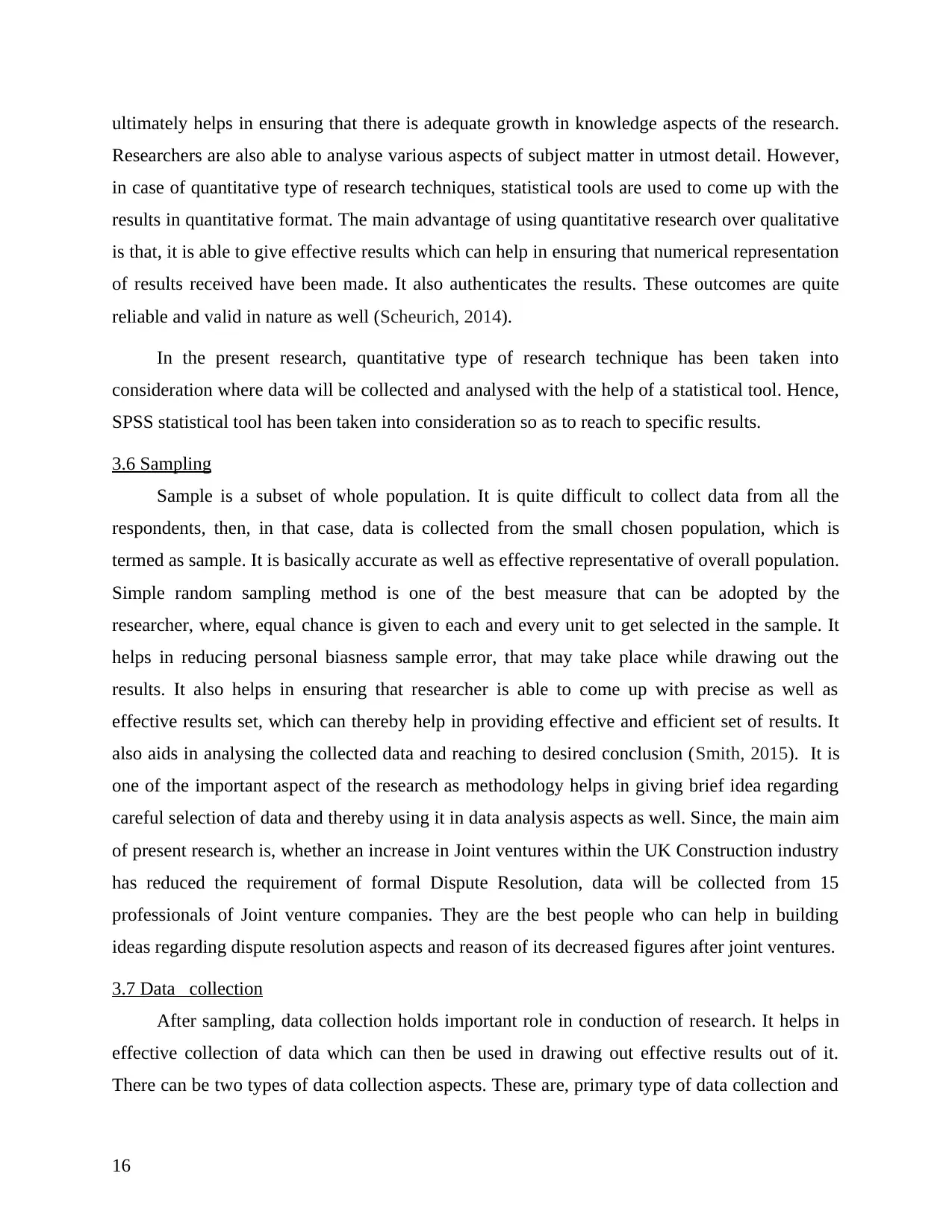
ultimately helps in ensuring that there is adequate growth in knowledge aspects of the research.
Researchers are also able to analyse various aspects of subject matter in utmost detail. However,
in case of quantitative type of research techniques, statistical tools are used to come up with the
results in quantitative format. The main advantage of using quantitative research over qualitative
is that, it is able to give effective results which can help in ensuring that numerical representation
of results received have been made. It also authenticates the results. These outcomes are quite
reliable and valid in nature as well (Scheurich, 2014).
In the present research, quantitative type of research technique has been taken into
consideration where data will be collected and analysed with the help of a statistical tool. Hence,
SPSS statistical tool has been taken into consideration so as to reach to specific results.
3.6 Sampling
Sample is a subset of whole population. It is quite difficult to collect data from all the
respondents, then, in that case, data is collected from the small chosen population, which is
termed as sample. It is basically accurate as well as effective representative of overall population.
Simple random sampling method is one of the best measure that can be adopted by the
researcher, where, equal chance is given to each and every unit to get selected in the sample. It
helps in reducing personal biasness sample error, that may take place while drawing out the
results. It also helps in ensuring that researcher is able to come up with precise as well as
effective results set, which can thereby help in providing effective and efficient set of results. It
also aids in analysing the collected data and reaching to desired conclusion (Smith, 2015). It is
one of the important aspect of the research as methodology helps in giving brief idea regarding
careful selection of data and thereby using it in data analysis aspects as well. Since, the main aim
of present research is, whether an increase in Joint ventures within the UK Construction industry
has reduced the requirement of formal Dispute Resolution, data will be collected from 15
professionals of Joint venture companies. They are the best people who can help in building
ideas regarding dispute resolution aspects and reason of its decreased figures after joint ventures.
3.7 Data collection
After sampling, data collection holds important role in conduction of research. It helps in
effective collection of data which can then be used in drawing out effective results out of it.
There can be two types of data collection aspects. These are, primary type of data collection and
16
Researchers are also able to analyse various aspects of subject matter in utmost detail. However,
in case of quantitative type of research techniques, statistical tools are used to come up with the
results in quantitative format. The main advantage of using quantitative research over qualitative
is that, it is able to give effective results which can help in ensuring that numerical representation
of results received have been made. It also authenticates the results. These outcomes are quite
reliable and valid in nature as well (Scheurich, 2014).
In the present research, quantitative type of research technique has been taken into
consideration where data will be collected and analysed with the help of a statistical tool. Hence,
SPSS statistical tool has been taken into consideration so as to reach to specific results.
3.6 Sampling
Sample is a subset of whole population. It is quite difficult to collect data from all the
respondents, then, in that case, data is collected from the small chosen population, which is
termed as sample. It is basically accurate as well as effective representative of overall population.
Simple random sampling method is one of the best measure that can be adopted by the
researcher, where, equal chance is given to each and every unit to get selected in the sample. It
helps in reducing personal biasness sample error, that may take place while drawing out the
results. It also helps in ensuring that researcher is able to come up with precise as well as
effective results set, which can thereby help in providing effective and efficient set of results. It
also aids in analysing the collected data and reaching to desired conclusion (Smith, 2015). It is
one of the important aspect of the research as methodology helps in giving brief idea regarding
careful selection of data and thereby using it in data analysis aspects as well. Since, the main aim
of present research is, whether an increase in Joint ventures within the UK Construction industry
has reduced the requirement of formal Dispute Resolution, data will be collected from 15
professionals of Joint venture companies. They are the best people who can help in building
ideas regarding dispute resolution aspects and reason of its decreased figures after joint ventures.
3.7 Data collection
After sampling, data collection holds important role in conduction of research. It helps in
effective collection of data which can then be used in drawing out effective results out of it.
There can be two types of data collection aspects. These are, primary type of data collection and
16
Secure Best Marks with AI Grader
Need help grading? Try our AI Grader for instant feedback on your assignments.
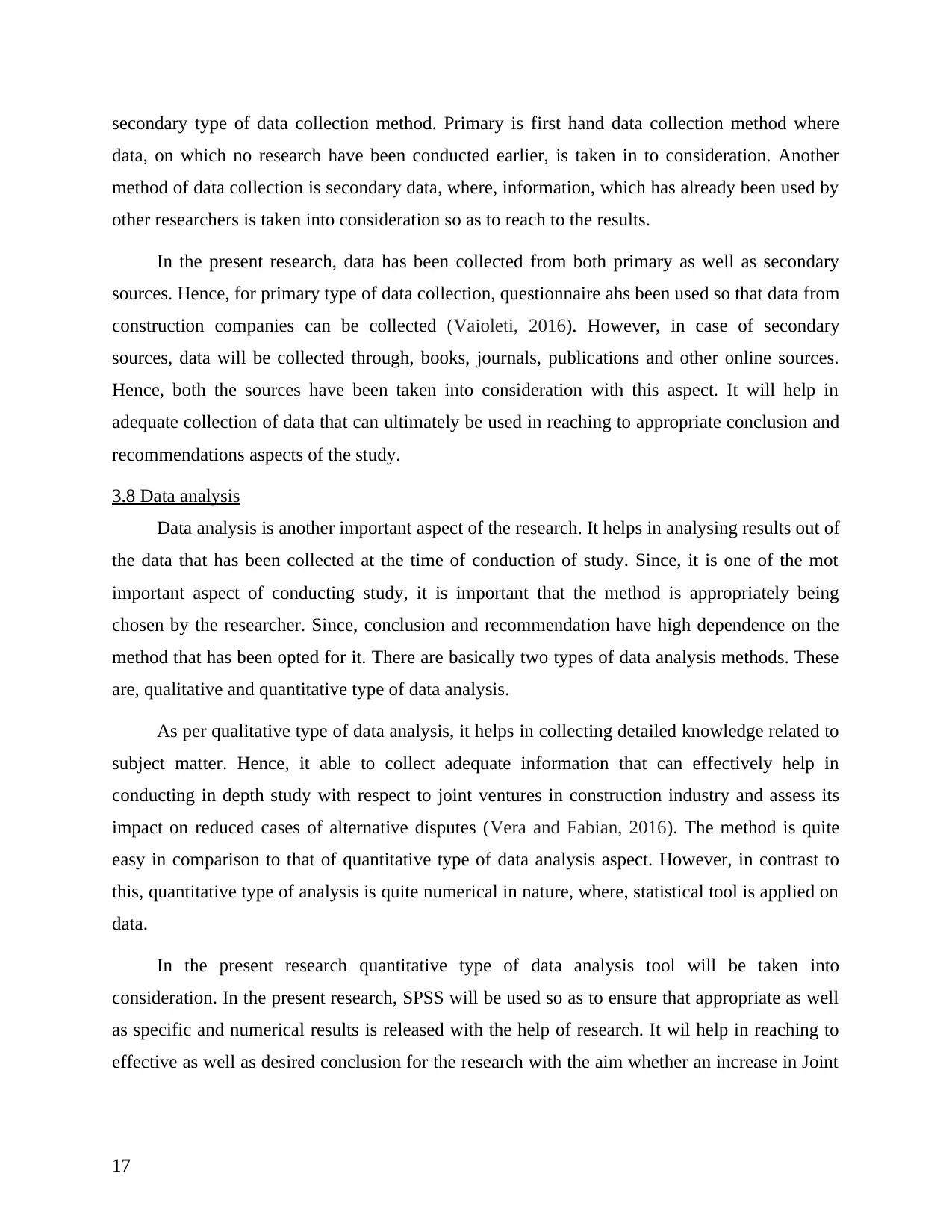
secondary type of data collection method. Primary is first hand data collection method where
data, on which no research have been conducted earlier, is taken in to consideration. Another
method of data collection is secondary data, where, information, which has already been used by
other researchers is taken into consideration so as to reach to the results.
In the present research, data has been collected from both primary as well as secondary
sources. Hence, for primary type of data collection, questionnaire ahs been used so that data from
construction companies can be collected (Vaioleti, 2016). However, in case of secondary
sources, data will be collected through, books, journals, publications and other online sources.
Hence, both the sources have been taken into consideration with this aspect. It will help in
adequate collection of data that can ultimately be used in reaching to appropriate conclusion and
recommendations aspects of the study.
3.8 Data analysis
Data analysis is another important aspect of the research. It helps in analysing results out of
the data that has been collected at the time of conduction of study. Since, it is one of the mot
important aspect of conducting study, it is important that the method is appropriately being
chosen by the researcher. Since, conclusion and recommendation have high dependence on the
method that has been opted for it. There are basically two types of data analysis methods. These
are, qualitative and quantitative type of data analysis.
As per qualitative type of data analysis, it helps in collecting detailed knowledge related to
subject matter. Hence, it able to collect adequate information that can effectively help in
conducting in depth study with respect to joint ventures in construction industry and assess its
impact on reduced cases of alternative disputes (Vera and Fabian, 2016). The method is quite
easy in comparison to that of quantitative type of data analysis aspect. However, in contrast to
this, quantitative type of analysis is quite numerical in nature, where, statistical tool is applied on
data.
In the present research quantitative type of data analysis tool will be taken into
consideration. In the present research, SPSS will be used so as to ensure that appropriate as well
as specific and numerical results is released with the help of research. It wil help in reaching to
effective as well as desired conclusion for the research with the aim whether an increase in Joint
17
data, on which no research have been conducted earlier, is taken in to consideration. Another
method of data collection is secondary data, where, information, which has already been used by
other researchers is taken into consideration so as to reach to the results.
In the present research, data has been collected from both primary as well as secondary
sources. Hence, for primary type of data collection, questionnaire ahs been used so that data from
construction companies can be collected (Vaioleti, 2016). However, in case of secondary
sources, data will be collected through, books, journals, publications and other online sources.
Hence, both the sources have been taken into consideration with this aspect. It will help in
adequate collection of data that can ultimately be used in reaching to appropriate conclusion and
recommendations aspects of the study.
3.8 Data analysis
Data analysis is another important aspect of the research. It helps in analysing results out of
the data that has been collected at the time of conduction of study. Since, it is one of the mot
important aspect of conducting study, it is important that the method is appropriately being
chosen by the researcher. Since, conclusion and recommendation have high dependence on the
method that has been opted for it. There are basically two types of data analysis methods. These
are, qualitative and quantitative type of data analysis.
As per qualitative type of data analysis, it helps in collecting detailed knowledge related to
subject matter. Hence, it able to collect adequate information that can effectively help in
conducting in depth study with respect to joint ventures in construction industry and assess its
impact on reduced cases of alternative disputes (Vera and Fabian, 2016). The method is quite
easy in comparison to that of quantitative type of data analysis aspect. However, in contrast to
this, quantitative type of analysis is quite numerical in nature, where, statistical tool is applied on
data.
In the present research quantitative type of data analysis tool will be taken into
consideration. In the present research, SPSS will be used so as to ensure that appropriate as well
as specific and numerical results is released with the help of research. It wil help in reaching to
effective as well as desired conclusion for the research with the aim whether an increase in Joint
17
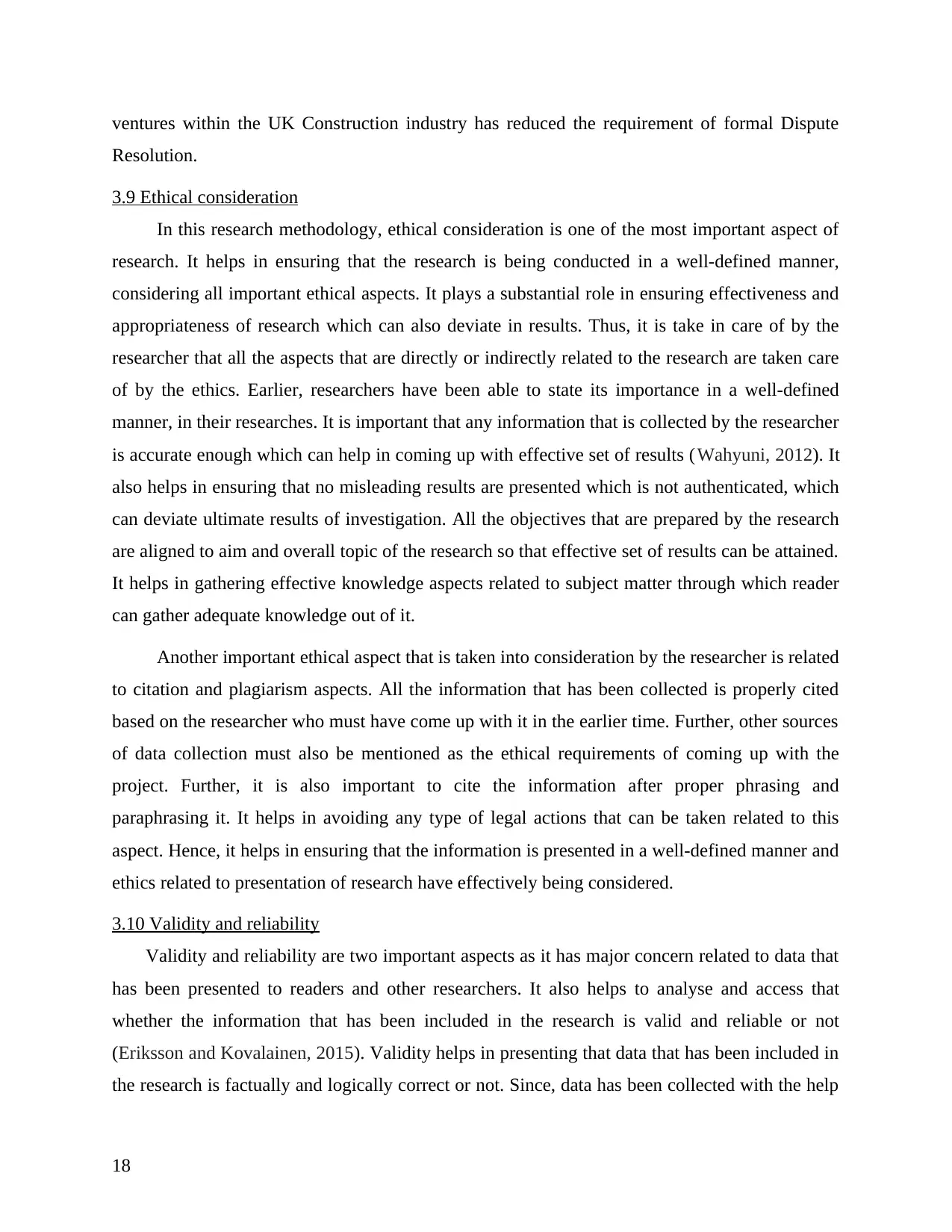
ventures within the UK Construction industry has reduced the requirement of formal Dispute
Resolution.
3.9 Ethical consideration
In this research methodology, ethical consideration is one of the most important aspect of
research. It helps in ensuring that the research is being conducted in a well-defined manner,
considering all important ethical aspects. It plays a substantial role in ensuring effectiveness and
appropriateness of research which can also deviate in results. Thus, it is take in care of by the
researcher that all the aspects that are directly or indirectly related to the research are taken care
of by the ethics. Earlier, researchers have been able to state its importance in a well-defined
manner, in their researches. It is important that any information that is collected by the researcher
is accurate enough which can help in coming up with effective set of results (Wahyuni, 2012). It
also helps in ensuring that no misleading results are presented which is not authenticated, which
can deviate ultimate results of investigation. All the objectives that are prepared by the research
are aligned to aim and overall topic of the research so that effective set of results can be attained.
It helps in gathering effective knowledge aspects related to subject matter through which reader
can gather adequate knowledge out of it.
Another important ethical aspect that is taken into consideration by the researcher is related
to citation and plagiarism aspects. All the information that has been collected is properly cited
based on the researcher who must have come up with it in the earlier time. Further, other sources
of data collection must also be mentioned as the ethical requirements of coming up with the
project. Further, it is also important to cite the information after proper phrasing and
paraphrasing it. It helps in avoiding any type of legal actions that can be taken related to this
aspect. Hence, it helps in ensuring that the information is presented in a well-defined manner and
ethics related to presentation of research have effectively being considered.
3.10 Validity and reliability
Validity and reliability are two important aspects as it has major concern related to data that
has been presented to readers and other researchers. It also helps to analyse and access that
whether the information that has been included in the research is valid and reliable or not
(Eriksson and Kovalainen, 2015). Validity helps in presenting that data that has been included in
the research is factually and logically correct or not. Since, data has been collected with the help
18
Resolution.
3.9 Ethical consideration
In this research methodology, ethical consideration is one of the most important aspect of
research. It helps in ensuring that the research is being conducted in a well-defined manner,
considering all important ethical aspects. It plays a substantial role in ensuring effectiveness and
appropriateness of research which can also deviate in results. Thus, it is take in care of by the
researcher that all the aspects that are directly or indirectly related to the research are taken care
of by the ethics. Earlier, researchers have been able to state its importance in a well-defined
manner, in their researches. It is important that any information that is collected by the researcher
is accurate enough which can help in coming up with effective set of results (Wahyuni, 2012). It
also helps in ensuring that no misleading results are presented which is not authenticated, which
can deviate ultimate results of investigation. All the objectives that are prepared by the research
are aligned to aim and overall topic of the research so that effective set of results can be attained.
It helps in gathering effective knowledge aspects related to subject matter through which reader
can gather adequate knowledge out of it.
Another important ethical aspect that is taken into consideration by the researcher is related
to citation and plagiarism aspects. All the information that has been collected is properly cited
based on the researcher who must have come up with it in the earlier time. Further, other sources
of data collection must also be mentioned as the ethical requirements of coming up with the
project. Further, it is also important to cite the information after proper phrasing and
paraphrasing it. It helps in avoiding any type of legal actions that can be taken related to this
aspect. Hence, it helps in ensuring that the information is presented in a well-defined manner and
ethics related to presentation of research have effectively being considered.
3.10 Validity and reliability
Validity and reliability are two important aspects as it has major concern related to data that
has been presented to readers and other researchers. It also helps to analyse and access that
whether the information that has been included in the research is valid and reliable or not
(Eriksson and Kovalainen, 2015). Validity helps in presenting that data that has been included in
the research is factually and logically correct or not. Since, data has been collected with the help
18
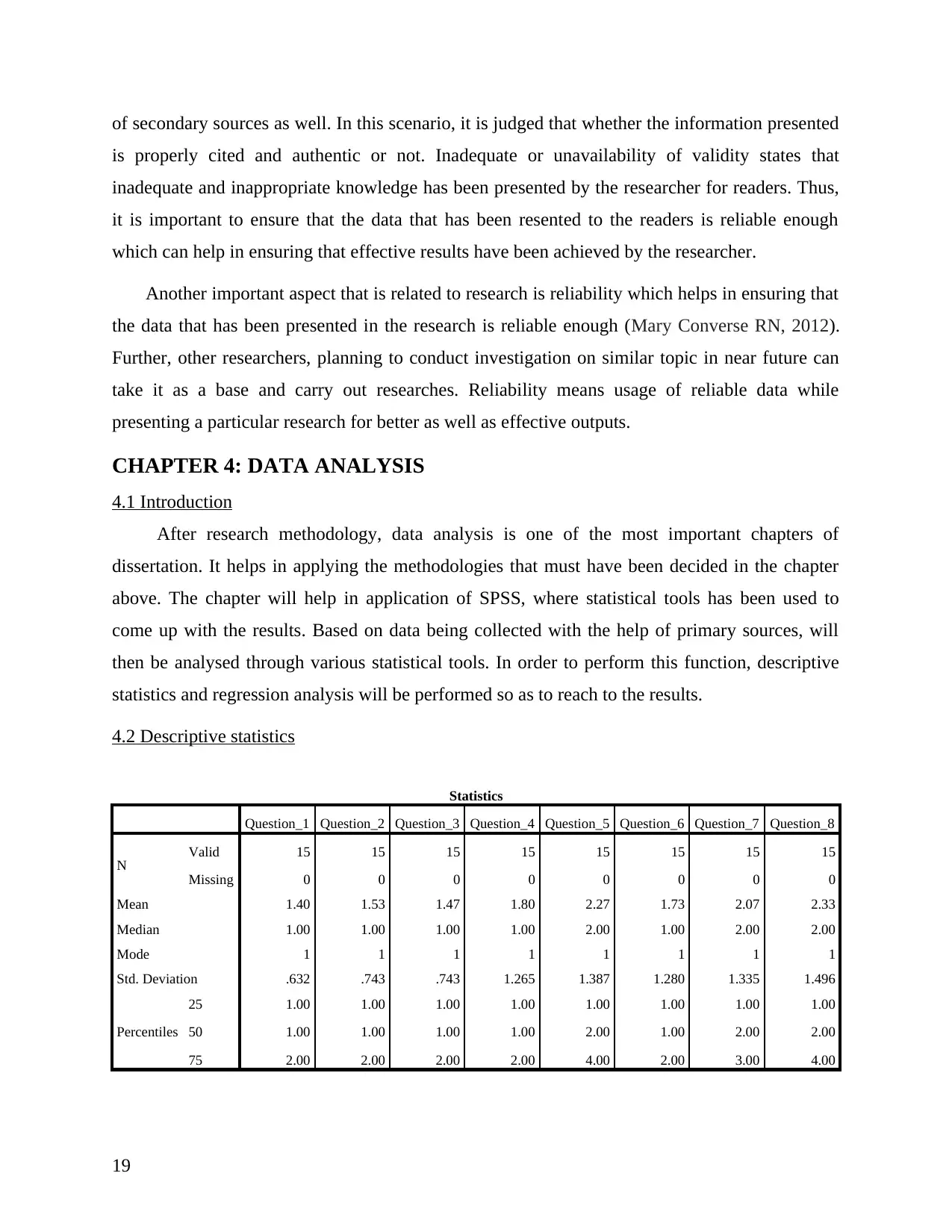
of secondary sources as well. In this scenario, it is judged that whether the information presented
is properly cited and authentic or not. Inadequate or unavailability of validity states that
inadequate and inappropriate knowledge has been presented by the researcher for readers. Thus,
it is important to ensure that the data that has been resented to the readers is reliable enough
which can help in ensuring that effective results have been achieved by the researcher.
Another important aspect that is related to research is reliability which helps in ensuring that
the data that has been presented in the research is reliable enough (Mary Converse RN, 2012).
Further, other researchers, planning to conduct investigation on similar topic in near future can
take it as a base and carry out researches. Reliability means usage of reliable data while
presenting a particular research for better as well as effective outputs.
CHAPTER 4: DATA ANALYSIS
4.1 Introduction
After research methodology, data analysis is one of the most important chapters of
dissertation. It helps in applying the methodologies that must have been decided in the chapter
above. The chapter will help in application of SPSS, where statistical tools has been used to
come up with the results. Based on data being collected with the help of primary sources, will
then be analysed through various statistical tools. In order to perform this function, descriptive
statistics and regression analysis will be performed so as to reach to the results.
4.2 Descriptive statistics
Statistics
Question_1 Question_2 Question_3 Question_4 Question_5 Question_6 Question_7 Question_8
N Valid 15 15 15 15 15 15 15 15
Missing 0 0 0 0 0 0 0 0
Mean 1.40 1.53 1.47 1.80 2.27 1.73 2.07 2.33
Median 1.00 1.00 1.00 1.00 2.00 1.00 2.00 2.00
Mode 1 1 1 1 1 1 1 1
Std. Deviation .632 .743 .743 1.265 1.387 1.280 1.335 1.496
Percentiles
25 1.00 1.00 1.00 1.00 1.00 1.00 1.00 1.00
50 1.00 1.00 1.00 1.00 2.00 1.00 2.00 2.00
75 2.00 2.00 2.00 2.00 4.00 2.00 3.00 4.00
19
is properly cited and authentic or not. Inadequate or unavailability of validity states that
inadequate and inappropriate knowledge has been presented by the researcher for readers. Thus,
it is important to ensure that the data that has been resented to the readers is reliable enough
which can help in ensuring that effective results have been achieved by the researcher.
Another important aspect that is related to research is reliability which helps in ensuring that
the data that has been presented in the research is reliable enough (Mary Converse RN, 2012).
Further, other researchers, planning to conduct investigation on similar topic in near future can
take it as a base and carry out researches. Reliability means usage of reliable data while
presenting a particular research for better as well as effective outputs.
CHAPTER 4: DATA ANALYSIS
4.1 Introduction
After research methodology, data analysis is one of the most important chapters of
dissertation. It helps in applying the methodologies that must have been decided in the chapter
above. The chapter will help in application of SPSS, where statistical tools has been used to
come up with the results. Based on data being collected with the help of primary sources, will
then be analysed through various statistical tools. In order to perform this function, descriptive
statistics and regression analysis will be performed so as to reach to the results.
4.2 Descriptive statistics
Statistics
Question_1 Question_2 Question_3 Question_4 Question_5 Question_6 Question_7 Question_8
N Valid 15 15 15 15 15 15 15 15
Missing 0 0 0 0 0 0 0 0
Mean 1.40 1.53 1.47 1.80 2.27 1.73 2.07 2.33
Median 1.00 1.00 1.00 1.00 2.00 1.00 2.00 2.00
Mode 1 1 1 1 1 1 1 1
Std. Deviation .632 .743 .743 1.265 1.387 1.280 1.335 1.496
Percentiles
25 1.00 1.00 1.00 1.00 1.00 1.00 1.00 1.00
50 1.00 1.00 1.00 1.00 2.00 1.00 2.00 2.00
75 2.00 2.00 2.00 2.00 4.00 2.00 3.00 4.00
19
Paraphrase This Document
Need a fresh take? Get an instant paraphrase of this document with our AI Paraphraser
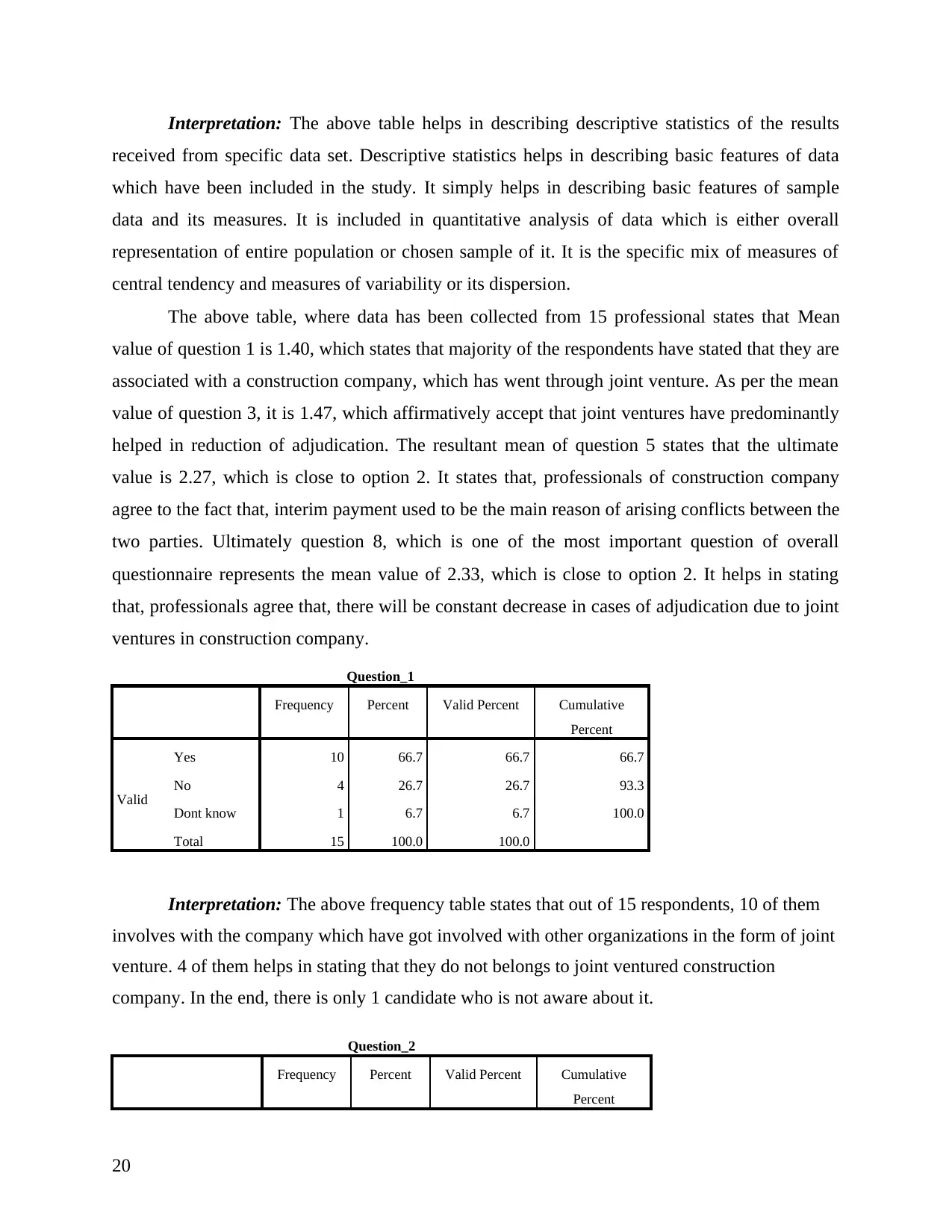
Interpretation: The above table helps in describing descriptive statistics of the results
received from specific data set. Descriptive statistics helps in describing basic features of data
which have been included in the study. It simply helps in describing basic features of sample
data and its measures. It is included in quantitative analysis of data which is either overall
representation of entire population or chosen sample of it. It is the specific mix of measures of
central tendency and measures of variability or its dispersion.
The above table, where data has been collected from 15 professional states that Mean
value of question 1 is 1.40, which states that majority of the respondents have stated that they are
associated with a construction company, which has went through joint venture. As per the mean
value of question 3, it is 1.47, which affirmatively accept that joint ventures have predominantly
helped in reduction of adjudication. The resultant mean of question 5 states that the ultimate
value is 2.27, which is close to option 2. It states that, professionals of construction company
agree to the fact that, interim payment used to be the main reason of arising conflicts between the
two parties. Ultimately question 8, which is one of the most important question of overall
questionnaire represents the mean value of 2.33, which is close to option 2. It helps in stating
that, professionals agree that, there will be constant decrease in cases of adjudication due to joint
ventures in construction company.
Question_1
Frequency Percent Valid Percent Cumulative
Percent
Valid
Yes 10 66.7 66.7 66.7
No 4 26.7 26.7 93.3
Dont know 1 6.7 6.7 100.0
Total 15 100.0 100.0
Interpretation: The above frequency table states that out of 15 respondents, 10 of them
involves with the company which have got involved with other organizations in the form of joint
venture. 4 of them helps in stating that they do not belongs to joint ventured construction
company. In the end, there is only 1 candidate who is not aware about it.
Question_2
Frequency Percent Valid Percent Cumulative
Percent
20
received from specific data set. Descriptive statistics helps in describing basic features of data
which have been included in the study. It simply helps in describing basic features of sample
data and its measures. It is included in quantitative analysis of data which is either overall
representation of entire population or chosen sample of it. It is the specific mix of measures of
central tendency and measures of variability or its dispersion.
The above table, where data has been collected from 15 professional states that Mean
value of question 1 is 1.40, which states that majority of the respondents have stated that they are
associated with a construction company, which has went through joint venture. As per the mean
value of question 3, it is 1.47, which affirmatively accept that joint ventures have predominantly
helped in reduction of adjudication. The resultant mean of question 5 states that the ultimate
value is 2.27, which is close to option 2. It states that, professionals of construction company
agree to the fact that, interim payment used to be the main reason of arising conflicts between the
two parties. Ultimately question 8, which is one of the most important question of overall
questionnaire represents the mean value of 2.33, which is close to option 2. It helps in stating
that, professionals agree that, there will be constant decrease in cases of adjudication due to joint
ventures in construction company.
Question_1
Frequency Percent Valid Percent Cumulative
Percent
Valid
Yes 10 66.7 66.7 66.7
No 4 26.7 26.7 93.3
Dont know 1 6.7 6.7 100.0
Total 15 100.0 100.0
Interpretation: The above frequency table states that out of 15 respondents, 10 of them
involves with the company which have got involved with other organizations in the form of joint
venture. 4 of them helps in stating that they do not belongs to joint ventured construction
company. In the end, there is only 1 candidate who is not aware about it.
Question_2
Frequency Percent Valid Percent Cumulative
Percent
20
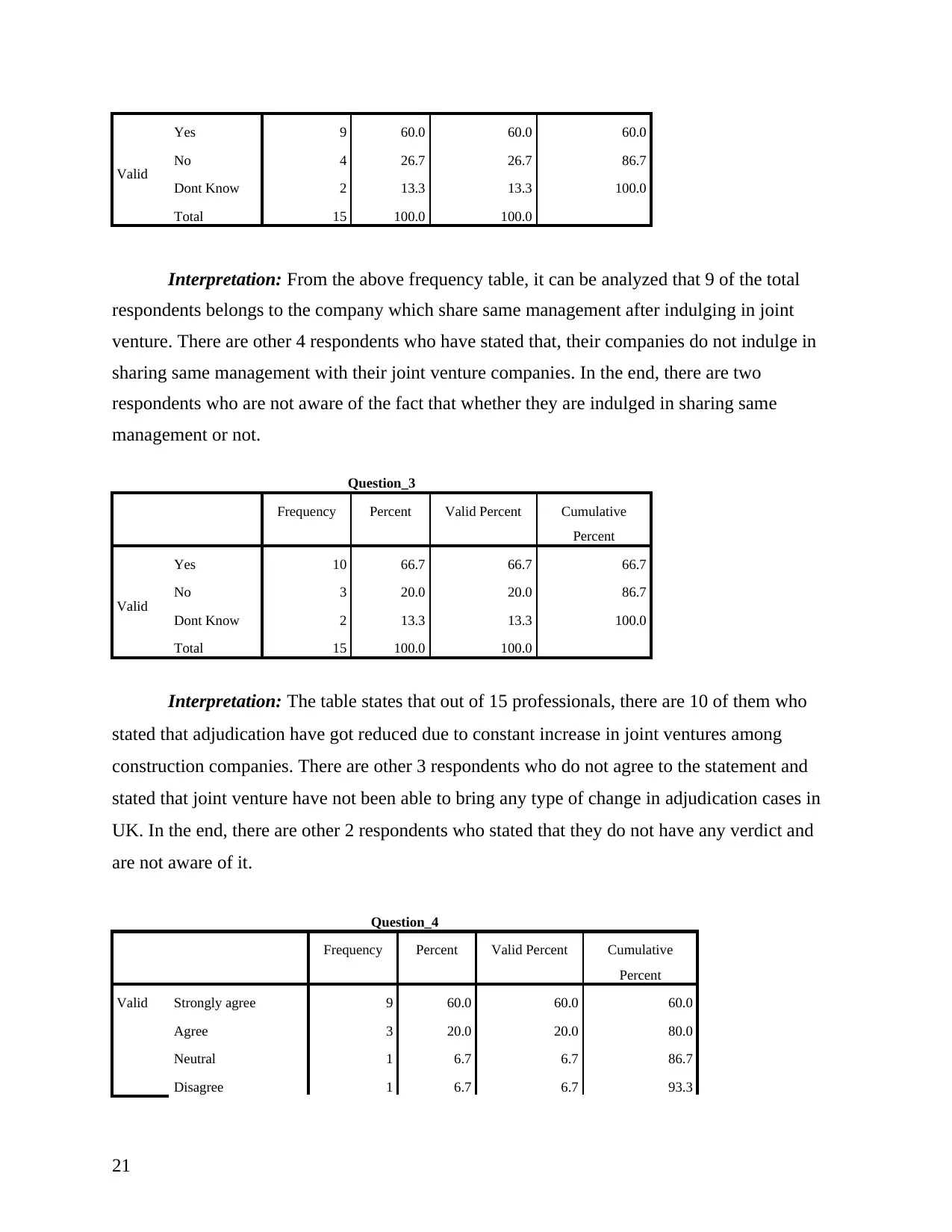
Valid
Yes 9 60.0 60.0 60.0
No 4 26.7 26.7 86.7
Dont Know 2 13.3 13.3 100.0
Total 15 100.0 100.0
Interpretation: From the above frequency table, it can be analyzed that 9 of the total
respondents belongs to the company which share same management after indulging in joint
venture. There are other 4 respondents who have stated that, their companies do not indulge in
sharing same management with their joint venture companies. In the end, there are two
respondents who are not aware of the fact that whether they are indulged in sharing same
management or not.
Question_3
Frequency Percent Valid Percent Cumulative
Percent
Valid
Yes 10 66.7 66.7 66.7
No 3 20.0 20.0 86.7
Dont Know 2 13.3 13.3 100.0
Total 15 100.0 100.0
Interpretation: The table states that out of 15 professionals, there are 10 of them who
stated that adjudication have got reduced due to constant increase in joint ventures among
construction companies. There are other 3 respondents who do not agree to the statement and
stated that joint venture have not been able to bring any type of change in adjudication cases in
UK. In the end, there are other 2 respondents who stated that they do not have any verdict and
are not aware of it.
Question_4
Frequency Percent Valid Percent Cumulative
Percent
Valid Strongly agree 9 60.0 60.0 60.0
Agree 3 20.0 20.0 80.0
Neutral 1 6.7 6.7 86.7
Disagree 1 6.7 6.7 93.3
21
Yes 9 60.0 60.0 60.0
No 4 26.7 26.7 86.7
Dont Know 2 13.3 13.3 100.0
Total 15 100.0 100.0
Interpretation: From the above frequency table, it can be analyzed that 9 of the total
respondents belongs to the company which share same management after indulging in joint
venture. There are other 4 respondents who have stated that, their companies do not indulge in
sharing same management with their joint venture companies. In the end, there are two
respondents who are not aware of the fact that whether they are indulged in sharing same
management or not.
Question_3
Frequency Percent Valid Percent Cumulative
Percent
Valid
Yes 10 66.7 66.7 66.7
No 3 20.0 20.0 86.7
Dont Know 2 13.3 13.3 100.0
Total 15 100.0 100.0
Interpretation: The table states that out of 15 professionals, there are 10 of them who
stated that adjudication have got reduced due to constant increase in joint ventures among
construction companies. There are other 3 respondents who do not agree to the statement and
stated that joint venture have not been able to bring any type of change in adjudication cases in
UK. In the end, there are other 2 respondents who stated that they do not have any verdict and
are not aware of it.
Question_4
Frequency Percent Valid Percent Cumulative
Percent
Valid Strongly agree 9 60.0 60.0 60.0
Agree 3 20.0 20.0 80.0
Neutral 1 6.7 6.7 86.7
Disagree 1 6.7 6.7 93.3
21
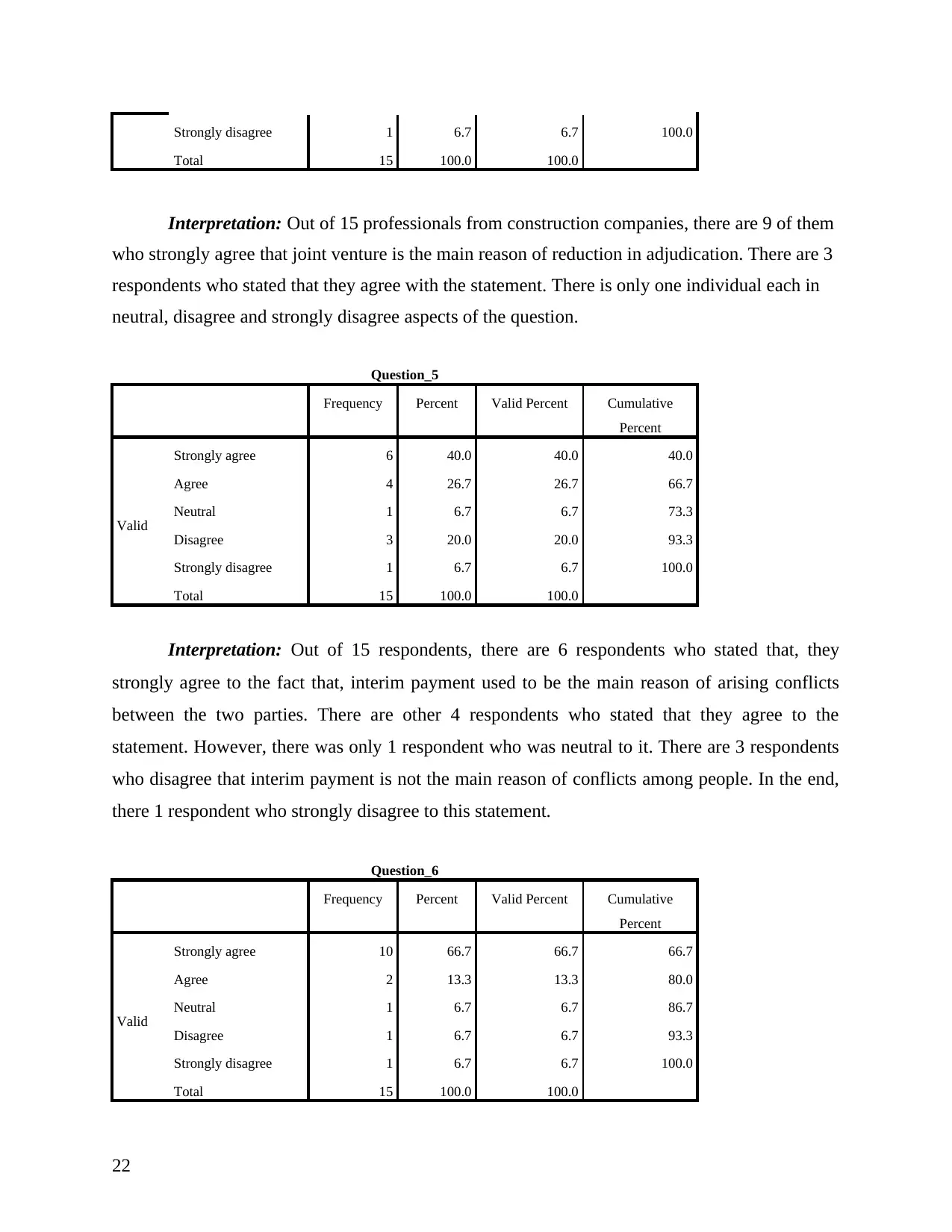
Strongly disagree 1 6.7 6.7 100.0
Total 15 100.0 100.0
Interpretation: Out of 15 professionals from construction companies, there are 9 of them
who strongly agree that joint venture is the main reason of reduction in adjudication. There are 3
respondents who stated that they agree with the statement. There is only one individual each in
neutral, disagree and strongly disagree aspects of the question.
Question_5
Frequency Percent Valid Percent Cumulative
Percent
Valid
Strongly agree 6 40.0 40.0 40.0
Agree 4 26.7 26.7 66.7
Neutral 1 6.7 6.7 73.3
Disagree 3 20.0 20.0 93.3
Strongly disagree 1 6.7 6.7 100.0
Total 15 100.0 100.0
Interpretation: Out of 15 respondents, there are 6 respondents who stated that, they
strongly agree to the fact that, interim payment used to be the main reason of arising conflicts
between the two parties. There are other 4 respondents who stated that they agree to the
statement. However, there was only 1 respondent who was neutral to it. There are 3 respondents
who disagree that interim payment is not the main reason of conflicts among people. In the end,
there 1 respondent who strongly disagree to this statement.
Question_6
Frequency Percent Valid Percent Cumulative
Percent
Valid
Strongly agree 10 66.7 66.7 66.7
Agree 2 13.3 13.3 80.0
Neutral 1 6.7 6.7 86.7
Disagree 1 6.7 6.7 93.3
Strongly disagree 1 6.7 6.7 100.0
Total 15 100.0 100.0
22
Total 15 100.0 100.0
Interpretation: Out of 15 professionals from construction companies, there are 9 of them
who strongly agree that joint venture is the main reason of reduction in adjudication. There are 3
respondents who stated that they agree with the statement. There is only one individual each in
neutral, disagree and strongly disagree aspects of the question.
Question_5
Frequency Percent Valid Percent Cumulative
Percent
Valid
Strongly agree 6 40.0 40.0 40.0
Agree 4 26.7 26.7 66.7
Neutral 1 6.7 6.7 73.3
Disagree 3 20.0 20.0 93.3
Strongly disagree 1 6.7 6.7 100.0
Total 15 100.0 100.0
Interpretation: Out of 15 respondents, there are 6 respondents who stated that, they
strongly agree to the fact that, interim payment used to be the main reason of arising conflicts
between the two parties. There are other 4 respondents who stated that they agree to the
statement. However, there was only 1 respondent who was neutral to it. There are 3 respondents
who disagree that interim payment is not the main reason of conflicts among people. In the end,
there 1 respondent who strongly disagree to this statement.
Question_6
Frequency Percent Valid Percent Cumulative
Percent
Valid
Strongly agree 10 66.7 66.7 66.7
Agree 2 13.3 13.3 80.0
Neutral 1 6.7 6.7 86.7
Disagree 1 6.7 6.7 93.3
Strongly disagree 1 6.7 6.7 100.0
Total 15 100.0 100.0
22
Secure Best Marks with AI Grader
Need help grading? Try our AI Grader for instant feedback on your assignments.
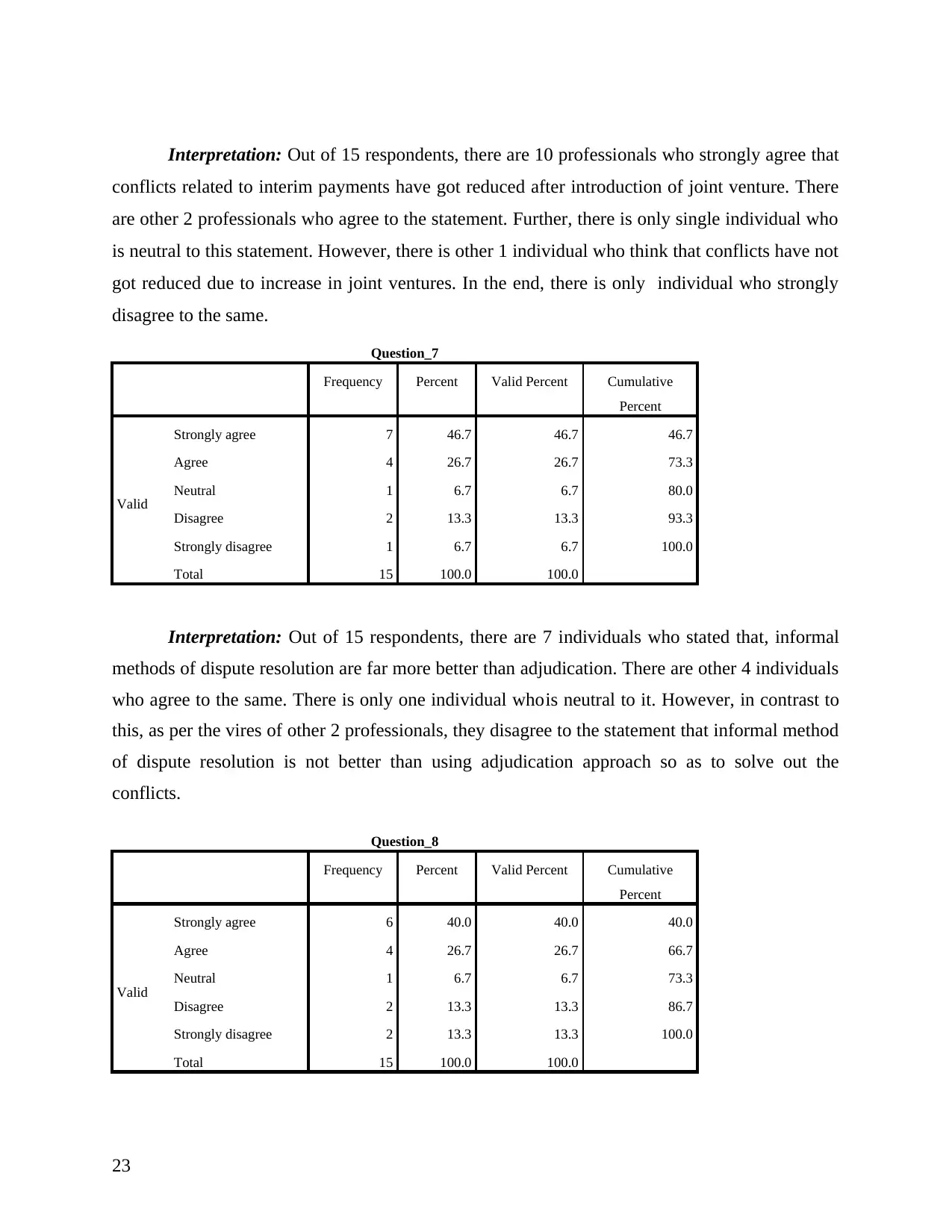
Interpretation: Out of 15 respondents, there are 10 professionals who strongly agree that
conflicts related to interim payments have got reduced after introduction of joint venture. There
are other 2 professionals who agree to the statement. Further, there is only single individual who
is neutral to this statement. However, there is other 1 individual who think that conflicts have not
got reduced due to increase in joint ventures. In the end, there is only individual who strongly
disagree to the same.
Question_7
Frequency Percent Valid Percent Cumulative
Percent
Valid
Strongly agree 7 46.7 46.7 46.7
Agree 4 26.7 26.7 73.3
Neutral 1 6.7 6.7 80.0
Disagree 2 13.3 13.3 93.3
Strongly disagree 1 6.7 6.7 100.0
Total 15 100.0 100.0
Interpretation: Out of 15 respondents, there are 7 individuals who stated that, informal
methods of dispute resolution are far more better than adjudication. There are other 4 individuals
who agree to the same. There is only one individual whois neutral to it. However, in contrast to
this, as per the vires of other 2 professionals, they disagree to the statement that informal method
of dispute resolution is not better than using adjudication approach so as to solve out the
conflicts.
Question_8
Frequency Percent Valid Percent Cumulative
Percent
Valid
Strongly agree 6 40.0 40.0 40.0
Agree 4 26.7 26.7 66.7
Neutral 1 6.7 6.7 73.3
Disagree 2 13.3 13.3 86.7
Strongly disagree 2 13.3 13.3 100.0
Total 15 100.0 100.0
23
conflicts related to interim payments have got reduced after introduction of joint venture. There
are other 2 professionals who agree to the statement. Further, there is only single individual who
is neutral to this statement. However, there is other 1 individual who think that conflicts have not
got reduced due to increase in joint ventures. In the end, there is only individual who strongly
disagree to the same.
Question_7
Frequency Percent Valid Percent Cumulative
Percent
Valid
Strongly agree 7 46.7 46.7 46.7
Agree 4 26.7 26.7 73.3
Neutral 1 6.7 6.7 80.0
Disagree 2 13.3 13.3 93.3
Strongly disagree 1 6.7 6.7 100.0
Total 15 100.0 100.0
Interpretation: Out of 15 respondents, there are 7 individuals who stated that, informal
methods of dispute resolution are far more better than adjudication. There are other 4 individuals
who agree to the same. There is only one individual whois neutral to it. However, in contrast to
this, as per the vires of other 2 professionals, they disagree to the statement that informal method
of dispute resolution is not better than using adjudication approach so as to solve out the
conflicts.
Question_8
Frequency Percent Valid Percent Cumulative
Percent
Valid
Strongly agree 6 40.0 40.0 40.0
Agree 4 26.7 26.7 66.7
Neutral 1 6.7 6.7 73.3
Disagree 2 13.3 13.3 86.7
Strongly disagree 2 13.3 13.3 100.0
Total 15 100.0 100.0
23

Interpretation: Out of 15 respondents, there are 6 professionals from construction
companies who stated that they strongly agree to the fact that, there will be constant decrease in
cases of adjudication due to joint ventures in construction company. Further, there are other 4
individuals, who think that they agree to the same. Further, there is only one individual who is
neutral to the statement. However, in contrast to this, there are 2 respondents, who disagree to it
and stated that there will be no further decrease in adjudication due to increase in joint ventures
of construction companies. There are 2 respondents who strongly disagrees to it.
Regression Analysis
In order to apply regression analysis, following hypothesis can be framed:
H0 = Conflicts due to interim payment have plays no significant role in decrease in cases of
adjudication for joint ventured companies.
H 1 = Conflicts due to interim payment have plays significant role in decrease in cases of
adjudication for joint ventured companies.
Based on the hypothesis being framed above, regression analysis can be performed in the
following manner:
Model Summary
Model R R Square Adjusted R
Square
Std. Error of the
Estimate
1 .912a .833 .805 .661
a. Predictors: (Constant), Question_6, Question_5
ANOVAa
Model Sum of Squares df Mean Square F Sig.
1
Regression 26.088 2 13.044 29.840 .000b
Residual 5.245 12 .437
Total 31.333 14
a. Dependent Variable: Question_8
b. Predictors: (Constant), Question_6, Question_5
24
companies who stated that they strongly agree to the fact that, there will be constant decrease in
cases of adjudication due to joint ventures in construction company. Further, there are other 4
individuals, who think that they agree to the same. Further, there is only one individual who is
neutral to the statement. However, in contrast to this, there are 2 respondents, who disagree to it
and stated that there will be no further decrease in adjudication due to increase in joint ventures
of construction companies. There are 2 respondents who strongly disagrees to it.
Regression Analysis
In order to apply regression analysis, following hypothesis can be framed:
H0 = Conflicts due to interim payment have plays no significant role in decrease in cases of
adjudication for joint ventured companies.
H 1 = Conflicts due to interim payment have plays significant role in decrease in cases of
adjudication for joint ventured companies.
Based on the hypothesis being framed above, regression analysis can be performed in the
following manner:
Model Summary
Model R R Square Adjusted R
Square
Std. Error of the
Estimate
1 .912a .833 .805 .661
a. Predictors: (Constant), Question_6, Question_5
ANOVAa
Model Sum of Squares df Mean Square F Sig.
1
Regression 26.088 2 13.044 29.840 .000b
Residual 5.245 12 .437
Total 31.333 14
a. Dependent Variable: Question_8
b. Predictors: (Constant), Question_6, Question_5
24
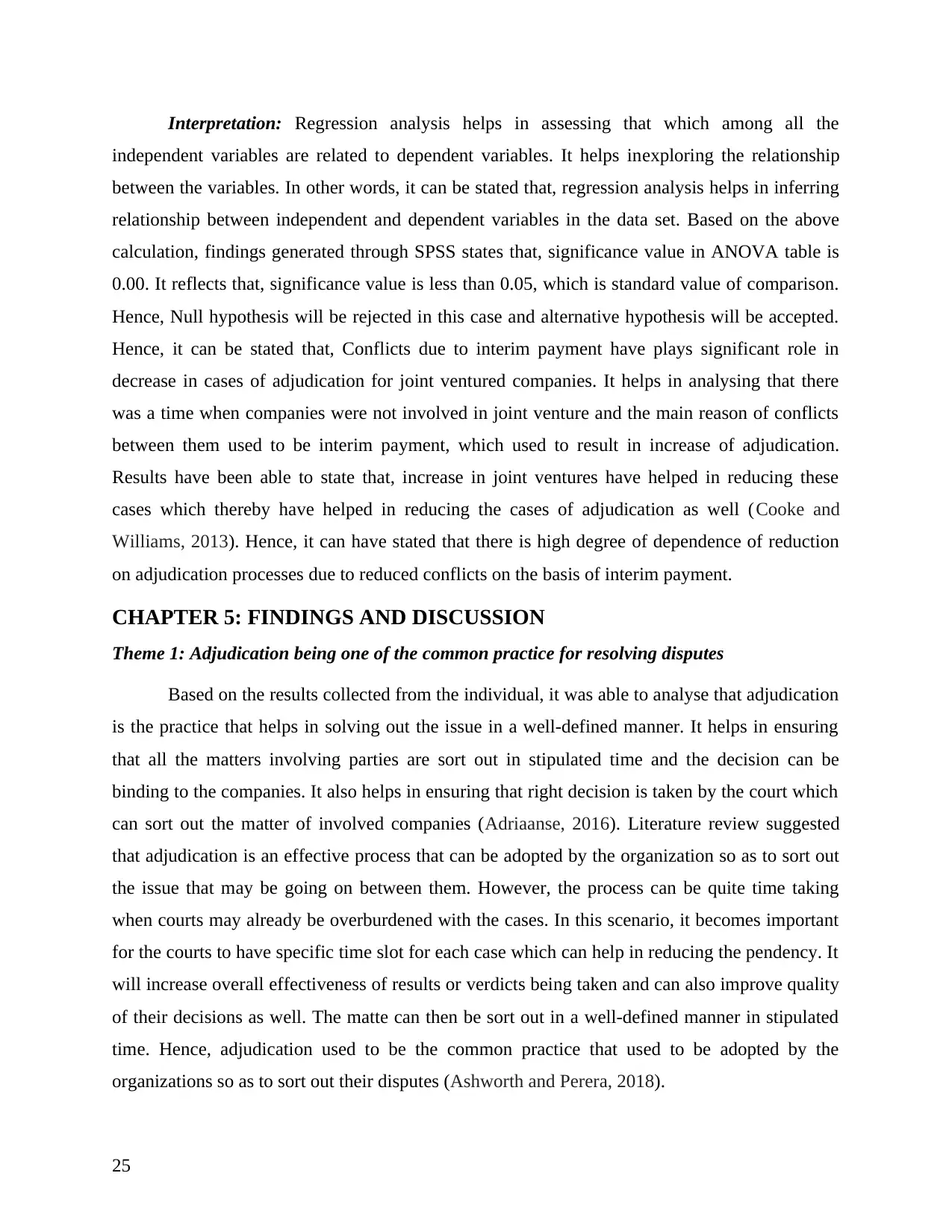
Interpretation: Regression analysis helps in assessing that which among all the
independent variables are related to dependent variables. It helps inexploring the relationship
between the variables. In other words, it can be stated that, regression analysis helps in inferring
relationship between independent and dependent variables in the data set. Based on the above
calculation, findings generated through SPSS states that, significance value in ANOVA table is
0.00. It reflects that, significance value is less than 0.05, which is standard value of comparison.
Hence, Null hypothesis will be rejected in this case and alternative hypothesis will be accepted.
Hence, it can be stated that, Conflicts due to interim payment have plays significant role in
decrease in cases of adjudication for joint ventured companies. It helps in analysing that there
was a time when companies were not involved in joint venture and the main reason of conflicts
between them used to be interim payment, which used to result in increase of adjudication.
Results have been able to state that, increase in joint ventures have helped in reducing these
cases which thereby have helped in reducing the cases of adjudication as well (Cooke and
Williams, 2013). Hence, it can have stated that there is high degree of dependence of reduction
on adjudication processes due to reduced conflicts on the basis of interim payment.
CHAPTER 5: FINDINGS AND DISCUSSION
Theme 1: Adjudication being one of the common practice for resolving disputes
Based on the results collected from the individual, it was able to analyse that adjudication
is the practice that helps in solving out the issue in a well-defined manner. It helps in ensuring
that all the matters involving parties are sort out in stipulated time and the decision can be
binding to the companies. It also helps in ensuring that right decision is taken by the court which
can sort out the matter of involved companies (Adriaanse, 2016). Literature review suggested
that adjudication is an effective process that can be adopted by the organization so as to sort out
the issue that may be going on between them. However, the process can be quite time taking
when courts may already be overburdened with the cases. In this scenario, it becomes important
for the courts to have specific time slot for each case which can help in reducing the pendency. It
will increase overall effectiveness of results or verdicts being taken and can also improve quality
of their decisions as well. The matte can then be sort out in a well-defined manner in stipulated
time. Hence, adjudication used to be the common practice that used to be adopted by the
organizations so as to sort out their disputes (Ashworth and Perera, 2018).
25
independent variables are related to dependent variables. It helps inexploring the relationship
between the variables. In other words, it can be stated that, regression analysis helps in inferring
relationship between independent and dependent variables in the data set. Based on the above
calculation, findings generated through SPSS states that, significance value in ANOVA table is
0.00. It reflects that, significance value is less than 0.05, which is standard value of comparison.
Hence, Null hypothesis will be rejected in this case and alternative hypothesis will be accepted.
Hence, it can be stated that, Conflicts due to interim payment have plays significant role in
decrease in cases of adjudication for joint ventured companies. It helps in analysing that there
was a time when companies were not involved in joint venture and the main reason of conflicts
between them used to be interim payment, which used to result in increase of adjudication.
Results have been able to state that, increase in joint ventures have helped in reducing these
cases which thereby have helped in reducing the cases of adjudication as well (Cooke and
Williams, 2013). Hence, it can have stated that there is high degree of dependence of reduction
on adjudication processes due to reduced conflicts on the basis of interim payment.
CHAPTER 5: FINDINGS AND DISCUSSION
Theme 1: Adjudication being one of the common practice for resolving disputes
Based on the results collected from the individual, it was able to analyse that adjudication
is the practice that helps in solving out the issue in a well-defined manner. It helps in ensuring
that all the matters involving parties are sort out in stipulated time and the decision can be
binding to the companies. It also helps in ensuring that right decision is taken by the court which
can sort out the matter of involved companies (Adriaanse, 2016). Literature review suggested
that adjudication is an effective process that can be adopted by the organization so as to sort out
the issue that may be going on between them. However, the process can be quite time taking
when courts may already be overburdened with the cases. In this scenario, it becomes important
for the courts to have specific time slot for each case which can help in reducing the pendency. It
will increase overall effectiveness of results or verdicts being taken and can also improve quality
of their decisions as well. The matte can then be sort out in a well-defined manner in stipulated
time. Hence, adjudication used to be the common practice that used to be adopted by the
organizations so as to sort out their disputes (Ashworth and Perera, 2018).
25
Paraphrase This Document
Need a fresh take? Get an instant paraphrase of this document with our AI Paraphraser
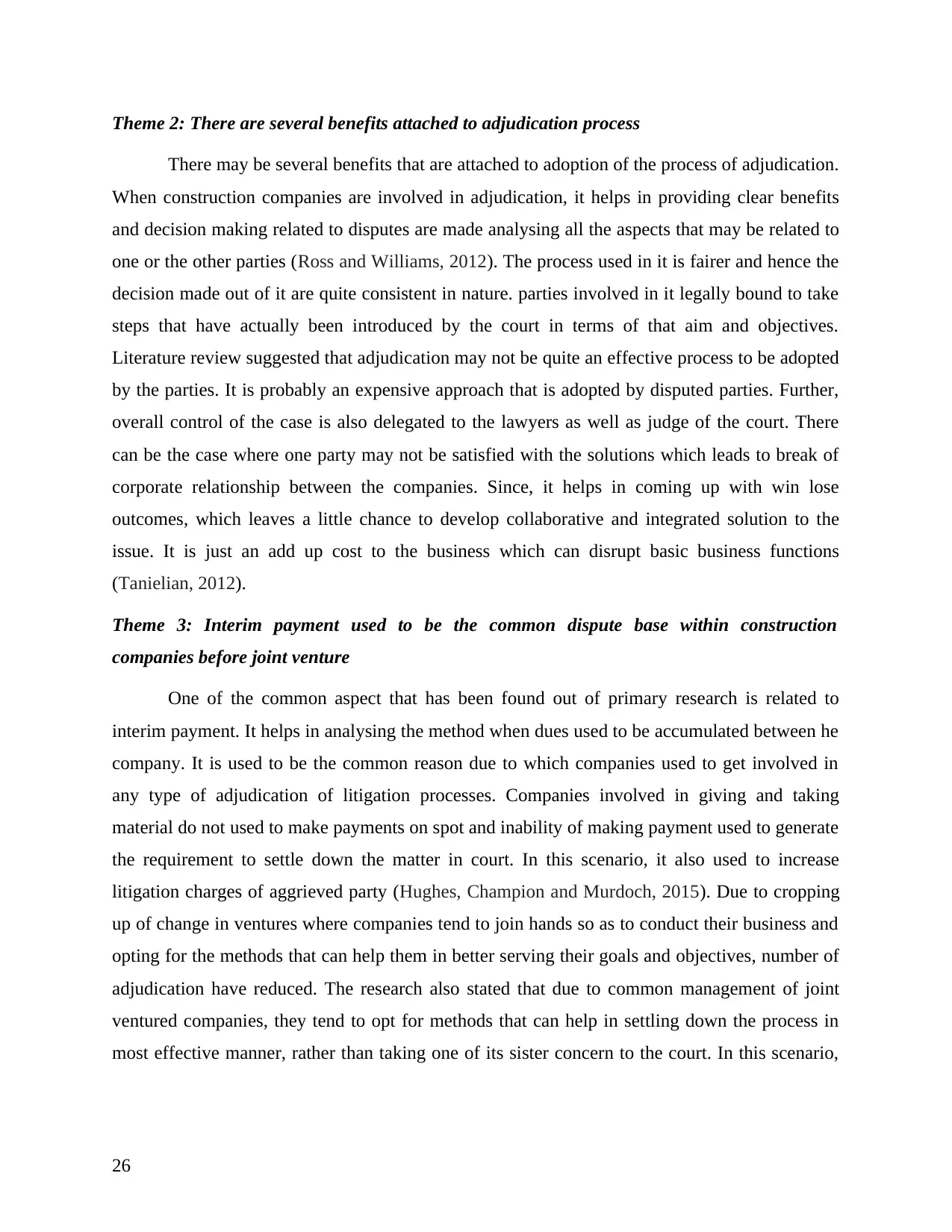
Theme 2: There are several benefits attached to adjudication process
There may be several benefits that are attached to adoption of the process of adjudication.
When construction companies are involved in adjudication, it helps in providing clear benefits
and decision making related to disputes are made analysing all the aspects that may be related to
one or the other parties (Ross and Williams, 2012). The process used in it is fairer and hence the
decision made out of it are quite consistent in nature. parties involved in it legally bound to take
steps that have actually been introduced by the court in terms of that aim and objectives.
Literature review suggested that adjudication may not be quite an effective process to be adopted
by the parties. It is probably an expensive approach that is adopted by disputed parties. Further,
overall control of the case is also delegated to the lawyers as well as judge of the court. There
can be the case where one party may not be satisfied with the solutions which leads to break of
corporate relationship between the companies. Since, it helps in coming up with win lose
outcomes, which leaves a little chance to develop collaborative and integrated solution to the
issue. It is just an add up cost to the business which can disrupt basic business functions
(Tanielian, 2012).
Theme 3: Interim payment used to be the common dispute base within construction
companies before joint venture
One of the common aspect that has been found out of primary research is related to
interim payment. It helps in analysing the method when dues used to be accumulated between he
company. It is used to be the common reason due to which companies used to get involved in
any type of adjudication of litigation processes. Companies involved in giving and taking
material do not used to make payments on spot and inability of making payment used to generate
the requirement to settle down the matter in court. In this scenario, it also used to increase
litigation charges of aggrieved party (Hughes, Champion and Murdoch, 2015). Due to cropping
up of change in ventures where companies tend to join hands so as to conduct their business and
opting for the methods that can help them in better serving their goals and objectives, number of
adjudication have reduced. The research also stated that due to common management of joint
ventured companies, they tend to opt for methods that can help in settling down the process in
most effective manner, rather than taking one of its sister concern to the court. In this scenario,
26
There may be several benefits that are attached to adoption of the process of adjudication.
When construction companies are involved in adjudication, it helps in providing clear benefits
and decision making related to disputes are made analysing all the aspects that may be related to
one or the other parties (Ross and Williams, 2012). The process used in it is fairer and hence the
decision made out of it are quite consistent in nature. parties involved in it legally bound to take
steps that have actually been introduced by the court in terms of that aim and objectives.
Literature review suggested that adjudication may not be quite an effective process to be adopted
by the parties. It is probably an expensive approach that is adopted by disputed parties. Further,
overall control of the case is also delegated to the lawyers as well as judge of the court. There
can be the case where one party may not be satisfied with the solutions which leads to break of
corporate relationship between the companies. Since, it helps in coming up with win lose
outcomes, which leaves a little chance to develop collaborative and integrated solution to the
issue. It is just an add up cost to the business which can disrupt basic business functions
(Tanielian, 2012).
Theme 3: Interim payment used to be the common dispute base within construction
companies before joint venture
One of the common aspect that has been found out of primary research is related to
interim payment. It helps in analysing the method when dues used to be accumulated between he
company. It is used to be the common reason due to which companies used to get involved in
any type of adjudication of litigation processes. Companies involved in giving and taking
material do not used to make payments on spot and inability of making payment used to generate
the requirement to settle down the matter in court. In this scenario, it also used to increase
litigation charges of aggrieved party (Hughes, Champion and Murdoch, 2015). Due to cropping
up of change in ventures where companies tend to join hands so as to conduct their business and
opting for the methods that can help them in better serving their goals and objectives, number of
adjudication have reduced. The research also stated that due to common management of joint
ventured companies, they tend to opt for methods that can help in settling down the process in
most effective manner, rather than taking one of its sister concern to the court. In this scenario,
26

entities opt for out of court settlement that can help them in adopting informal method of dispute
resolution method and avoiding the formal one (Zimina, Ballard and Pasquire, 2012).
Theme 4: Increase in number of Joint venture have helped in reducing the cases of
adjudication
It has been analysed from the data that there is constant decrease in the number of cases
of adjudication when it comes to joint venture of companies. Due to adoption of out of court
settlement methods, companies do not opt for filing litigation that can not only affect their
output, but, can also have greater impact on their reputation and brand image of the company as
well. It also increases overall cost of the business (Agapiou, 2013). Due to sharing same
management in most of the cases of joint ventures, there are higher chances that the issue tends
to get resolved when it is sorted out and adjusted between the parties. Analysing the results that
have received with the help of literature review, it can be assessed that there is constant decrease
in overall number of cases in adjudication, when the construction companies have started getting
involved in joint ventures. It can be stated that issues between he organizations have also reduced
due these ventures and working together with the company with whom the company was just
involved for the sake of giving and taking business. Hence, it can be stated that, joint ventures
have helped in ensuring that there is adequate decrease in overall cases of adjudication in the
country (Pickavance, 2015).
CHAPTER 6: CONCLUSION AND RECOMMENDATIONS
6.1 Conclusion
The main aim of research was to assess that whether an increase in Joint ventures within
the UK Construction industry has reduced the requirement of formal Dispute Resolution. To
satisfy the requirements of aim being framed, researcher got involved in conducting overall
research. It can be analysed that proper objectives have been framed by the researcher. The first
objective of the research is to assess the concept of formal and informal dispute relationship
process. Second objective being framed is, to analyse the benefits of not getting involved in
formal dispute resolution process (Maritz and Hattingh, 2015). Third objective of investigation
is, to assess that whether an increase in Joint ventures within the UK Construction industry has
reduced the requirement of formal Dispute Resolution. In the end, fourth objective of the
research is to recommend on methods of adoption of various informal dispute resolution.
27
resolution method and avoiding the formal one (Zimina, Ballard and Pasquire, 2012).
Theme 4: Increase in number of Joint venture have helped in reducing the cases of
adjudication
It has been analysed from the data that there is constant decrease in the number of cases
of adjudication when it comes to joint venture of companies. Due to adoption of out of court
settlement methods, companies do not opt for filing litigation that can not only affect their
output, but, can also have greater impact on their reputation and brand image of the company as
well. It also increases overall cost of the business (Agapiou, 2013). Due to sharing same
management in most of the cases of joint ventures, there are higher chances that the issue tends
to get resolved when it is sorted out and adjusted between the parties. Analysing the results that
have received with the help of literature review, it can be assessed that there is constant decrease
in overall number of cases in adjudication, when the construction companies have started getting
involved in joint ventures. It can be stated that issues between he organizations have also reduced
due these ventures and working together with the company with whom the company was just
involved for the sake of giving and taking business. Hence, it can be stated that, joint ventures
have helped in ensuring that there is adequate decrease in overall cases of adjudication in the
country (Pickavance, 2015).
CHAPTER 6: CONCLUSION AND RECOMMENDATIONS
6.1 Conclusion
The main aim of research was to assess that whether an increase in Joint ventures within
the UK Construction industry has reduced the requirement of formal Dispute Resolution. To
satisfy the requirements of aim being framed, researcher got involved in conducting overall
research. It can be analysed that proper objectives have been framed by the researcher. The first
objective of the research is to assess the concept of formal and informal dispute relationship
process. Second objective being framed is, to analyse the benefits of not getting involved in
formal dispute resolution process (Maritz and Hattingh, 2015). Third objective of investigation
is, to assess that whether an increase in Joint ventures within the UK Construction industry has
reduced the requirement of formal Dispute Resolution. In the end, fourth objective of the
research is to recommend on methods of adoption of various informal dispute resolution.
27
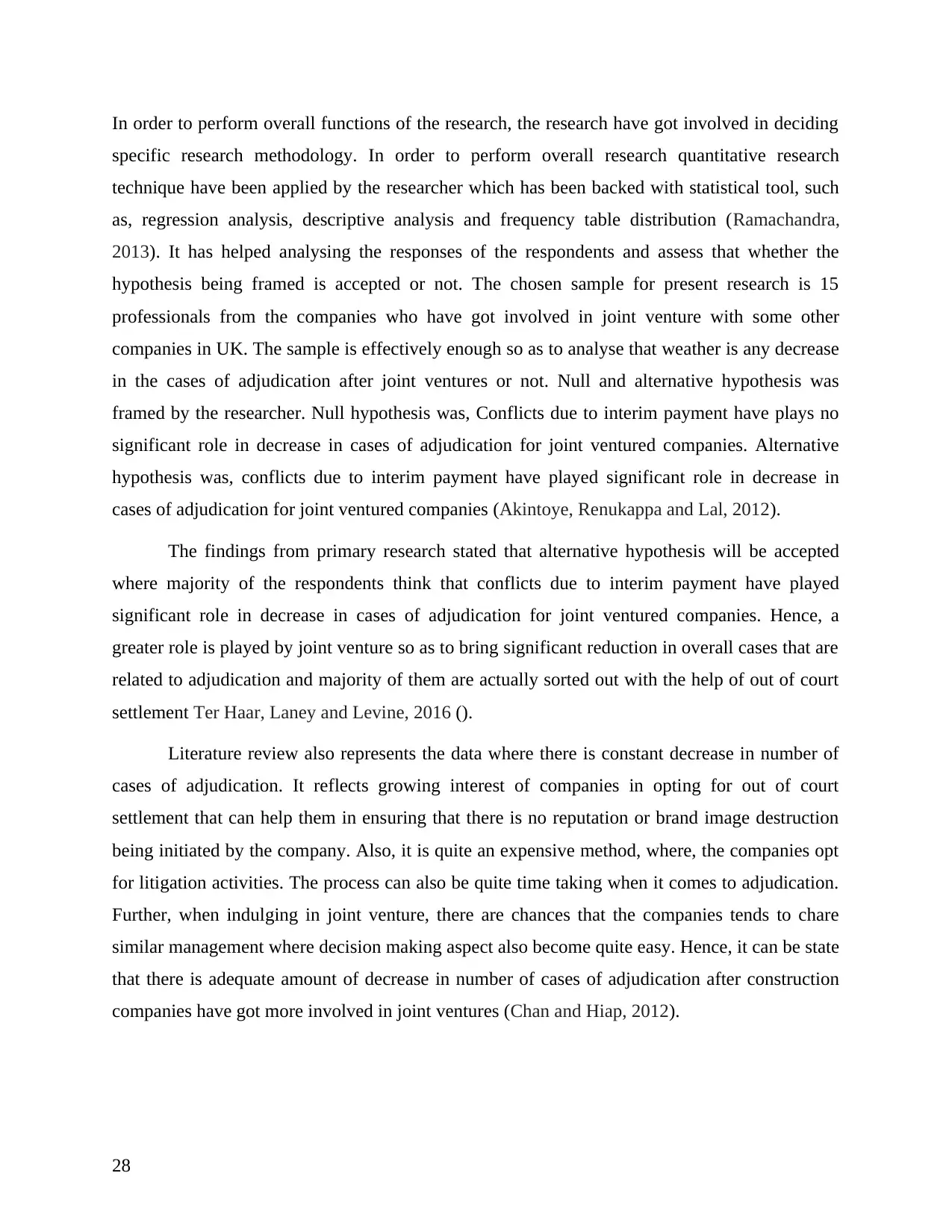
In order to perform overall functions of the research, the research have got involved in deciding
specific research methodology. In order to perform overall research quantitative research
technique have been applied by the researcher which has been backed with statistical tool, such
as, regression analysis, descriptive analysis and frequency table distribution (Ramachandra,
2013). It has helped analysing the responses of the respondents and assess that whether the
hypothesis being framed is accepted or not. The chosen sample for present research is 15
professionals from the companies who have got involved in joint venture with some other
companies in UK. The sample is effectively enough so as to analyse that weather is any decrease
in the cases of adjudication after joint ventures or not. Null and alternative hypothesis was
framed by the researcher. Null hypothesis was, Conflicts due to interim payment have plays no
significant role in decrease in cases of adjudication for joint ventured companies. Alternative
hypothesis was, conflicts due to interim payment have played significant role in decrease in
cases of adjudication for joint ventured companies (Akintoye, Renukappa and Lal, 2012).
The findings from primary research stated that alternative hypothesis will be accepted
where majority of the respondents think that conflicts due to interim payment have played
significant role in decrease in cases of adjudication for joint ventured companies. Hence, a
greater role is played by joint venture so as to bring significant reduction in overall cases that are
related to adjudication and majority of them are actually sorted out with the help of out of court
settlement Ter Haar, Laney and Levine, 2016 ().
Literature review also represents the data where there is constant decrease in number of
cases of adjudication. It reflects growing interest of companies in opting for out of court
settlement that can help them in ensuring that there is no reputation or brand image destruction
being initiated by the company. Also, it is quite an expensive method, where, the companies opt
for litigation activities. The process can also be quite time taking when it comes to adjudication.
Further, when indulging in joint venture, there are chances that the companies tends to chare
similar management where decision making aspect also become quite easy. Hence, it can be state
that there is adequate amount of decrease in number of cases of adjudication after construction
companies have got more involved in joint ventures (Chan and Hiap, 2012).
28
specific research methodology. In order to perform overall research quantitative research
technique have been applied by the researcher which has been backed with statistical tool, such
as, regression analysis, descriptive analysis and frequency table distribution (Ramachandra,
2013). It has helped analysing the responses of the respondents and assess that whether the
hypothesis being framed is accepted or not. The chosen sample for present research is 15
professionals from the companies who have got involved in joint venture with some other
companies in UK. The sample is effectively enough so as to analyse that weather is any decrease
in the cases of adjudication after joint ventures or not. Null and alternative hypothesis was
framed by the researcher. Null hypothesis was, Conflicts due to interim payment have plays no
significant role in decrease in cases of adjudication for joint ventured companies. Alternative
hypothesis was, conflicts due to interim payment have played significant role in decrease in
cases of adjudication for joint ventured companies (Akintoye, Renukappa and Lal, 2012).
The findings from primary research stated that alternative hypothesis will be accepted
where majority of the respondents think that conflicts due to interim payment have played
significant role in decrease in cases of adjudication for joint ventured companies. Hence, a
greater role is played by joint venture so as to bring significant reduction in overall cases that are
related to adjudication and majority of them are actually sorted out with the help of out of court
settlement Ter Haar, Laney and Levine, 2016 ().
Literature review also represents the data where there is constant decrease in number of
cases of adjudication. It reflects growing interest of companies in opting for out of court
settlement that can help them in ensuring that there is no reputation or brand image destruction
being initiated by the company. Also, it is quite an expensive method, where, the companies opt
for litigation activities. The process can also be quite time taking when it comes to adjudication.
Further, when indulging in joint venture, there are chances that the companies tends to chare
similar management where decision making aspect also become quite easy. Hence, it can be state
that there is adequate amount of decrease in number of cases of adjudication after construction
companies have got more involved in joint ventures (Chan and Hiap, 2012).
28
Secure Best Marks with AI Grader
Need help grading? Try our AI Grader for instant feedback on your assignments.
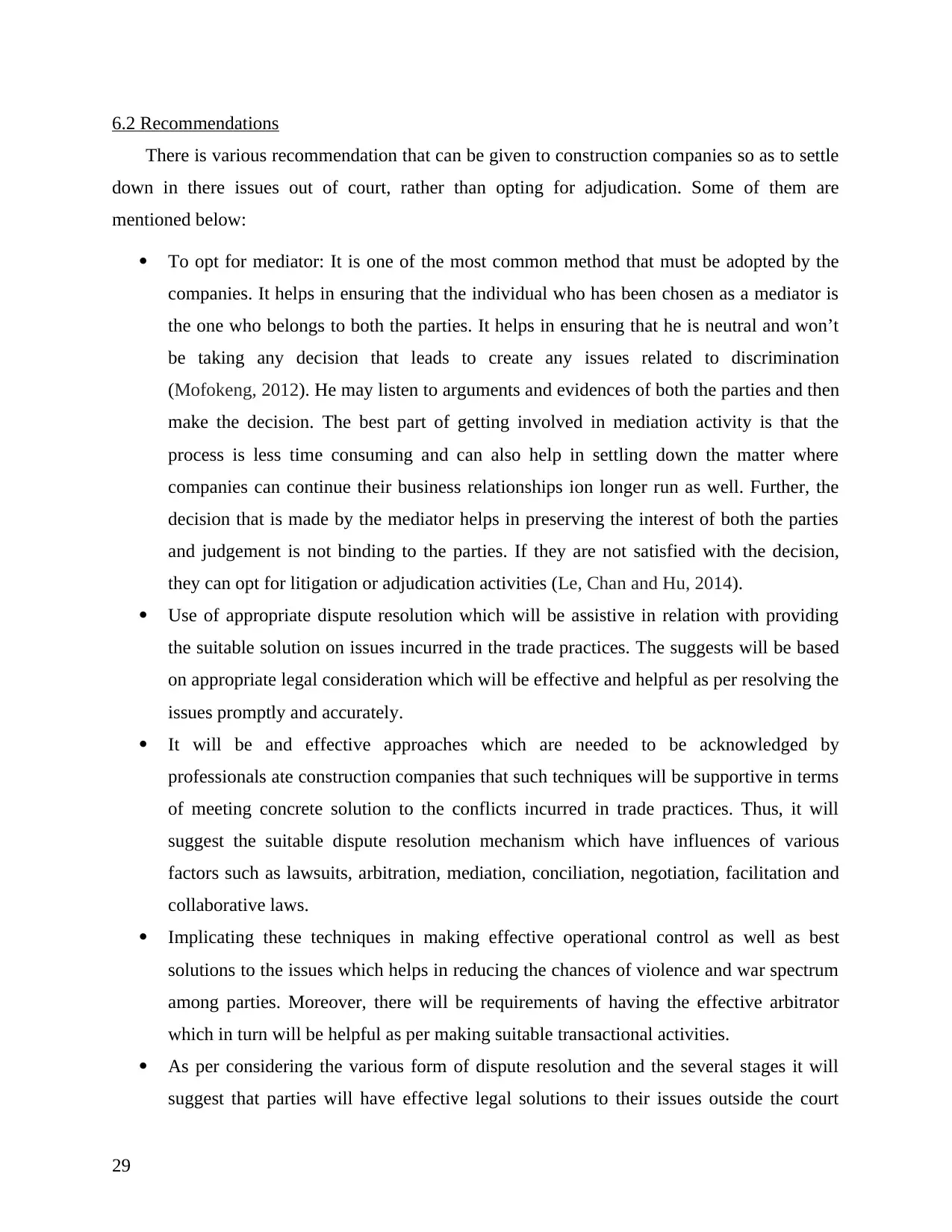
6.2 Recommendations
There is various recommendation that can be given to construction companies so as to settle
down in there issues out of court, rather than opting for adjudication. Some of them are
mentioned below:
To opt for mediator: It is one of the most common method that must be adopted by the
companies. It helps in ensuring that the individual who has been chosen as a mediator is
the one who belongs to both the parties. It helps in ensuring that he is neutral and won’t
be taking any decision that leads to create any issues related to discrimination
(Mofokeng, 2012). He may listen to arguments and evidences of both the parties and then
make the decision. The best part of getting involved in mediation activity is that the
process is less time consuming and can also help in settling down the matter where
companies can continue their business relationships ion longer run as well. Further, the
decision that is made by the mediator helps in preserving the interest of both the parties
and judgement is not binding to the parties. If they are not satisfied with the decision,
they can opt for litigation or adjudication activities (Le, Chan and Hu, 2014).
Use of appropriate dispute resolution which will be assistive in relation with providing
the suitable solution on issues incurred in the trade practices. The suggests will be based
on appropriate legal consideration which will be effective and helpful as per resolving the
issues promptly and accurately.
It will be and effective approaches which are needed to be acknowledged by
professionals ate construction companies that such techniques will be supportive in terms
of meeting concrete solution to the conflicts incurred in trade practices. Thus, it will
suggest the suitable dispute resolution mechanism which have influences of various
factors such as lawsuits, arbitration, mediation, conciliation, negotiation, facilitation and
collaborative laws.
Implicating these techniques in making effective operational control as well as best
solutions to the issues which helps in reducing the chances of violence and war spectrum
among parties. Moreover, there will be requirements of having the effective arbitrator
which in turn will be helpful as per making suitable transactional activities.
As per considering the various form of dispute resolution and the several stages it will
suggest that parties will have effective legal solutions to their issues outside the court
29
There is various recommendation that can be given to construction companies so as to settle
down in there issues out of court, rather than opting for adjudication. Some of them are
mentioned below:
To opt for mediator: It is one of the most common method that must be adopted by the
companies. It helps in ensuring that the individual who has been chosen as a mediator is
the one who belongs to both the parties. It helps in ensuring that he is neutral and won’t
be taking any decision that leads to create any issues related to discrimination
(Mofokeng, 2012). He may listen to arguments and evidences of both the parties and then
make the decision. The best part of getting involved in mediation activity is that the
process is less time consuming and can also help in settling down the matter where
companies can continue their business relationships ion longer run as well. Further, the
decision that is made by the mediator helps in preserving the interest of both the parties
and judgement is not binding to the parties. If they are not satisfied with the decision,
they can opt for litigation or adjudication activities (Le, Chan and Hu, 2014).
Use of appropriate dispute resolution which will be assistive in relation with providing
the suitable solution on issues incurred in the trade practices. The suggests will be based
on appropriate legal consideration which will be effective and helpful as per resolving the
issues promptly and accurately.
It will be and effective approaches which are needed to be acknowledged by
professionals ate construction companies that such techniques will be supportive in terms
of meeting concrete solution to the conflicts incurred in trade practices. Thus, it will
suggest the suitable dispute resolution mechanism which have influences of various
factors such as lawsuits, arbitration, mediation, conciliation, negotiation, facilitation and
collaborative laws.
Implicating these techniques in making effective operational control as well as best
solutions to the issues which helps in reducing the chances of violence and war spectrum
among parties. Moreover, there will be requirements of having the effective arbitrator
which in turn will be helpful as per making suitable transactional activities.
As per considering the various form of dispute resolution and the several stages it will
suggest that parties will have effective legal solutions to their issues outside the court
29
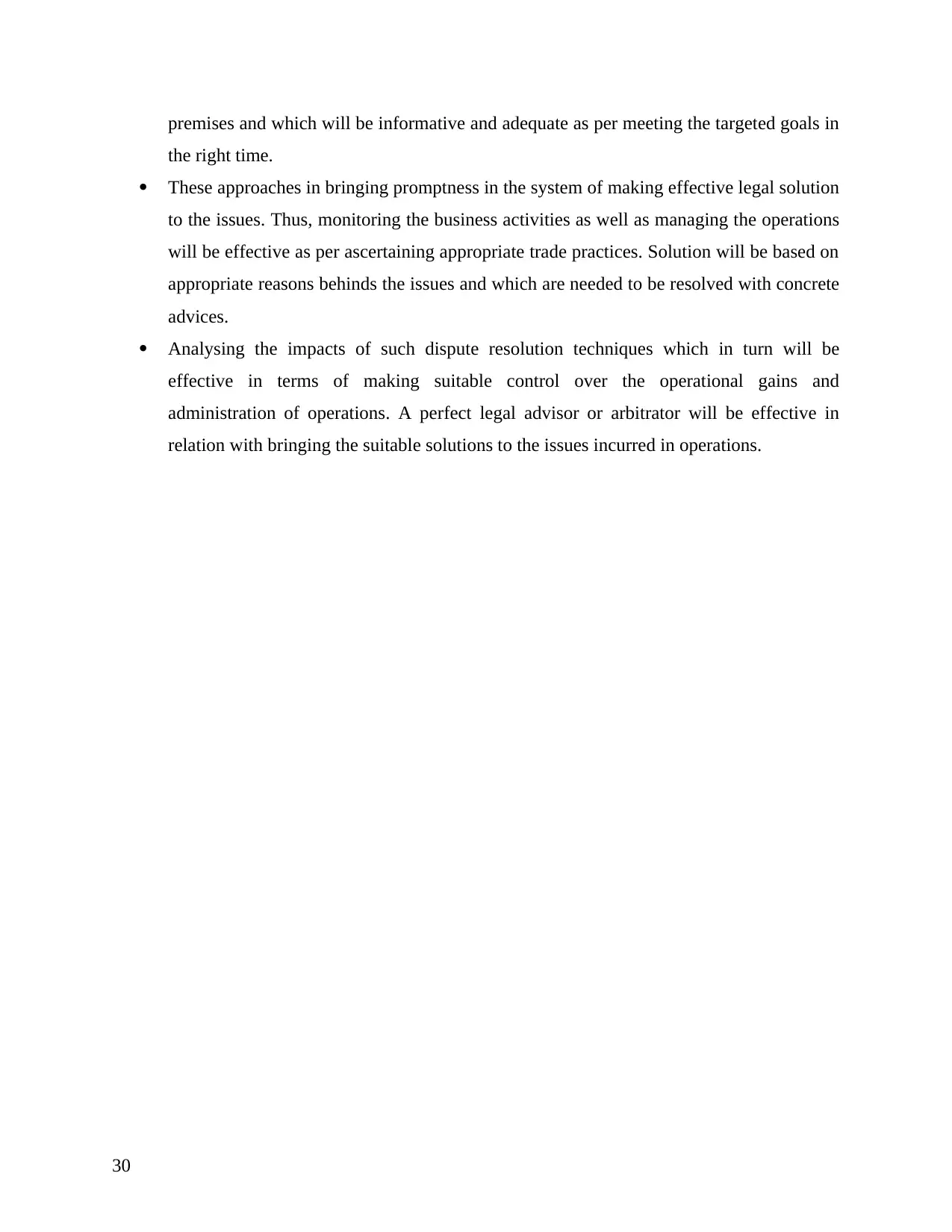
premises and which will be informative and adequate as per meeting the targeted goals in
the right time.
These approaches in bringing promptness in the system of making effective legal solution
to the issues. Thus, monitoring the business activities as well as managing the operations
will be effective as per ascertaining appropriate trade practices. Solution will be based on
appropriate reasons behinds the issues and which are needed to be resolved with concrete
advices.
Analysing the impacts of such dispute resolution techniques which in turn will be
effective in terms of making suitable control over the operational gains and
administration of operations. A perfect legal advisor or arbitrator will be effective in
relation with bringing the suitable solutions to the issues incurred in operations.
30
the right time.
These approaches in bringing promptness in the system of making effective legal solution
to the issues. Thus, monitoring the business activities as well as managing the operations
will be effective as per ascertaining appropriate trade practices. Solution will be based on
appropriate reasons behinds the issues and which are needed to be resolved with concrete
advices.
Analysing the impacts of such dispute resolution techniques which in turn will be
effective in terms of making suitable control over the operational gains and
administration of operations. A perfect legal advisor or arbitrator will be effective in
relation with bringing the suitable solutions to the issues incurred in operations.
30
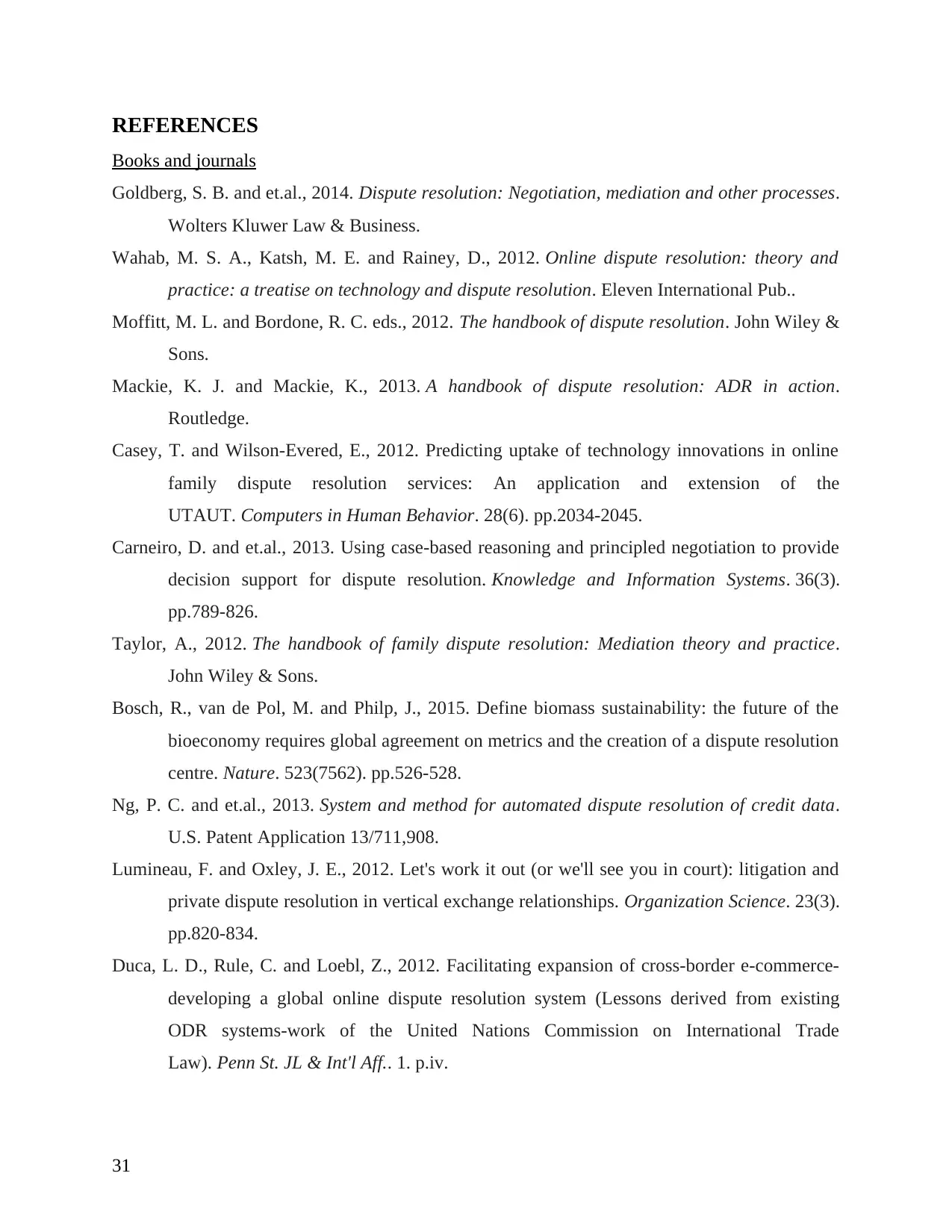
REFERENCES
Books and journals
Goldberg, S. B. and et.al., 2014. Dispute resolution: Negotiation, mediation and other processes.
Wolters Kluwer Law & Business.
Wahab, M. S. A., Katsh, M. E. and Rainey, D., 2012. Online dispute resolution: theory and
practice: a treatise on technology and dispute resolution. Eleven International Pub..
Moffitt, M. L. and Bordone, R. C. eds., 2012. The handbook of dispute resolution. John Wiley &
Sons.
Mackie, K. J. and Mackie, K., 2013. A handbook of dispute resolution: ADR in action.
Routledge.
Casey, T. and Wilson-Evered, E., 2012. Predicting uptake of technology innovations in online
family dispute resolution services: An application and extension of the
UTAUT. Computers in Human Behavior. 28(6). pp.2034-2045.
Carneiro, D. and et.al., 2013. Using case-based reasoning and principled negotiation to provide
decision support for dispute resolution. Knowledge and Information Systems. 36(3).
pp.789-826.
Taylor, A., 2012. The handbook of family dispute resolution: Mediation theory and practice.
John Wiley & Sons.
Bosch, R., van de Pol, M. and Philp, J., 2015. Define biomass sustainability: the future of the
bioeconomy requires global agreement on metrics and the creation of a dispute resolution
centre. Nature. 523(7562). pp.526-528.
Ng, P. C. and et.al., 2013. System and method for automated dispute resolution of credit data.
U.S. Patent Application 13/711,908.
Lumineau, F. and Oxley, J. E., 2012. Let's work it out (or we'll see you in court): litigation and
private dispute resolution in vertical exchange relationships. Organization Science. 23(3).
pp.820-834.
Duca, L. D., Rule, C. and Loebl, Z., 2012. Facilitating expansion of cross-border e-commerce-
developing a global online dispute resolution system (Lessons derived from existing
ODR systems-work of the United Nations Commission on International Trade
Law). Penn St. JL & Int'l Aff.. 1. p.iv.
31
Books and journals
Goldberg, S. B. and et.al., 2014. Dispute resolution: Negotiation, mediation and other processes.
Wolters Kluwer Law & Business.
Wahab, M. S. A., Katsh, M. E. and Rainey, D., 2012. Online dispute resolution: theory and
practice: a treatise on technology and dispute resolution. Eleven International Pub..
Moffitt, M. L. and Bordone, R. C. eds., 2012. The handbook of dispute resolution. John Wiley &
Sons.
Mackie, K. J. and Mackie, K., 2013. A handbook of dispute resolution: ADR in action.
Routledge.
Casey, T. and Wilson-Evered, E., 2012. Predicting uptake of technology innovations in online
family dispute resolution services: An application and extension of the
UTAUT. Computers in Human Behavior. 28(6). pp.2034-2045.
Carneiro, D. and et.al., 2013. Using case-based reasoning and principled negotiation to provide
decision support for dispute resolution. Knowledge and Information Systems. 36(3).
pp.789-826.
Taylor, A., 2012. The handbook of family dispute resolution: Mediation theory and practice.
John Wiley & Sons.
Bosch, R., van de Pol, M. and Philp, J., 2015. Define biomass sustainability: the future of the
bioeconomy requires global agreement on metrics and the creation of a dispute resolution
centre. Nature. 523(7562). pp.526-528.
Ng, P. C. and et.al., 2013. System and method for automated dispute resolution of credit data.
U.S. Patent Application 13/711,908.
Lumineau, F. and Oxley, J. E., 2012. Let's work it out (or we'll see you in court): litigation and
private dispute resolution in vertical exchange relationships. Organization Science. 23(3).
pp.820-834.
Duca, L. D., Rule, C. and Loebl, Z., 2012. Facilitating expansion of cross-border e-commerce-
developing a global online dispute resolution system (Lessons derived from existing
ODR systems-work of the United Nations Commission on International Trade
Law). Penn St. JL & Int'l Aff.. 1. p.iv.
31
Paraphrase This Document
Need a fresh take? Get an instant paraphrase of this document with our AI Paraphraser
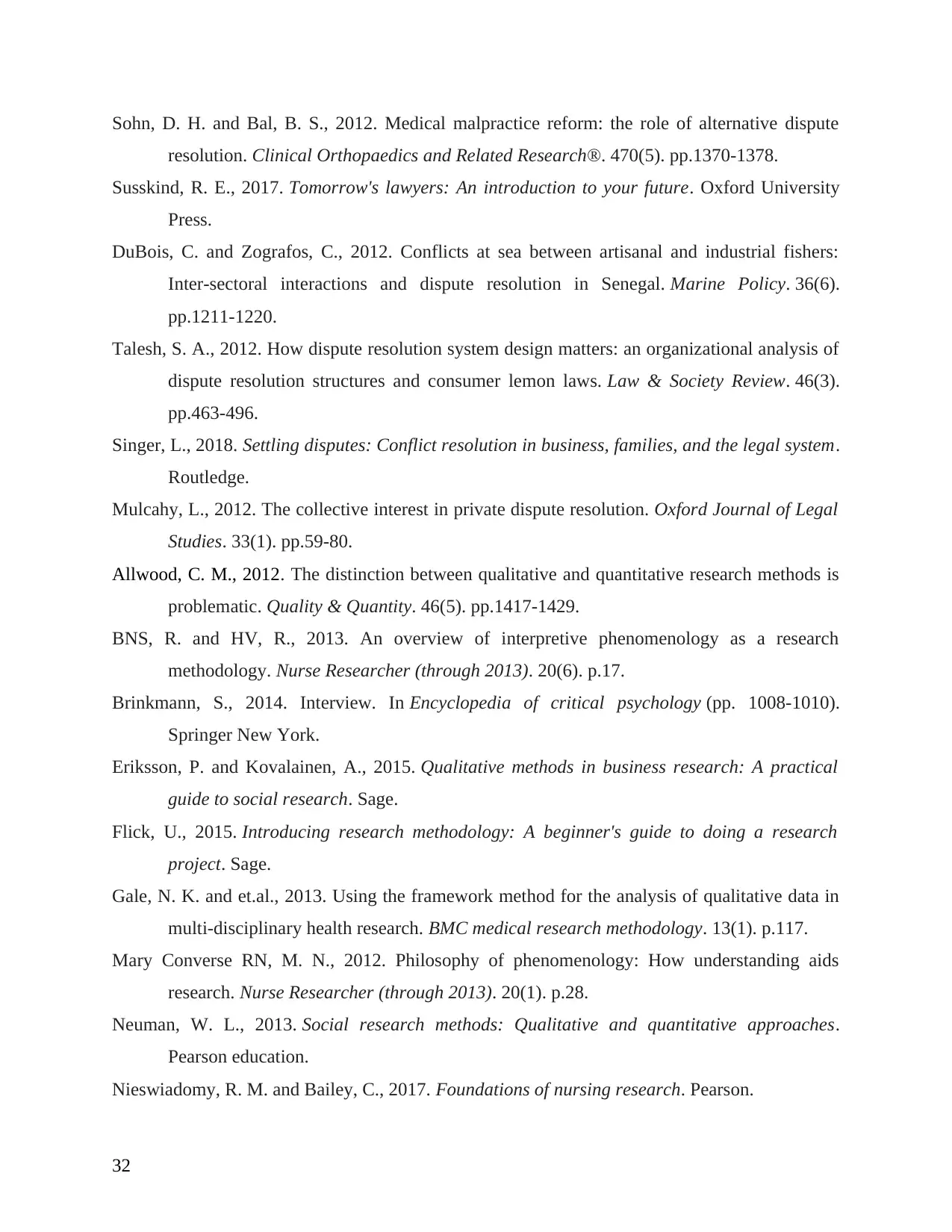
Sohn, D. H. and Bal, B. S., 2012. Medical malpractice reform: the role of alternative dispute
resolution. Clinical Orthopaedics and Related Research®. 470(5). pp.1370-1378.
Susskind, R. E., 2017. Tomorrow's lawyers: An introduction to your future. Oxford University
Press.
DuBois, C. and Zografos, C., 2012. Conflicts at sea between artisanal and industrial fishers:
Inter-sectoral interactions and dispute resolution in Senegal. Marine Policy. 36(6).
pp.1211-1220.
Talesh, S. A., 2012. How dispute resolution system design matters: an organizational analysis of
dispute resolution structures and consumer lemon laws. Law & Society Review. 46(3).
pp.463-496.
Singer, L., 2018. Settling disputes: Conflict resolution in business, families, and the legal system.
Routledge.
Mulcahy, L., 2012. The collective interest in private dispute resolution. Oxford Journal of Legal
Studies. 33(1). pp.59-80.
Allwood, C. M., 2012. The distinction between qualitative and quantitative research methods is
problematic. Quality & Quantity. 46(5). pp.1417-1429.
BNS, R. and HV, R., 2013. An overview of interpretive phenomenology as a research
methodology. Nurse Researcher (through 2013). 20(6). p.17.
Brinkmann, S., 2014. Interview. In Encyclopedia of critical psychology (pp. 1008-1010).
Springer New York.
Eriksson, P. and Kovalainen, A., 2015. Qualitative methods in business research: A practical
guide to social research. Sage.
Flick, U., 2015. Introducing research methodology: A beginner's guide to doing a research
project. Sage.
Gale, N. K. and et.al., 2013. Using the framework method for the analysis of qualitative data in
multi-disciplinary health research. BMC medical research methodology. 13(1). p.117.
Mary Converse RN, M. N., 2012. Philosophy of phenomenology: How understanding aids
research. Nurse Researcher (through 2013). 20(1). p.28.
Neuman, W. L., 2013. Social research methods: Qualitative and quantitative approaches.
Pearson education.
Nieswiadomy, R. M. and Bailey, C., 2017. Foundations of nursing research. Pearson.
32
resolution. Clinical Orthopaedics and Related Research®. 470(5). pp.1370-1378.
Susskind, R. E., 2017. Tomorrow's lawyers: An introduction to your future. Oxford University
Press.
DuBois, C. and Zografos, C., 2012. Conflicts at sea between artisanal and industrial fishers:
Inter-sectoral interactions and dispute resolution in Senegal. Marine Policy. 36(6).
pp.1211-1220.
Talesh, S. A., 2012. How dispute resolution system design matters: an organizational analysis of
dispute resolution structures and consumer lemon laws. Law & Society Review. 46(3).
pp.463-496.
Singer, L., 2018. Settling disputes: Conflict resolution in business, families, and the legal system.
Routledge.
Mulcahy, L., 2012. The collective interest in private dispute resolution. Oxford Journal of Legal
Studies. 33(1). pp.59-80.
Allwood, C. M., 2012. The distinction between qualitative and quantitative research methods is
problematic. Quality & Quantity. 46(5). pp.1417-1429.
BNS, R. and HV, R., 2013. An overview of interpretive phenomenology as a research
methodology. Nurse Researcher (through 2013). 20(6). p.17.
Brinkmann, S., 2014. Interview. In Encyclopedia of critical psychology (pp. 1008-1010).
Springer New York.
Eriksson, P. and Kovalainen, A., 2015. Qualitative methods in business research: A practical
guide to social research. Sage.
Flick, U., 2015. Introducing research methodology: A beginner's guide to doing a research
project. Sage.
Gale, N. K. and et.al., 2013. Using the framework method for the analysis of qualitative data in
multi-disciplinary health research. BMC medical research methodology. 13(1). p.117.
Mary Converse RN, M. N., 2012. Philosophy of phenomenology: How understanding aids
research. Nurse Researcher (through 2013). 20(1). p.28.
Neuman, W. L., 2013. Social research methods: Qualitative and quantitative approaches.
Pearson education.
Nieswiadomy, R. M. and Bailey, C., 2017. Foundations of nursing research. Pearson.
32
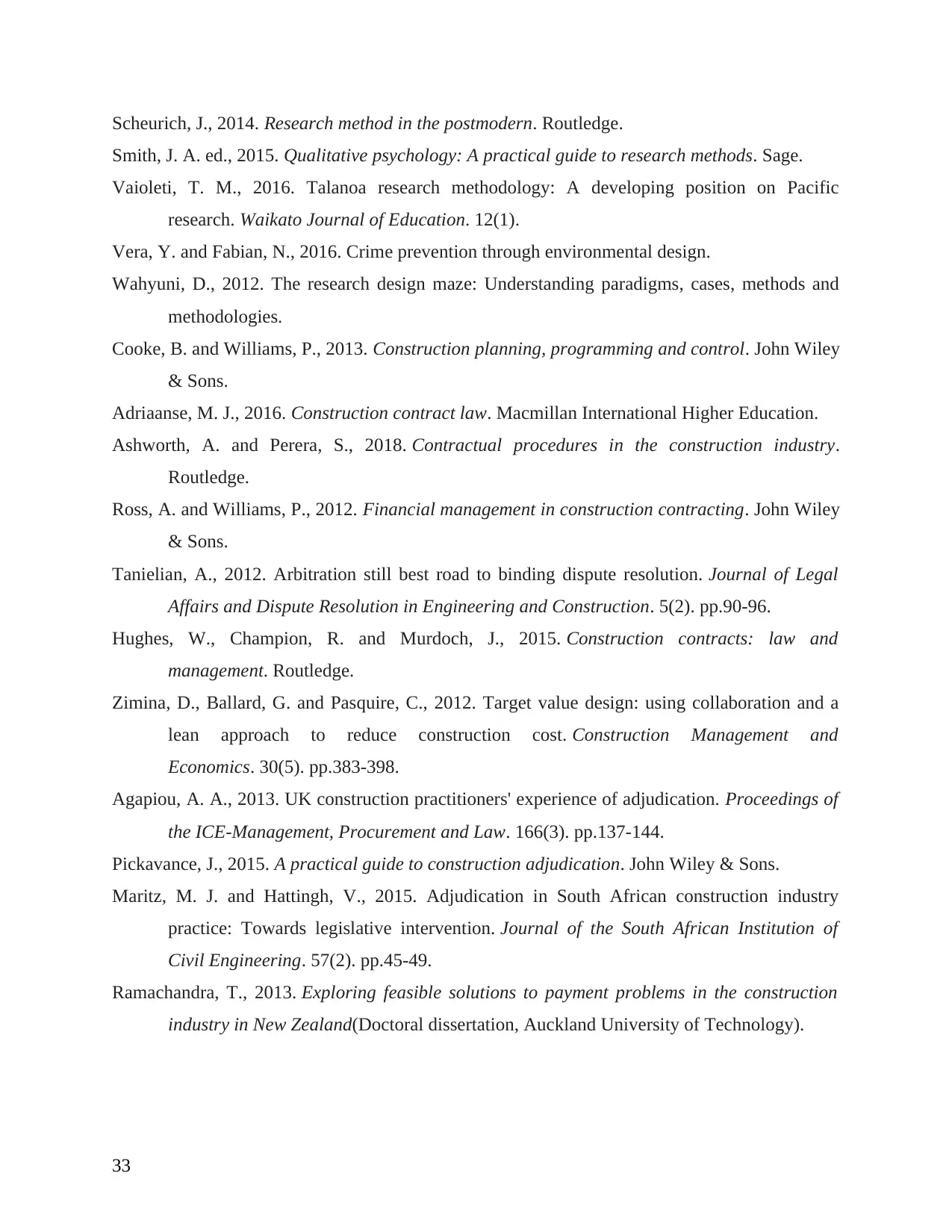
Scheurich, J., 2014. Research method in the postmodern. Routledge.
Smith, J. A. ed., 2015. Qualitative psychology: A practical guide to research methods. Sage.
Vaioleti, T. M., 2016. Talanoa research methodology: A developing position on Pacific
research. Waikato Journal of Education. 12(1).
Vera, Y. and Fabian, N., 2016. Crime prevention through environmental design.
Wahyuni, D., 2012. The research design maze: Understanding paradigms, cases, methods and
methodologies.
Cooke, B. and Williams, P., 2013. Construction planning, programming and control. John Wiley
& Sons.
Adriaanse, M. J., 2016. Construction contract law. Macmillan International Higher Education.
Ashworth, A. and Perera, S., 2018. Contractual procedures in the construction industry.
Routledge.
Ross, A. and Williams, P., 2012. Financial management in construction contracting. John Wiley
& Sons.
Tanielian, A., 2012. Arbitration still best road to binding dispute resolution. Journal of Legal
Affairs and Dispute Resolution in Engineering and Construction. 5(2). pp.90-96.
Hughes, W., Champion, R. and Murdoch, J., 2015. Construction contracts: law and
management. Routledge.
Zimina, D., Ballard, G. and Pasquire, C., 2012. Target value design: using collaboration and a
lean approach to reduce construction cost. Construction Management and
Economics. 30(5). pp.383-398.
Agapiou, A. A., 2013. UK construction practitioners' experience of adjudication. Proceedings of
the ICE-Management, Procurement and Law. 166(3). pp.137-144.
Pickavance, J., 2015. A practical guide to construction adjudication. John Wiley & Sons.
Maritz, M. J. and Hattingh, V., 2015. Adjudication in South African construction industry
practice: Towards legislative intervention. Journal of the South African Institution of
Civil Engineering. 57(2). pp.45-49.
Ramachandra, T., 2013. Exploring feasible solutions to payment problems in the construction
industry in New Zealand(Doctoral dissertation, Auckland University of Technology).
33
Smith, J. A. ed., 2015. Qualitative psychology: A practical guide to research methods. Sage.
Vaioleti, T. M., 2016. Talanoa research methodology: A developing position on Pacific
research. Waikato Journal of Education. 12(1).
Vera, Y. and Fabian, N., 2016. Crime prevention through environmental design.
Wahyuni, D., 2012. The research design maze: Understanding paradigms, cases, methods and
methodologies.
Cooke, B. and Williams, P., 2013. Construction planning, programming and control. John Wiley
& Sons.
Adriaanse, M. J., 2016. Construction contract law. Macmillan International Higher Education.
Ashworth, A. and Perera, S., 2018. Contractual procedures in the construction industry.
Routledge.
Ross, A. and Williams, P., 2012. Financial management in construction contracting. John Wiley
& Sons.
Tanielian, A., 2012. Arbitration still best road to binding dispute resolution. Journal of Legal
Affairs and Dispute Resolution in Engineering and Construction. 5(2). pp.90-96.
Hughes, W., Champion, R. and Murdoch, J., 2015. Construction contracts: law and
management. Routledge.
Zimina, D., Ballard, G. and Pasquire, C., 2012. Target value design: using collaboration and a
lean approach to reduce construction cost. Construction Management and
Economics. 30(5). pp.383-398.
Agapiou, A. A., 2013. UK construction practitioners' experience of adjudication. Proceedings of
the ICE-Management, Procurement and Law. 166(3). pp.137-144.
Pickavance, J., 2015. A practical guide to construction adjudication. John Wiley & Sons.
Maritz, M. J. and Hattingh, V., 2015. Adjudication in South African construction industry
practice: Towards legislative intervention. Journal of the South African Institution of
Civil Engineering. 57(2). pp.45-49.
Ramachandra, T., 2013. Exploring feasible solutions to payment problems in the construction
industry in New Zealand(Doctoral dissertation, Auckland University of Technology).
33
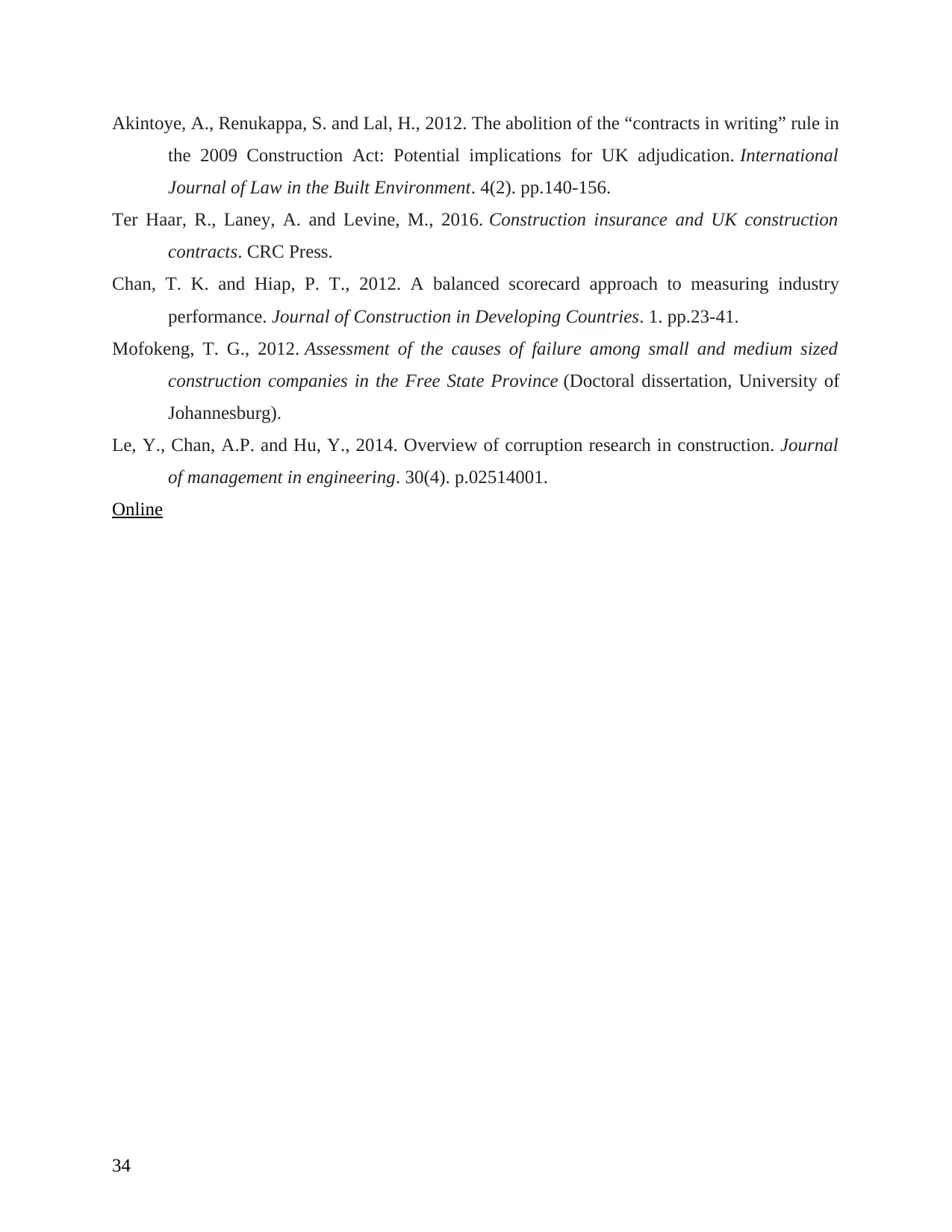
Akintoye, A., Renukappa, S. and Lal, H., 2012. The abolition of the “contracts in writing” rule in
the 2009 Construction Act: Potential implications for UK adjudication. International
Journal of Law in the Built Environment. 4(2). pp.140-156.
Ter Haar, R., Laney, A. and Levine, M., 2016. Construction insurance and UK construction
contracts. CRC Press.
Chan, T. K. and Hiap, P. T., 2012. A balanced scorecard approach to measuring industry
performance. Journal of Construction in Developing Countries. 1. pp.23-41.
Mofokeng, T. G., 2012. Assessment of the causes of failure among small and medium sized
construction companies in the Free State Province (Doctoral dissertation, University of
Johannesburg).
Le, Y., Chan, A.P. and Hu, Y., 2014. Overview of corruption research in construction. Journal
of management in engineering. 30(4). p.02514001.
Online
34
the 2009 Construction Act: Potential implications for UK adjudication. International
Journal of Law in the Built Environment. 4(2). pp.140-156.
Ter Haar, R., Laney, A. and Levine, M., 2016. Construction insurance and UK construction
contracts. CRC Press.
Chan, T. K. and Hiap, P. T., 2012. A balanced scorecard approach to measuring industry
performance. Journal of Construction in Developing Countries. 1. pp.23-41.
Mofokeng, T. G., 2012. Assessment of the causes of failure among small and medium sized
construction companies in the Free State Province (Doctoral dissertation, University of
Johannesburg).
Le, Y., Chan, A.P. and Hu, Y., 2014. Overview of corruption research in construction. Journal
of management in engineering. 30(4). p.02514001.
Online
34
Secure Best Marks with AI Grader
Need help grading? Try our AI Grader for instant feedback on your assignments.
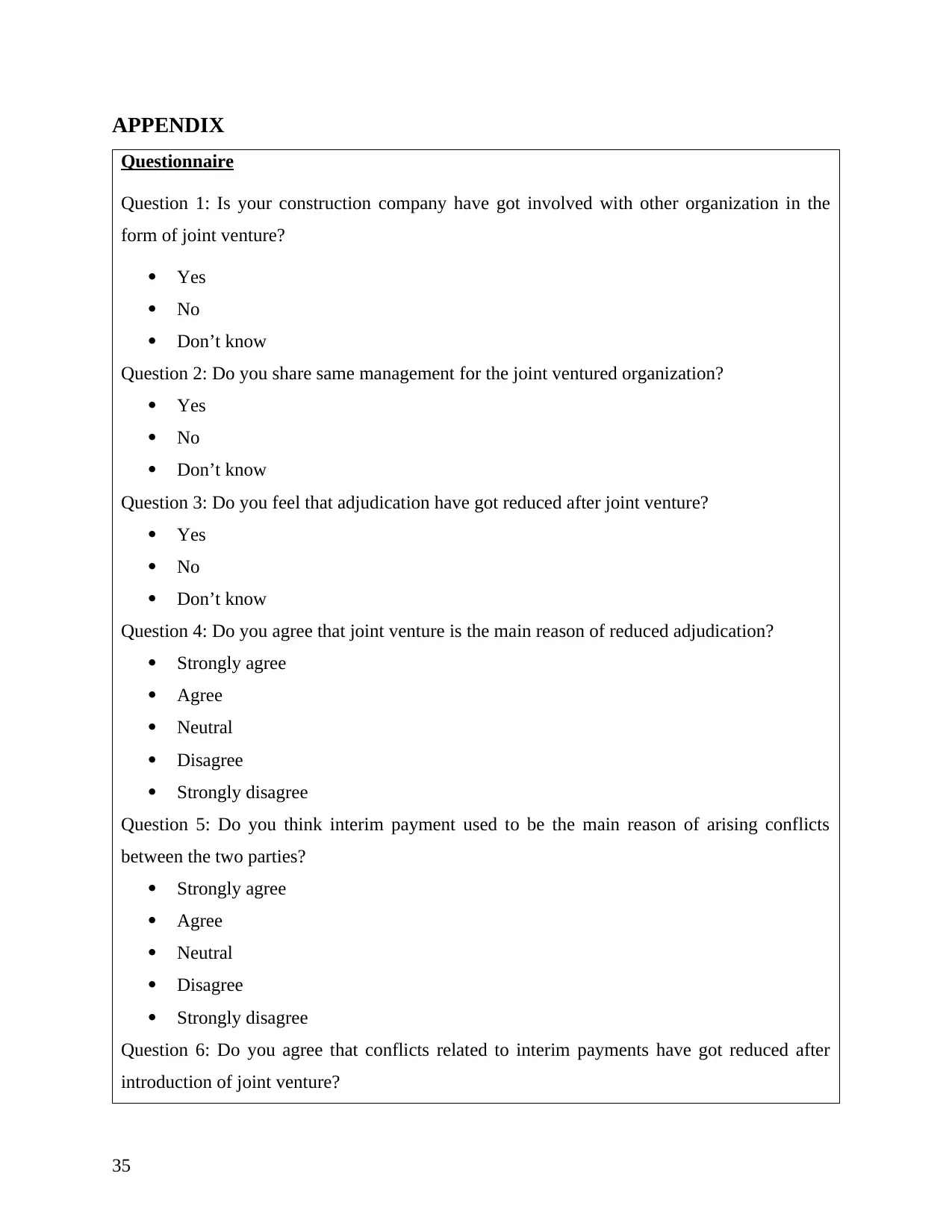
APPENDIX
Questionnaire
Question 1: Is your construction company have got involved with other organization in the
form of joint venture?
Yes
No
Don’t know
Question 2: Do you share same management for the joint ventured organization?
Yes
No
Don’t know
Question 3: Do you feel that adjudication have got reduced after joint venture?
Yes
No
Don’t know
Question 4: Do you agree that joint venture is the main reason of reduced adjudication?
Strongly agree
Agree
Neutral
Disagree
Strongly disagree
Question 5: Do you think interim payment used to be the main reason of arising conflicts
between the two parties?
Strongly agree
Agree
Neutral
Disagree
Strongly disagree
Question 6: Do you agree that conflicts related to interim payments have got reduced after
introduction of joint venture?
35
Questionnaire
Question 1: Is your construction company have got involved with other organization in the
form of joint venture?
Yes
No
Don’t know
Question 2: Do you share same management for the joint ventured organization?
Yes
No
Don’t know
Question 3: Do you feel that adjudication have got reduced after joint venture?
Yes
No
Don’t know
Question 4: Do you agree that joint venture is the main reason of reduced adjudication?
Strongly agree
Agree
Neutral
Disagree
Strongly disagree
Question 5: Do you think interim payment used to be the main reason of arising conflicts
between the two parties?
Strongly agree
Agree
Neutral
Disagree
Strongly disagree
Question 6: Do you agree that conflicts related to interim payments have got reduced after
introduction of joint venture?
35
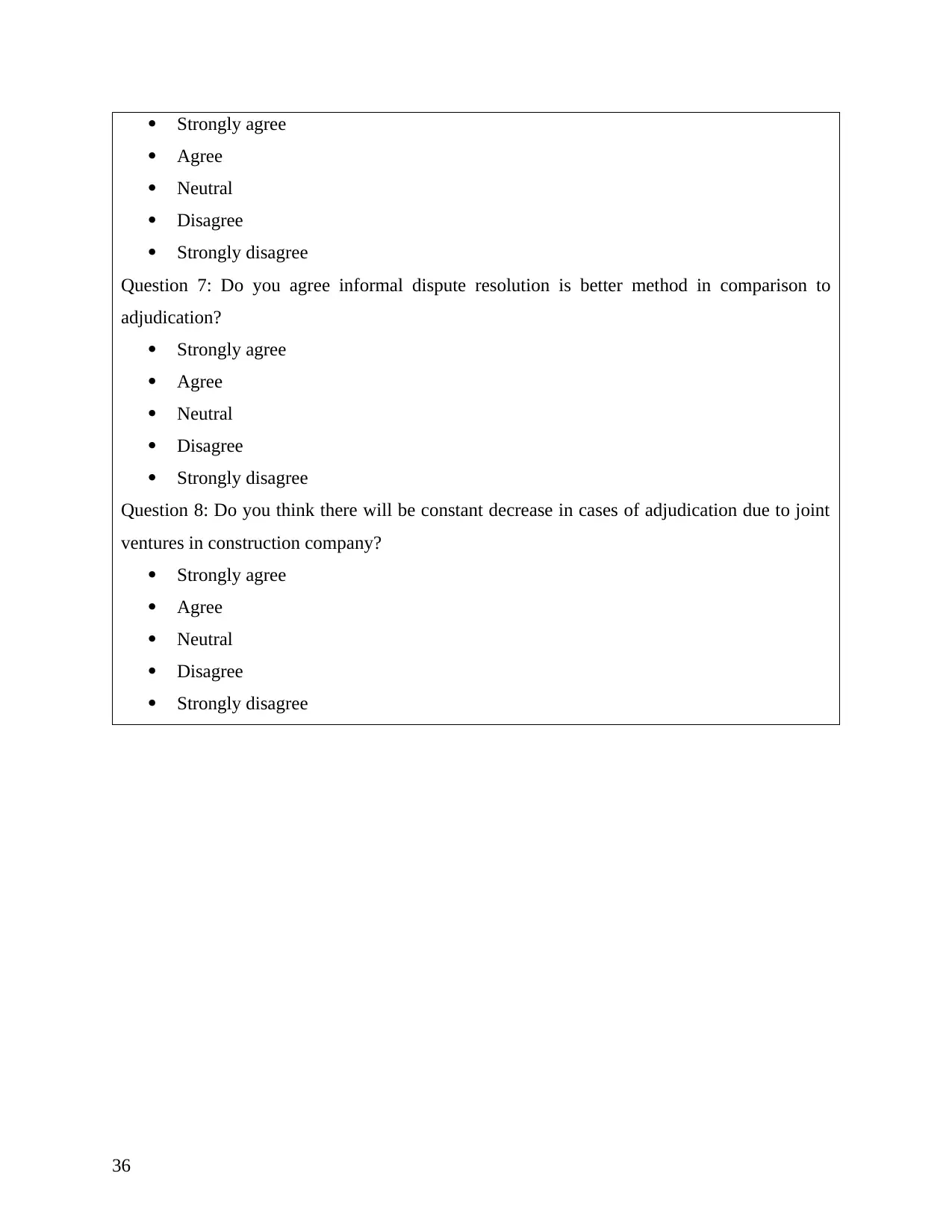
Strongly agree
Agree
Neutral
Disagree
Strongly disagree
Question 7: Do you agree informal dispute resolution is better method in comparison to
adjudication?
Strongly agree
Agree
Neutral
Disagree
Strongly disagree
Question 8: Do you think there will be constant decrease in cases of adjudication due to joint
ventures in construction company?
Strongly agree
Agree
Neutral
Disagree
Strongly disagree
36
Agree
Neutral
Disagree
Strongly disagree
Question 7: Do you agree informal dispute resolution is better method in comparison to
adjudication?
Strongly agree
Agree
Neutral
Disagree
Strongly disagree
Question 8: Do you think there will be constant decrease in cases of adjudication due to joint
ventures in construction company?
Strongly agree
Agree
Neutral
Disagree
Strongly disagree
36
1 out of 36
Related Documents
Your All-in-One AI-Powered Toolkit for Academic Success.
+13062052269
info@desklib.com
Available 24*7 on WhatsApp / Email
![[object Object]](/_next/static/media/star-bottom.7253800d.svg)
Unlock your academic potential
© 2024 | Zucol Services PVT LTD | All rights reserved.





